
Page 1 of 48 Maximus 2022 Investor Day May 24, 2021 Presenters James Francis, Vice President, Investor Relations Madison West, Vice President, Environmental, Social, Governance (ESG) Bruce Caswell, President and Chief Executive Officer David Mutryn, Chief Financial Officer Teresa Weipert, General Manager, U.S. Federal Services Segment Ilene Baylinson, General Manager, U.S. Services Segment Kevin Reilly, General Manager, Outside the U.S. Segment Narrator At the accelerated pace of life today, people expect government to act with urgency. That means being ready for anything and delivering critical solutions at the speed of human need. Facing unemployment not seen since the Great Depression, we stood up support within seven days for 17 states expediting claims, keeping millions afloat. To guide an exhausted nation desperate for vaccines, we trained 20,000 people in 60 days for the CDC and removed barriers so busy parents and workers could get protection. But fast action in a crisis is only part of the story. We also tackle age-old problems in new ways to achieve astounding results, like getting benefits to disabled veterans 30 months sooner and building tools for PTSD so our wounded warriors can reclaim their lives. Today, we're even addressing global security issues to protect our society and people with AI solutions for cyber crime that make analysis at Homeland Security 10 times faster, and machine learning that enabled government to grant safe passage to 50,000 asylum seekers fleeing for their lives, all in just 18 hours. The common denominator in all our efforts, a passion for partnering with government to improve people's lives. When time is of the essence, when it's critical to arrive at the future ahead of schedule, we're there to change the definition of what's possible so government can perform at the speed of human need. James Francis Hello, and thank you for joining us for Investor Day at Maximus. I am James Francis, Vice President of Investor Relations, and I am joined by Madison West, Vice President of Environment, Social, Governance, or ESG. Together, we lead Investor Relations at Maximus. Madison West We are thrilled to host today from our new headquarters, and excited to have our leadership team take you through the company's strategy for the next three to five years, which is in clear

Page 2 of 48 alignment with your interests as stakeholders. One of the key themes you will hear is that our people are our greatest asset. James Francis In addition to hearing from Bruce Caswell, President and CEO, and David Mutryn, CFO, you will hear from our three segment general managers. These leaders bring our strategy to life, and will share their plans to continue to drive our business forward. For our agenda today, Bruce will orient you with the Maximus today and show you where we are going tomorrow. Teresa Weipert will take you through how her rapidly growing segment is aligned to U.S. federal government priorities. Madison West Ilene Baylinson will discuss the pillars that underpin her U.S. services portfolio and how we make our mark with customers. Kevin Reilly will illustrate how executing and diversifying will meet the goals for his outside the U.S. segment. And David will tell you what this means from a financial standpoint, including our targets. James Francis Following the presentation, leadership will come together to address your questions. You may submit questions throughout the presentation via the Q&A section of your webcast, or by emailing IR@Maxiumus.com. A few housekeeping items; the agenda, presentation materials, and speaker bios are available at Maxiumus.com/investorday. Madison West Please note that a number of statements being made today will be forward-looking in nature, and that such statements are only predictions. Actual events and results may differ materially as a result of risks we face, including those discussed in Item 1A of our most recent Forms 10-Q and 10-K, which we encourage you to review. And with that, we are delighted to turn it over to Bruce. Bruce Caswell Good morning and welcome. It's great to be joined by many who have followed us over the years and also many who are relatively new to the story. Whether you're familiar with us or new to the business, we appreciate your time and focus on Maximus this morning. You may also notice our new look. Our new logo and branding reflect the forward thinking mindset that fuels our work. In particular, our tagline, Moving People Forward, embodies our commitment to those we serve. We're excited about how this logo and brand align with our updated corporate strategy, which I'll discuss in detail today.

Page 3 of 48 I'm pleased to be joined today by our CFO and our three general managers, who run our business segments day to day. I'm excited for you to hear from them shortly. We're also looking forward to the Q&A session following the presentation. I joined Maximus nearly 18 years ago, hard to believe, when our business and our world looked quite different. Our annual revenues were approximately $450 million, and the year I joined the company we offered 130 different solutions and services to our customers. Since then, we've pared down the portfolio, sharpened our focus, and implemented a balanced approach to risk management that has enabled a strong operational execution, but not at the expense of growth. During my time, we've endured the great recession of 2008, adapted to four presidential administrations, and most recently have emerged from the COVID pandemic stronger than ever. One thing I've learned during the last 18 years is that our business is incredibly resilient and durable, as are our people. I'm grateful for the now more than 38,000 Maximus employees worldwide that make this possible. I hope you come away from today with a new and deeper appreciation for Maximus and specifically three things. First, we have a track record of solid operational execution, strong financial performance, and a desirable business model with high cash conversion. Second, our business is durable and lasting, underpinning the core civilian mission of government and backed by favorable macro drivers that represent long term tailwinds. Third, there is significant opportunity ahead of us. We operate in an already large addressable market. Through our strategic refresh, we seek to expand our addressable market to more than $150 billion, growing at 6 percent rate over the next three to five years. With that, let me get into our discussion. I'd like to spend the next 25 minutes or so grounding you in the ways we are moving people forward and what makes Maximus a compelling investment. Number one, how we create value for our customers, shareholders, and what makes us different in the government services market. Think of this as Maximus 101, or 201 for some of you. Number two, the impact of our laser focus on digital transformation, clinical services, and market expansion. This is Maximus today. Number three, our strategic priorities for the next three to five years to capitalize on our strengths, broaden our addressable markets, and set the foundation for continued growth. This is Maximus tomorrow. Let's begin. We were founded in 1975, and we've come a long way since then. We're fortunate to be recognized as the preeminent partner to governments in the delivery of their critical programs. While we are largely known for our role in delivering health benefit programs like Medicaid and Medicare and industry-leading employment services that began in the U.S. and now comprise much of our business outside the U.S., we increasingly are recognized for the technology solutions we provide.
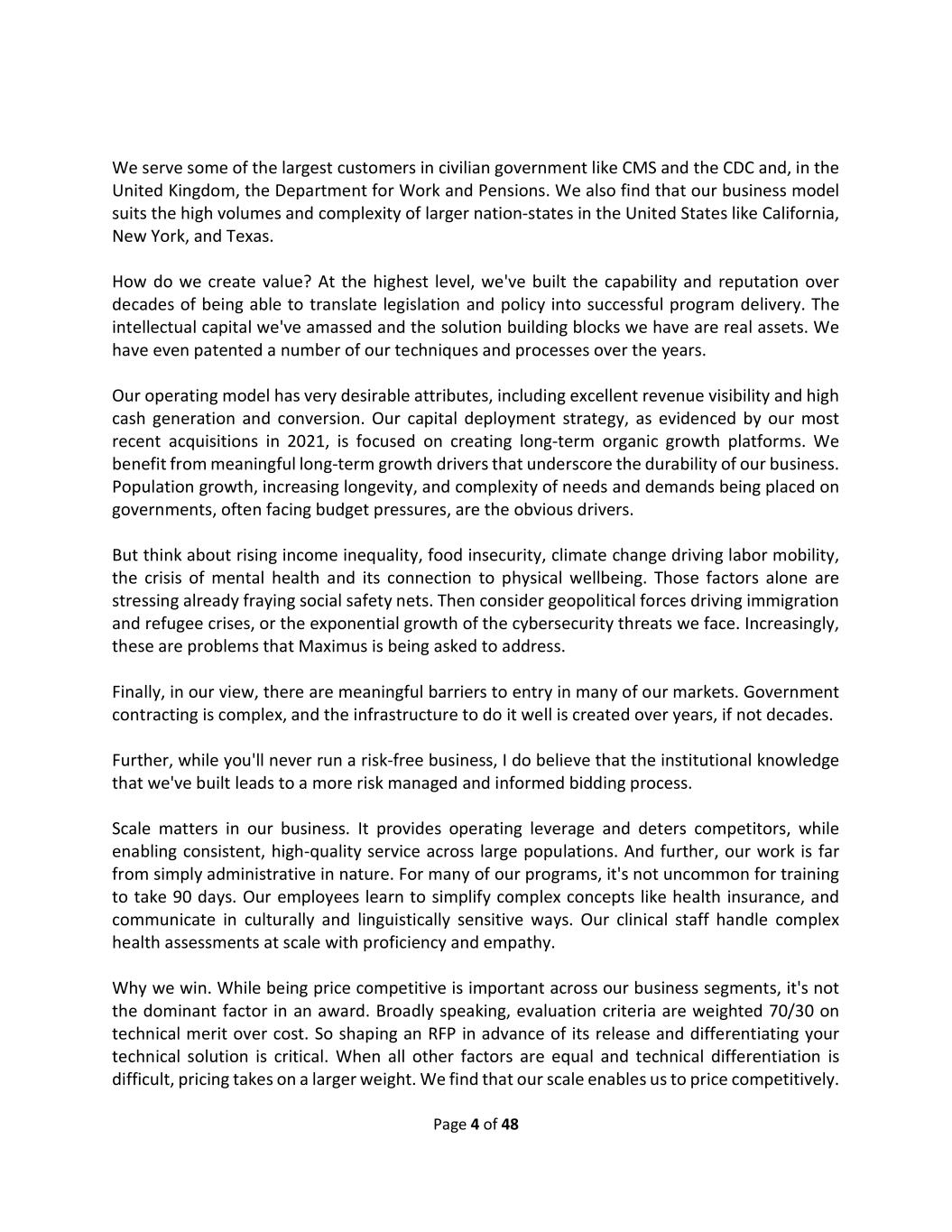
Page 4 of 48 We serve some of the largest customers in civilian government like CMS and the CDC and, in the United Kingdom, the Department for Work and Pensions. We also find that our business model suits the high volumes and complexity of larger nation-states in the United States like California, New York, and Texas. How do we create value? At the highest level, we've built the capability and reputation over decades of being able to translate legislation and policy into successful program delivery. The intellectual capital we've amassed and the solution building blocks we have are real assets. We have even patented a number of our techniques and processes over the years. Our operating model has very desirable attributes, including excellent revenue visibility and high cash generation and conversion. Our capital deployment strategy, as evidenced by our most recent acquisitions in 2021, is focused on creating long-term organic growth platforms. We benefit from meaningful long-term growth drivers that underscore the durability of our business. Population growth, increasing longevity, and complexity of needs and demands being placed on governments, often facing budget pressures, are the obvious drivers. But think about rising income inequality, food insecurity, climate change driving labor mobility, the crisis of mental health and its connection to physical wellbeing. Those factors alone are stressing already fraying social safety nets. Then consider geopolitical forces driving immigration and refugee crises, or the exponential growth of the cybersecurity threats we face. Increasingly, these are problems that Maximus is being asked to address. Finally, in our view, there are meaningful barriers to entry in many of our markets. Government contracting is complex, and the infrastructure to do it well is created over years, if not decades. Further, while you'll never run a risk-free business, I do believe that the institutional knowledge that we've built leads to a more risk managed and informed bidding process. Scale matters in our business. It provides operating leverage and deters competitors, while enabling consistent, high-quality service across large populations. And further, our work is far from simply administrative in nature. For many of our programs, it's not uncommon for training to take 90 days. Our employees learn to simplify complex concepts like health insurance, and communicate in culturally and linguistically sensitive ways. Our clinical staff handle complex health assessments at scale with proficiency and empathy. Why we win. While being price competitive is important across our business segments, it's not the dominant factor in an award. Broadly speaking, evaluation criteria are weighted 70/30 on technical merit over cost. So shaping an RFP in advance of its release and differentiating your technical solution is critical. When all other factors are equal and technical differentiation is difficult, pricing takes on a larger weight. We find that our scale enables us to price competitively.
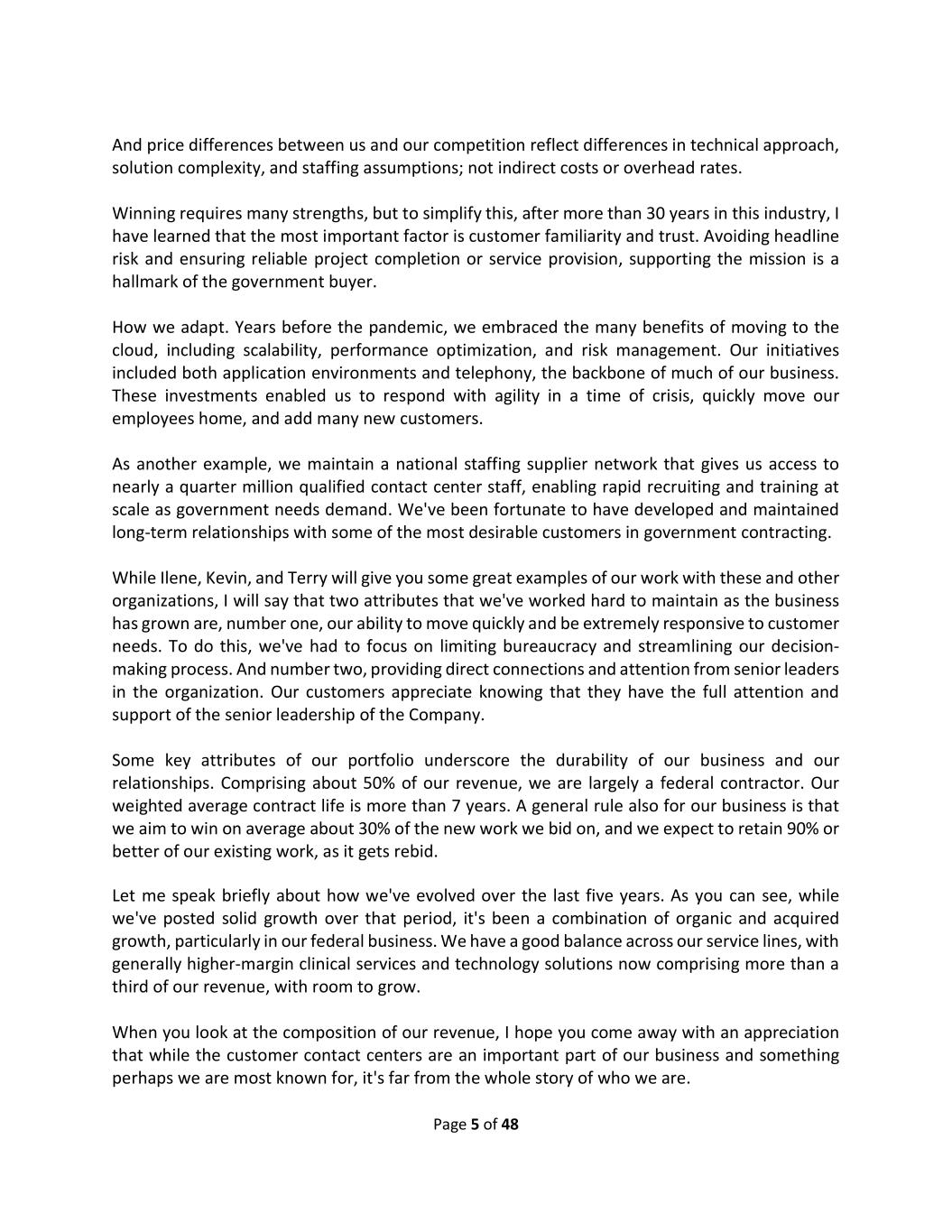
Page 5 of 48 And price differences between us and our competition reflect differences in technical approach, solution complexity, and staffing assumptions; not indirect costs or overhead rates. Winning requires many strengths, but to simplify this, after more than 30 years in this industry, I have learned that the most important factor is customer familiarity and trust. Avoiding headline risk and ensuring reliable project completion or service provision, supporting the mission is a hallmark of the government buyer. How we adapt. Years before the pandemic, we embraced the many benefits of moving to the cloud, including scalability, performance optimization, and risk management. Our initiatives included both application environments and telephony, the backbone of much of our business. These investments enabled us to respond with agility in a time of crisis, quickly move our employees home, and add many new customers. As another example, we maintain a national staffing supplier network that gives us access to nearly a quarter million qualified contact center staff, enabling rapid recruiting and training at scale as government needs demand. We've been fortunate to have developed and maintained long-term relationships with some of the most desirable customers in government contracting. While Ilene, Kevin, and Terry will give you some great examples of our work with these and other organizations, I will say that two attributes that we've worked hard to maintain as the business has grown are, number one, our ability to move quickly and be extremely responsive to customer needs. To do this, we've had to focus on limiting bureaucracy and streamlining our decision- making process. And number two, providing direct connections and attention from senior leaders in the organization. Our customers appreciate knowing that they have the full attention and support of the senior leadership of the Company. Some key attributes of our portfolio underscore the durability of our business and our relationships. Comprising about 50% of our revenue, we are largely a federal contractor. Our weighted average contract life is more than 7 years. A general rule also for our business is that we aim to win on average about 30% of the new work we bid on, and we expect to retain 90% or better of our existing work, as it gets rebid. Let me speak briefly about how we've evolved over the last five years. As you can see, while we've posted solid growth over that period, it's been a combination of organic and acquired growth, particularly in our federal business. We have a good balance across our service lines, with generally higher-margin clinical services and technology solutions now comprising more than a third of our revenue, with room to grow. When you look at the composition of our revenue, I hope you come away with an appreciation that while the customer contact centers are an important part of our business and something perhaps we are most known for, it's far from the whole story of who we are.
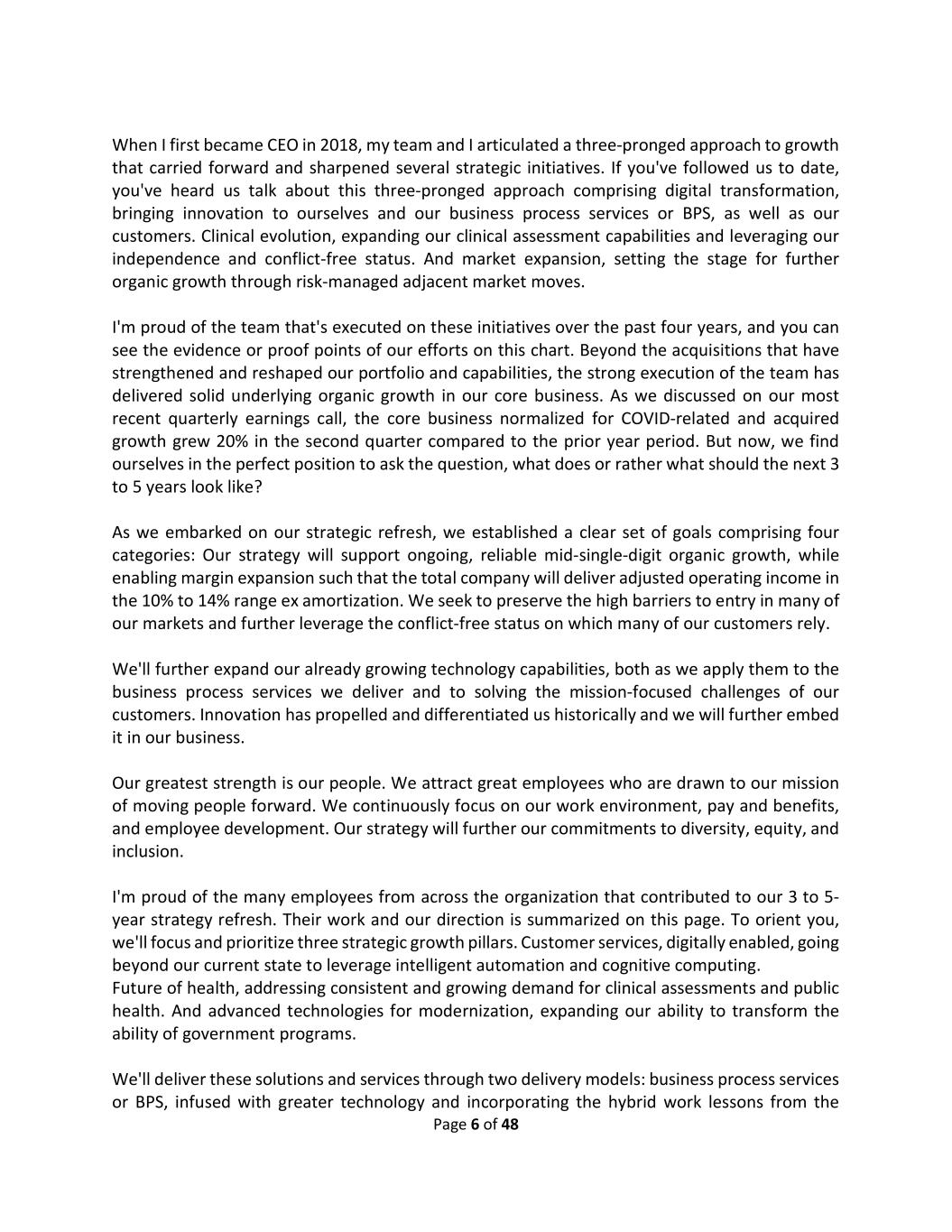
Page 6 of 48 When I first became CEO in 2018, my team and I articulated a three-pronged approach to growth that carried forward and sharpened several strategic initiatives. If you've followed us to date, you've heard us talk about this three-pronged approach comprising digital transformation, bringing innovation to ourselves and our business process services or BPS, as well as our customers. Clinical evolution, expanding our clinical assessment capabilities and leveraging our independence and conflict-free status. And market expansion, setting the stage for further organic growth through risk-managed adjacent market moves. I'm proud of the team that's executed on these initiatives over the past four years, and you can see the evidence or proof points of our efforts on this chart. Beyond the acquisitions that have strengthened and reshaped our portfolio and capabilities, the strong execution of the team has delivered solid underlying organic growth in our core business. As we discussed on our most recent quarterly earnings call, the core business normalized for COVID-related and acquired growth grew 20% in the second quarter compared to the prior year period. But now, we find ourselves in the perfect position to ask the question, what does or rather what should the next 3 to 5 years look like? As we embarked on our strategic refresh, we established a clear set of goals comprising four categories: Our strategy will support ongoing, reliable mid-single-digit organic growth, while enabling margin expansion such that the total company will deliver adjusted operating income in the 10% to 14% range ex amortization. We seek to preserve the high barriers to entry in many of our markets and further leverage the conflict-free status on which many of our customers rely. We'll further expand our already growing technology capabilities, both as we apply them to the business process services we deliver and to solving the mission-focused challenges of our customers. Innovation has propelled and differentiated us historically and we will further embed it in our business. Our greatest strength is our people. We attract great employees who are drawn to our mission of moving people forward. We continuously focus on our work environment, pay and benefits, and employee development. Our strategy will further our commitments to diversity, equity, and inclusion. I'm proud of the many employees from across the organization that contributed to our 3 to 5- year strategy refresh. Their work and our direction is summarized on this page. To orient you, we'll focus and prioritize three strategic growth pillars. Customer services, digitally enabled, going beyond our current state to leverage intelligent automation and cognitive computing. Future of health, addressing consistent and growing demand for clinical assessments and public health. And advanced technologies for modernization, expanding our ability to transform the ability of government programs. We'll deliver these solutions and services through two delivery models: business process services or BPS, infused with greater technology and incorporating the hybrid work lessons from the
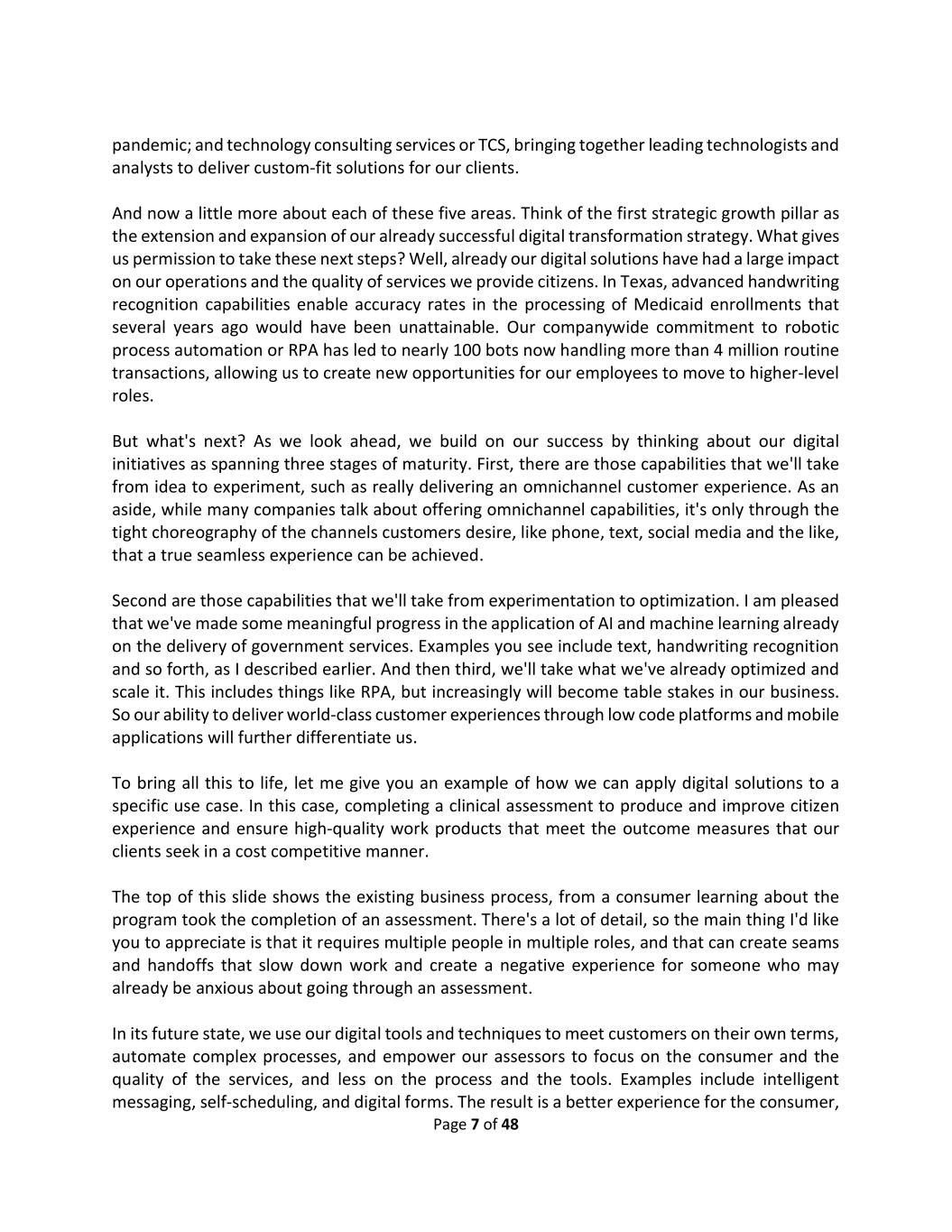
Page 7 of 48 pandemic; and technology consulting services or TCS, bringing together leading technologists and analysts to deliver custom-fit solutions for our clients. And now a little more about each of these five areas. Think of the first strategic growth pillar as the extension and expansion of our already successful digital transformation strategy. What gives us permission to take these next steps? Well, already our digital solutions have had a large impact on our operations and the quality of services we provide citizens. In Texas, advanced handwriting recognition capabilities enable accuracy rates in the processing of Medicaid enrollments that several years ago would have been unattainable. Our companywide commitment to robotic process automation or RPA has led to nearly 100 bots now handling more than 4 million routine transactions, allowing us to create new opportunities for our employees to move to higher-level roles. But what's next? As we look ahead, we build on our success by thinking about our digital initiatives as spanning three stages of maturity. First, there are those capabilities that we'll take from idea to experiment, such as really delivering an omnichannel customer experience. As an aside, while many companies talk about offering omnichannel capabilities, it's only through the tight choreography of the channels customers desire, like phone, text, social media and the like, that a true seamless experience can be achieved. Second are those capabilities that we'll take from experimentation to optimization. I am pleased that we've made some meaningful progress in the application of AI and machine learning already on the delivery of government services. Examples you see include text, handwriting recognition and so forth, as I described earlier. And then third, we'll take what we've already optimized and scale it. This includes things like RPA, but increasingly will become table stakes in our business. So our ability to deliver world-class customer experiences through low code platforms and mobile applications will further differentiate us. To bring all this to life, let me give you an example of how we can apply digital solutions to a specific use case. In this case, completing a clinical assessment to produce and improve citizen experience and ensure high-quality work products that meet the outcome measures that our clients seek in a cost competitive manner. The top of this slide shows the existing business process, from a consumer learning about the program took the completion of an assessment. There's a lot of detail, so the main thing I'd like you to appreciate is that it requires multiple people in multiple roles, and that can create seams and handoffs that slow down work and create a negative experience for someone who may already be anxious about going through an assessment. In its future state, we use our digital tools and techniques to meet customers on their own terms, automate complex processes, and empower our assessors to focus on the consumer and the quality of the services, and less on the process and the tools. Examples include intelligent messaging, self-scheduling, and digital forms. The result is a better experience for the consumer,
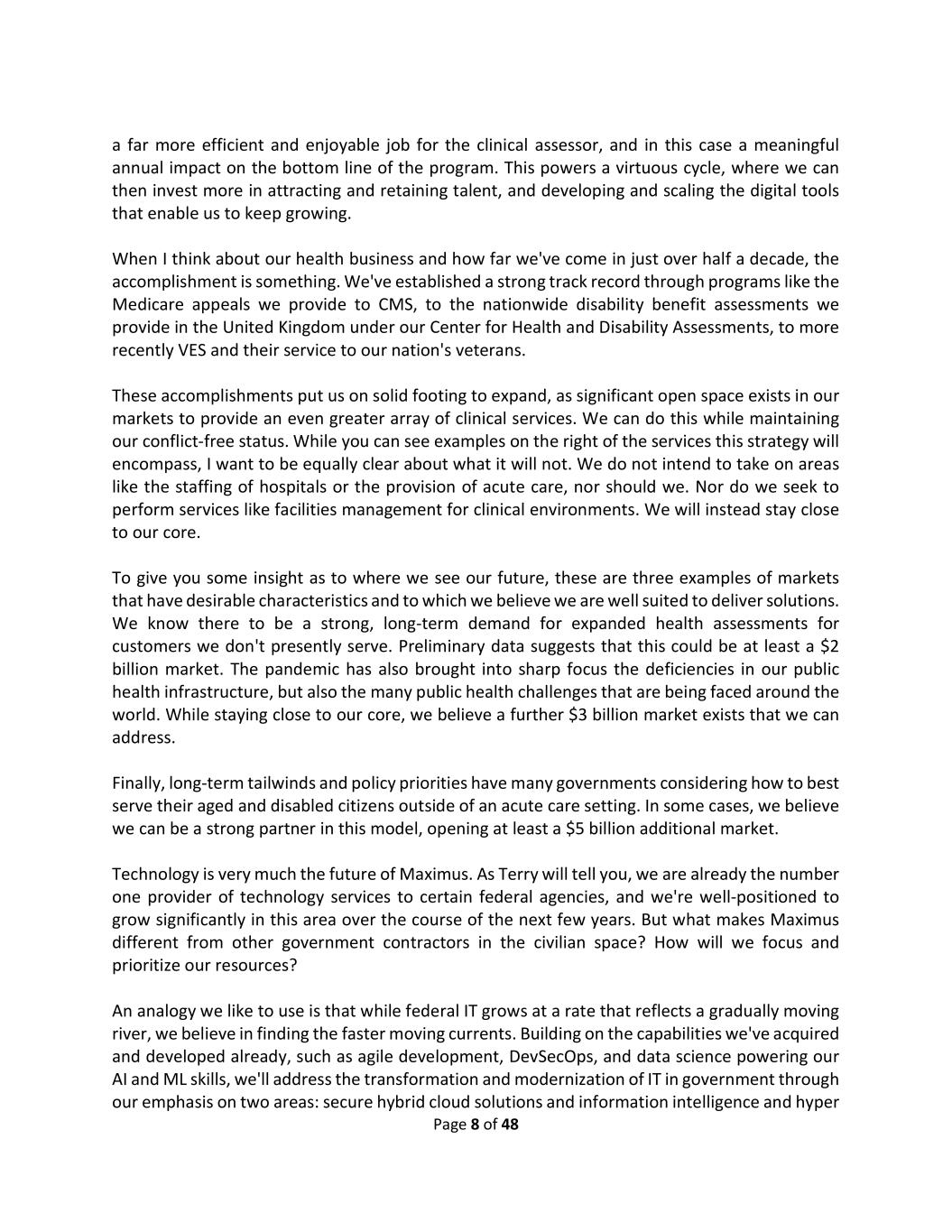
Page 8 of 48 a far more efficient and enjoyable job for the clinical assessor, and in this case a meaningful annual impact on the bottom line of the program. This powers a virtuous cycle, where we can then invest more in attracting and retaining talent, and developing and scaling the digital tools that enable us to keep growing. When I think about our health business and how far we've come in just over half a decade, the accomplishment is something. We've established a strong track record through programs like the Medicare appeals we provide to CMS, to the nationwide disability benefit assessments we provide in the United Kingdom under our Center for Health and Disability Assessments, to more recently VES and their service to our nation's veterans. These accomplishments put us on solid footing to expand, as significant open space exists in our markets to provide an even greater array of clinical services. We can do this while maintaining our conflict-free status. While you can see examples on the right of the services this strategy will encompass, I want to be equally clear about what it will not. We do not intend to take on areas like the staffing of hospitals or the provision of acute care, nor should we. Nor do we seek to perform services like facilities management for clinical environments. We will instead stay close to our core. To give you some insight as to where we see our future, these are three examples of markets that have desirable characteristics and to which we believe we are well suited to deliver solutions. We know there to be a strong, long-term demand for expanded health assessments for customers we don't presently serve. Preliminary data suggests that this could be at least a $2 billion market. The pandemic has also brought into sharp focus the deficiencies in our public health infrastructure, but also the many public health challenges that are being faced around the world. While staying close to our core, we believe a further $3 billion market exists that we can address. Finally, long-term tailwinds and policy priorities have many governments considering how to best serve their aged and disabled citizens outside of an acute care setting. In some cases, we believe we can be a strong partner in this model, opening at least a $5 billion additional market. Technology is very much the future of Maximus. As Terry will tell you, we are already the number one provider of technology services to certain federal agencies, and we're well-positioned to grow significantly in this area over the course of the next few years. But what makes Maximus different from other government contractors in the civilian space? How will we focus and prioritize our resources? An analogy we like to use is that while federal IT grows at a rate that reflects a gradually moving river, we believe in finding the faster moving currents. Building on the capabilities we've acquired and developed already, such as agile development, DevSecOps, and data science powering our AI and ML skills, we'll address the transformation and modernization of IT in government through our emphasis on two areas: secure hybrid cloud solutions and information intelligence and hyper
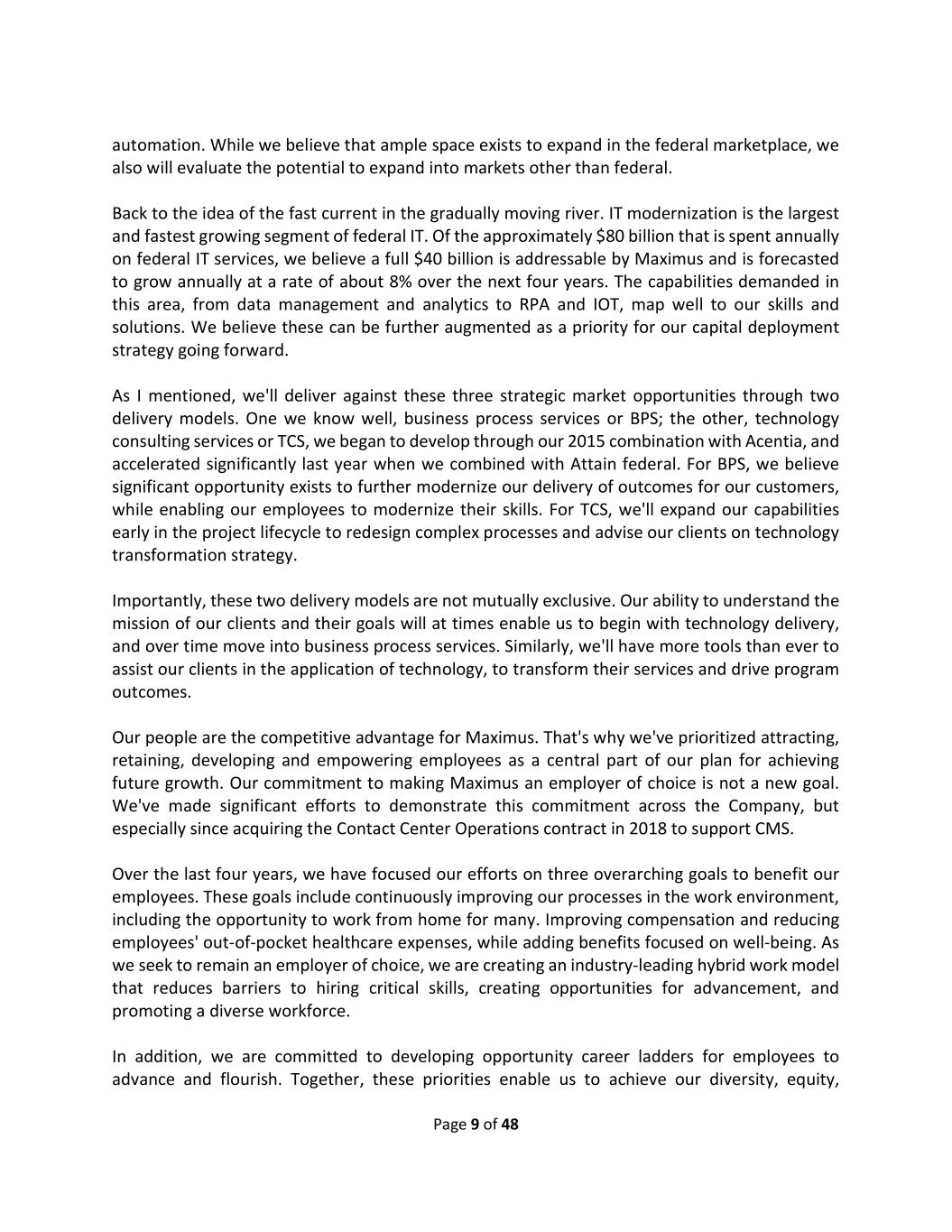
Page 9 of 48 automation. While we believe that ample space exists to expand in the federal marketplace, we also will evaluate the potential to expand into markets other than federal. Back to the idea of the fast current in the gradually moving river. IT modernization is the largest and fastest growing segment of federal IT. Of the approximately $80 billion that is spent annually on federal IT services, we believe a full $40 billion is addressable by Maximus and is forecasted to grow annually at a rate of about 8% over the next four years. The capabilities demanded in this area, from data management and analytics to RPA and IOT, map well to our skills and solutions. We believe these can be further augmented as a priority for our capital deployment strategy going forward. As I mentioned, we'll deliver against these three strategic market opportunities through two delivery models. One we know well, business process services or BPS; the other, technology consulting services or TCS, we began to develop through our 2015 combination with Acentia, and accelerated significantly last year when we combined with Attain federal. For BPS, we believe significant opportunity exists to further modernize our delivery of outcomes for our customers, while enabling our employees to modernize their skills. For TCS, we'll expand our capabilities early in the project lifecycle to redesign complex processes and advise our clients on technology transformation strategy. Importantly, these two delivery models are not mutually exclusive. Our ability to understand the mission of our clients and their goals will at times enable us to begin with technology delivery, and over time move into business process services. Similarly, we'll have more tools than ever to assist our clients in the application of technology, to transform their services and drive program outcomes. Our people are the competitive advantage for Maximus. That's why we've prioritized attracting, retaining, developing and empowering employees as a central part of our plan for achieving future growth. Our commitment to making Maximus an employer of choice is not a new goal. We've made significant efforts to demonstrate this commitment across the Company, but especially since acquiring the Contact Center Operations contract in 2018 to support CMS. Over the last four years, we have focused our efforts on three overarching goals to benefit our employees. These goals include continuously improving our processes in the work environment, including the opportunity to work from home for many. Improving compensation and reducing employees' out-of-pocket healthcare expenses, while adding benefits focused on well-being. As we seek to remain an employer of choice, we are creating an industry-leading hybrid work model that reduces barriers to hiring critical skills, creating opportunities for advancement, and promoting a diverse workforce. In addition, we are committed to developing opportunity career ladders for employees to advance and flourish. Together, these priorities enable us to achieve our diversity, equity,

Page 10 of 48 inclusion and representation goals, and to enrich our already strong culture to build upon the strengths that differentiate us. Maximus, over nearly 50 years, has developed to become a critical partner to government in delivering some of its most essential citizen services. This role was underscored most recently during the pandemic, which also illustrated the complexity of challenges facing government. Our track record of successful execution, desirable business model, and meaningful barriers to entry in many areas of our business uniquely position us to capitalize on the opportunities for growth that lie ahead. Indeed, our strategy positions the Company to operate in an expanded addressable market of more than $150 billion, growing at 6% over the next 3 to 5 years. We are fortunate to operate in a very strong macroenvironment, creating tailwinds that are decades long. At the same time, we are agile, we adapt, and we are disciplined. Our execution to date has equipped us with market-leading business process services, while our technology capabilities, delivered through our services and now directly in support of our customers' mission, are focused on areas of great need and high priority. In our view, the role of a private partner like Maximus is and will continue to be interlinked with the role of government itself well into the future. We are fortunate to be positioned as we are, and at the same time, sharply focused on where we are going. This is the team that well take us there. And with that, I'll turn it over to Terry. Teresa Weipert Thank you, Bruce, and good morning. As a newer member of the management team, I thought I should share a little bit about my experience with companies like Unisys, Accenture, IBM and a few others. I have a broad understanding of our federal market, and I know how to build the businesses and manage several of our critical client relationships. It's such an exciting time to be at Maximus, not only with the new strategy that's being presented to you, but also the passion that we have for moving people forward, our clients and our people. But let's take you to a couple key messages today and what I'm going to talk about. First of all, a little bit about the history and the successful growth trajectory here at Maximus; a retention of our current business, how critical that is and how important those relationships are to us; and how we're positioned well for the future. We're a trusted partner in the federal community with agencies, with technology partners, with the small business community, and we have a team that is focused on growth. So let's talk a little bit about the history of Maximus federal and where we've come from. We've grown from, in FY ‘10, from $80 million to $2.2 billion. And how have we done that? The growth trajectory builds on the clients that we have and the excellent M&A strategy that has been executed over the last year. We have quite a bit of experience in the whole lifecycle of legacy modernization that our clients require, and we have a powerful combination of customer experience and technology solutions.

Page 11 of 48 I wanted to talk a little bit about the $2.2 billion and where this is coming from with our current contracts, with our clinical and health contracts, and with several IT contracts, and then with the acquisition. The acquisitions of Attain, VES, and innovation of the student loan contract. We are successfully delivering on these contracts today, and they've contributed to our growth. With the Veterans Evaluation Services, which we refer to as VES, this contract delivers important medical benefit examinations for veterans. And this is due to grow because of some changes that are coming up in the current legislative actions, and also with the direction that VA is going. We are well positioned with VA on this program, and we look forward to the continued success of this program. With Attain, we've built a foundation in our technology consulting services area, and we intend to continue to grow that. I'll talk a little bit more about that and how that intersects so nicely with our business process services that we deliver today. We're a leading solution provider, as we've stated, to federal government agencies with a full service of capabilities and credentials, both centered around customer contact center solutions which were refer often as omnichannel type solutions; clinical health which includes health assessments, exams, health and medical insurance appeals and reviews, quality control and oversight, and expansion of other businesses in the healthcare area. And I'm going to give you a couple examples of that in a few moments. In IT modernization and cybersecurity, this is really our technology and consulting practice. We maintain, modernize, and protect mission-critical and new actually innovation -- innovative IT solutions for our clients today. We're aligned to the government priorities, which is very important in our market, and are spoken about often. The federal CIO recently came out with a report and identified their three top priorities: cybersecurity, IT modernization, and customer service and customer experience, which is actually an executive order. In meeting some of the agency challenges that we have today, we're in at the IRS, which I'm going to talk about actually in more detail in just a moment; federal student aid where we are improving the borrower experience; and the Security and Exchange Commission with a system which you all will be familiar with called EDGAR. The U.S. federal market is an established and well aligned -- and we are well aligned to support the mission and priorities in federal health, civilian, and in the Department of Defense. One thing I wanted to make a comment about in this particular market is that laws, policy, agency budget, contract spending, all critical and all very important as we understand the mission. Not only do we understand the technology and the things that we must deliver to our client, but we understand what the outcome needs to be, and this makes us well positioned for growth in this market.
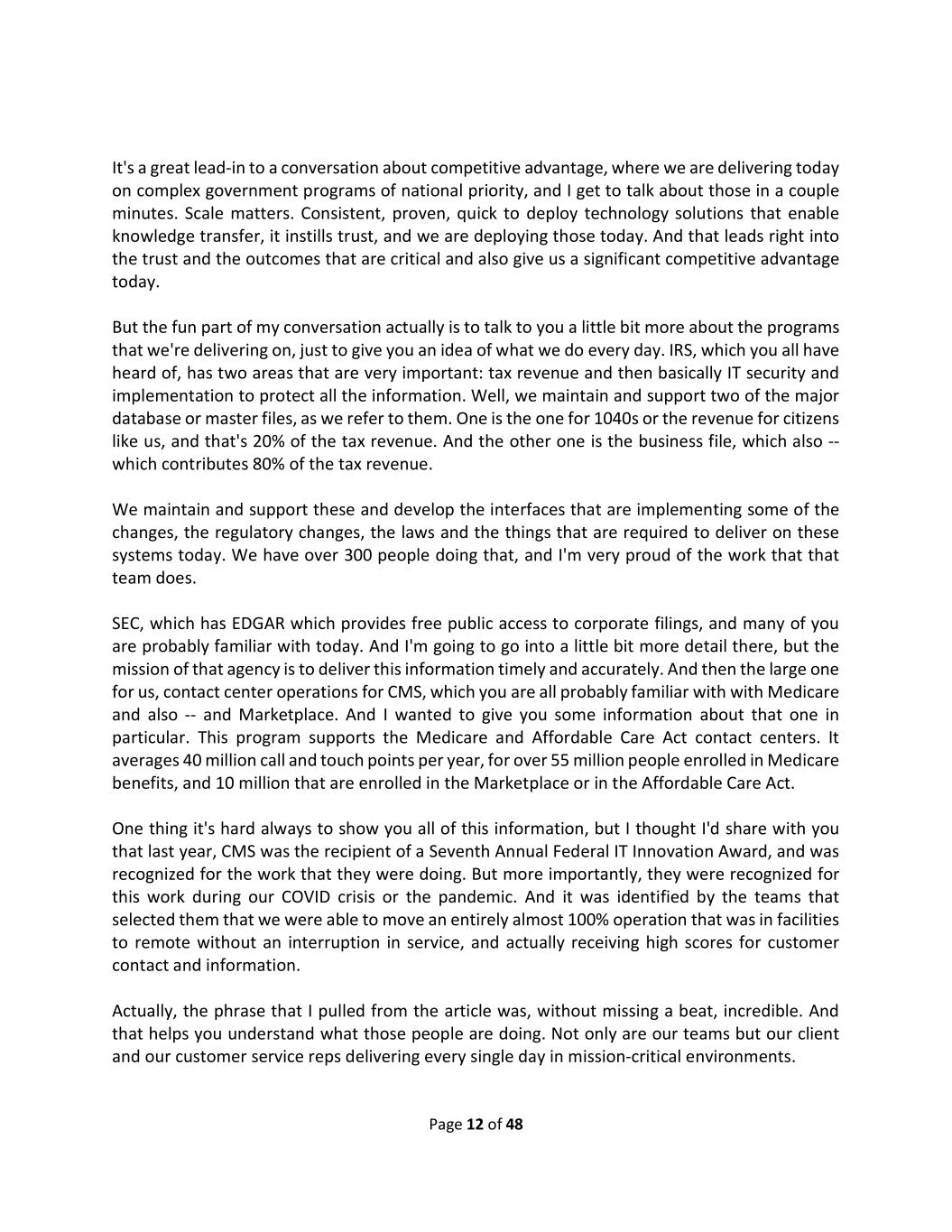
Page 12 of 48 It's a great lead-in to a conversation about competitive advantage, where we are delivering today on complex government programs of national priority, and I get to talk about those in a couple minutes. Scale matters. Consistent, proven, quick to deploy technology solutions that enable knowledge transfer, it instills trust, and we are deploying those today. And that leads right into the trust and the outcomes that are critical and also give us a significant competitive advantage today. But the fun part of my conversation actually is to talk to you a little bit more about the programs that we're delivering on, just to give you an idea of what we do every day. IRS, which you all have heard of, has two areas that are very important: tax revenue and then basically IT security and implementation to protect all the information. Well, we maintain and support two of the major database or master files, as we refer to them. One is the one for 1040s or the revenue for citizens like us, and that's 20% of the tax revenue. And the other one is the business file, which also -- which contributes 80% of the tax revenue. We maintain and support these and develop the interfaces that are implementing some of the changes, the regulatory changes, the laws and the things that are required to deliver on these systems today. We have over 300 people doing that, and I'm very proud of the work that that team does. SEC, which has EDGAR which provides free public access to corporate filings, and many of you are probably familiar with today. And I'm going to go into a little bit more detail there, but the mission of that agency is to deliver this information timely and accurately. And then the large one for us, contact center operations for CMS, which you are all probably familiar with with Medicare and also -- and Marketplace. And I wanted to give you some information about that one in particular. This program supports the Medicare and Affordable Care Act contact centers. It averages 40 million call and touch points per year, for over 55 million people enrolled in Medicare benefits, and 10 million that are enrolled in the Marketplace or in the Affordable Care Act. One thing it's hard always to show you all of this information, but I thought I'd share with you that last year, CMS was the recipient of a Seventh Annual Federal IT Innovation Award, and was recognized for the work that they were doing. But more importantly, they were recognized for this work during our COVID crisis or the pandemic. And it was identified by the teams that selected them that we were able to move an entirely almost 100% operation that was in facilities to remote without an interruption in service, and actually receiving high scores for customer contact and information. Actually, the phrase that I pulled from the article was, without missing a beat, incredible. And that helps you understand what those people are doing. Not only are our teams but our client and our customer service reps delivering every single day in mission-critical environments.
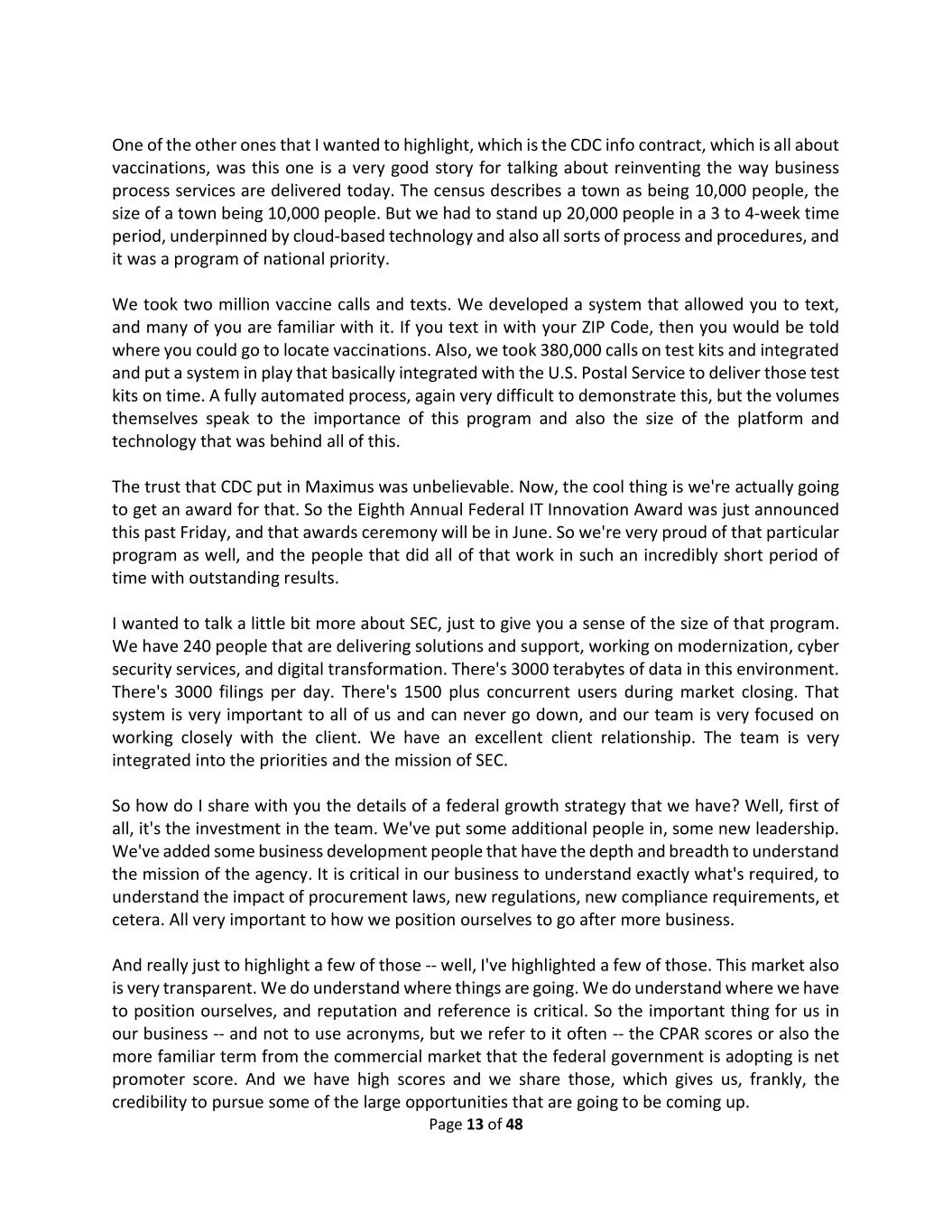
Page 13 of 48 One of the other ones that I wanted to highlight, which is the CDC info contract, which is all about vaccinations, was this one is a very good story for talking about reinventing the way business process services are delivered today. The census describes a town as being 10,000 people, the size of a town being 10,000 people. But we had to stand up 20,000 people in a 3 to 4-week time period, underpinned by cloud-based technology and also all sorts of process and procedures, and it was a program of national priority. We took two million vaccine calls and texts. We developed a system that allowed you to text, and many of you are familiar with it. If you text in with your ZIP Code, then you would be told where you could go to locate vaccinations. Also, we took 380,000 calls on test kits and integrated and put a system in play that basically integrated with the U.S. Postal Service to deliver those test kits on time. A fully automated process, again very difficult to demonstrate this, but the volumes themselves speak to the importance of this program and also the size of the platform and technology that was behind all of this. The trust that CDC put in Maximus was unbelievable. Now, the cool thing is we're actually going to get an award for that. So the Eighth Annual Federal IT Innovation Award was just announced this past Friday, and that awards ceremony will be in June. So we're very proud of that particular program as well, and the people that did all of that work in such an incredibly short period of time with outstanding results. I wanted to talk a little bit more about SEC, just to give you a sense of the size of that program. We have 240 people that are delivering solutions and support, working on modernization, cyber security services, and digital transformation. There's 3000 terabytes of data in this environment. There's 3000 filings per day. There's 1500 plus concurrent users during market closing. That system is very important to all of us and can never go down, and our team is very focused on working closely with the client. We have an excellent client relationship. The team is very integrated into the priorities and the mission of SEC. So how do I share with you the details of a federal growth strategy that we have? Well, first of all, it's the investment in the team. We've put some additional people in, some new leadership. We've added some business development people that have the depth and breadth to understand the mission of the agency. It is critical in our business to understand exactly what's required, to understand the impact of procurement laws, new regulations, new compliance requirements, et cetera. All very important to how we position ourselves to go after more business. And really just to highlight a few of those -- well, I've highlighted a few of those. This market also is very transparent. We do understand where things are going. We do understand where we have to position ourselves, and reputation and reference is critical. So the important thing for us in our business -- and not to use acronyms, but we refer to it often -- the CPAR scores or also the more familiar term from the commercial market that the federal government is adopting is net promoter score. And we have high scores and we share those, which gives us, frankly, the credibility to pursue some of the large opportunities that are going to be coming up.
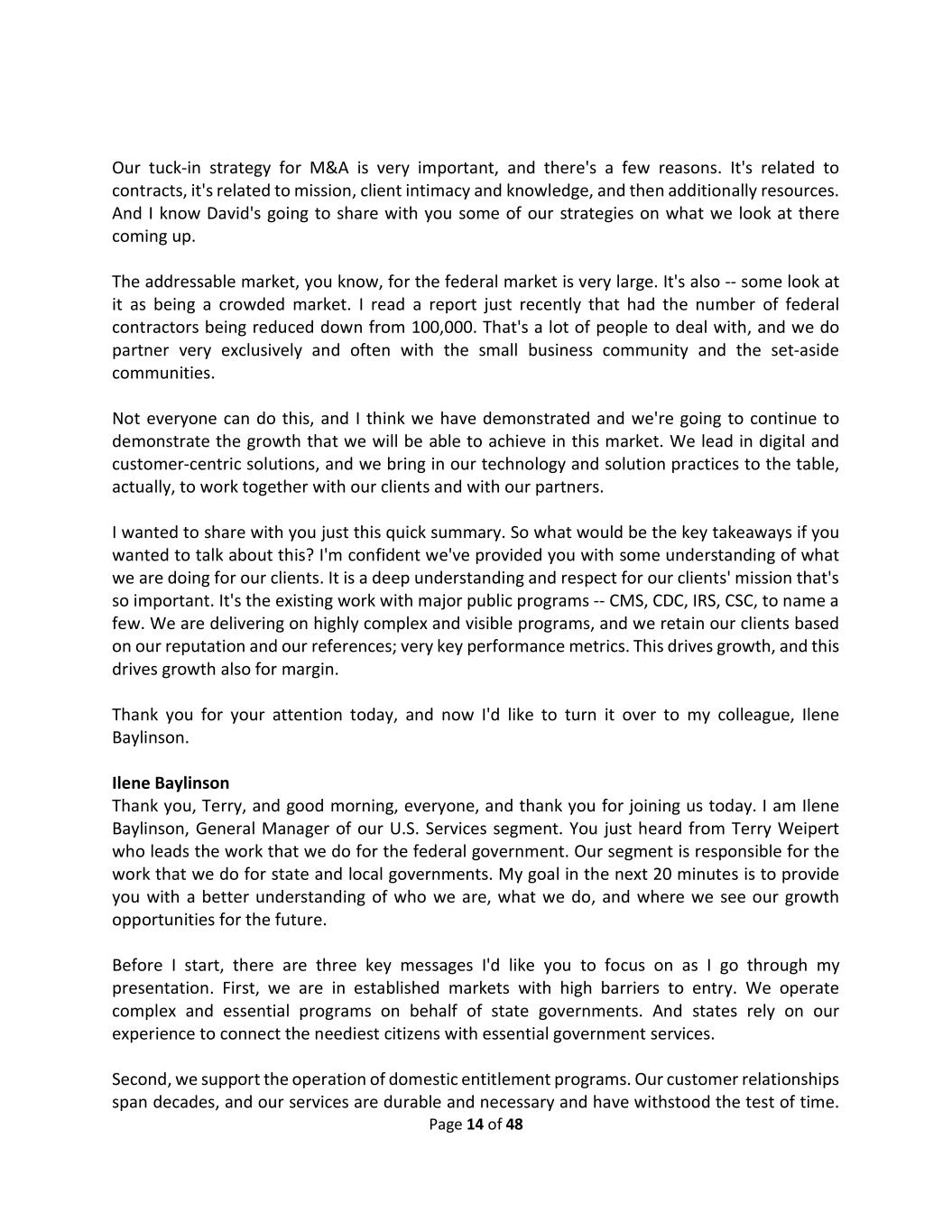
Page 14 of 48 Our tuck-in strategy for M&A is very important, and there's a few reasons. It's related to contracts, it's related to mission, client intimacy and knowledge, and then additionally resources. And I know David's going to share with you some of our strategies on what we look at there coming up. The addressable market, you know, for the federal market is very large. It's also -- some look at it as being a crowded market. I read a report just recently that had the number of federal contractors being reduced down from 100,000. That's a lot of people to deal with, and we do partner very exclusively and often with the small business community and the set-aside communities. Not everyone can do this, and I think we have demonstrated and we're going to continue to demonstrate the growth that we will be able to achieve in this market. We lead in digital and customer-centric solutions, and we bring in our technology and solution practices to the table, actually, to work together with our clients and with our partners. I wanted to share with you just this quick summary. So what would be the key takeaways if you wanted to talk about this? I'm confident we've provided you with some understanding of what we are doing for our clients. It is a deep understanding and respect for our clients' mission that's so important. It's the existing work with major public programs -- CMS, CDC, IRS, CSC, to name a few. We are delivering on highly complex and visible programs, and we retain our clients based on our reputation and our references; very key performance metrics. This drives growth, and this drives growth also for margin. Thank you for your attention today, and now I'd like to turn it over to my colleague, Ilene Baylinson. Ilene Baylinson Thank you, Terry, and good morning, everyone, and thank you for joining us today. I am Ilene Baylinson, General Manager of our U.S. Services segment. You just heard from Terry Weipert who leads the work that we do for the federal government. Our segment is responsible for the work that we do for state and local governments. My goal in the next 20 minutes is to provide you with a better understanding of who we are, what we do, and where we see our growth opportunities for the future. Before I start, there are three key messages I'd like you to focus on as I go through my presentation. First, we are in established markets with high barriers to entry. We operate complex and essential programs on behalf of state governments. And states rely on our experience to connect the neediest citizens with essential government services. Second, we support the operation of domestic entitlement programs. Our customer relationships span decades, and our services are durable and necessary and have withstood the test of time.

Page 15 of 48 And third, our markets are growing and maturing. Today, I'm going to focus on two growth opportunities. The first is clinical assessments and the second is technology solutions, both of which Bruce outlined as key pillars for our future Maximus growth. So, who are we? We are one of the leading providers of Health and Human Services programs for state government agencies. At the highest level, we connect the neediest citizens with essential government services. States have neither the flexibility nor the resources to deliver these services efficiently, so they contract with Maximus to design and deliver those services on their behalf, with the expectation that we will perform them more efficiently, with greater flexibility, and at greater scale than states could do themselves. The services we provide can be organized into three overall categories. The first category is business process services or BPS. These services primarily support the operation of large government programs. As an example, if you live in one of 18 states and want to apply for Medicaid services, you'll speak to a Maximus employee about choosing the health plan that's right for you and your family. Similarly, if you live in one of six states around the country and you want to purchase insurance on any of those states' health exchanges, you'll also speak to a Maximus employee to determine which of the many health insurance options are right for you. We also help states provide child care, job placement and training, unemployment support, and services for the elderly and for the homeless. We help consumers navigate the maze of government services, and we help ensure that citizens are receiving the services that they need. The second category of services is clinical assessments. We service the independent, unbiased organization, helping states evaluate both the type and level of service that consumers need. As an example, if you're elderly and frail and you live in either Pennsylvania or New York, and you want to receive services in your home instead of going into a nursing facility, a Maximus assessor will evaluate your needs. That assessor will determine if you can dress yourself, if you can bathe yourself, if you can navigate stairs or take your proper medications. We'll also determine the specific services that you need, such as personal care services or transportation services or medication management. And we'll determine how frequently you need those services. The third category of services is technology solutions, and this is the newest category of services that we're offering states. We currently build technology primarily to support and enhance our business operations. States are now placing a much greater focus on using technology to both improve customer satisfaction as well as to lower-cost. For example, if you had wanted to apply for health insurance in New York years ago, you would have walked into a local eligibility office and applied there in person. Today, if you want to purchase insurance on New York's health exchange that Maximus operates, you could call one of our many customer service representatives who could help you apply the phone, or go online to the web portal and apply there, or communicate with one of our employees through chat, or use

Page 16 of 48 your mobile app to upload documents, or you could email or text us questions. Or if you're old school, we will still accept faxes and paper documents as well. States want vendors to not only supply the people, but also the underlying technology and the digital solutions to support their programs. So we continue to see new and expanding opportunities in each of these three overall market areas. Next, I want to talk about how we differentiate ourselves from the competition. Our markets are competitive, and many vendors are interested in entering our space. So why do our customers continue to choose us decade after decade? First, our customers respect our experience. State leadership changes, as governors and administrations change. And as a result, the average tenure for a Medicaid director is only about 19 months. So states rely on us not only for our historical perspective, but also for our deep knowledge of their operations. We bring stability and continuity to an ever-changing client base. We also bring a deep understanding of state policy and regulation, which gives us an advantage over firms that have not operated before in the state marketplace. We are both a customer service arm and the public face of our state clients, but we are so much more. We serve as an agent of state government, helping states to run their day-to-day operations. The second reason why we stand out from among our competitors is that we can move quickly and at scale. We have over 11,000 customer service representatives across the country, and we scale up as much as 40% during surges, such as open enrollment. During COVID alone, we increased our hiring by over 85%. We stood up 29 programs, many in a matter of just weeks, yielding over $900 million in cumulative revenue. In FY ‘21 alone, we handled over 23 million calls over 66 different programs. We have the flexibility to do what our state clients can't do, and our reliability and our ability to do the impossible keeps clients coming back to Maximus year after year. The third reason that we remain competitive is that our customers trust us. We have supported 14 different state clients for more than 15 years, and we've worked with our three largest states -- California, Texas, and New York -- for over two decades each. We have a history of successful delivery, so our clients continue to extend and expand our contracts. Growth in our market is based upon experience, reliability, and trust. Now, let's take a look at our growth history. Our core services have expanded over the years as our Health and Human Services markets have grown. The U.S. Services segment is the oldest business segment at Maximus, and it operates some of our most well-established and flagship programs. In 1988, Los Angeles County outsourced the very first Welfare to Work program in the nation, and Maximus was the successful bidder on the contract. And that contract was the very first BPS contract at Maximus.
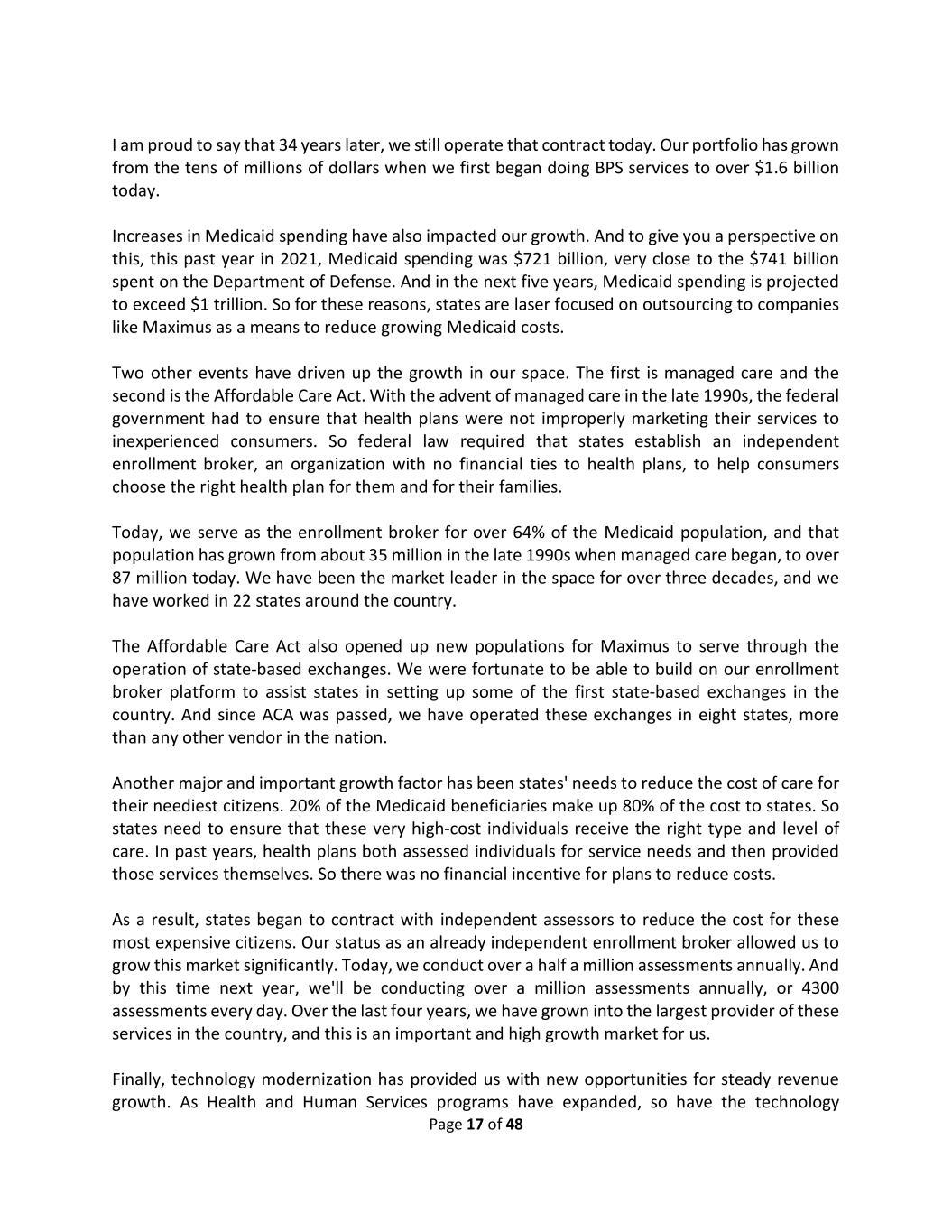
Page 17 of 48 I am proud to say that 34 years later, we still operate that contract today. Our portfolio has grown from the tens of millions of dollars when we first began doing BPS services to over $1.6 billion today. Increases in Medicaid spending have also impacted our growth. And to give you a perspective on this, this past year in 2021, Medicaid spending was $721 billion, very close to the $741 billion spent on the Department of Defense. And in the next five years, Medicaid spending is projected to exceed $1 trillion. So for these reasons, states are laser focused on outsourcing to companies like Maximus as a means to reduce growing Medicaid costs. Two other events have driven up the growth in our space. The first is managed care and the second is the Affordable Care Act. With the advent of managed care in the late 1990s, the federal government had to ensure that health plans were not improperly marketing their services to inexperienced consumers. So federal law required that states establish an independent enrollment broker, an organization with no financial ties to health plans, to help consumers choose the right health plan for them and for their families. Today, we serve as the enrollment broker for over 64% of the Medicaid population, and that population has grown from about 35 million in the late 1990s when managed care began, to over 87 million today. We have been the market leader in the space for over three decades, and we have worked in 22 states around the country. The Affordable Care Act also opened up new populations for Maximus to serve through the operation of state-based exchanges. We were fortunate to be able to build on our enrollment broker platform to assist states in setting up some of the first state-based exchanges in the country. And since ACA was passed, we have operated these exchanges in eight states, more than any other vendor in the nation. Another major and important growth factor has been states' needs to reduce the cost of care for their neediest citizens. 20% of the Medicaid beneficiaries make up 80% of the cost to states. So states need to ensure that these very high-cost individuals receive the right type and level of care. In past years, health plans both assessed individuals for service needs and then provided those services themselves. So there was no financial incentive for plans to reduce costs. As a result, states began to contract with independent assessors to reduce the cost for these most expensive citizens. Our status as an already independent enrollment broker allowed us to grow this market significantly. Today, we conduct over a half a million assessments annually. And by this time next year, we'll be conducting over a million assessments annually, or 4300 assessments every day. Over the last four years, we have grown into the largest provider of these services in the country, and this is an important and high growth market for us. Finally, technology modernization has provided us with new opportunities for steady revenue growth. As Health and Human Services programs have expanded, so have the technology
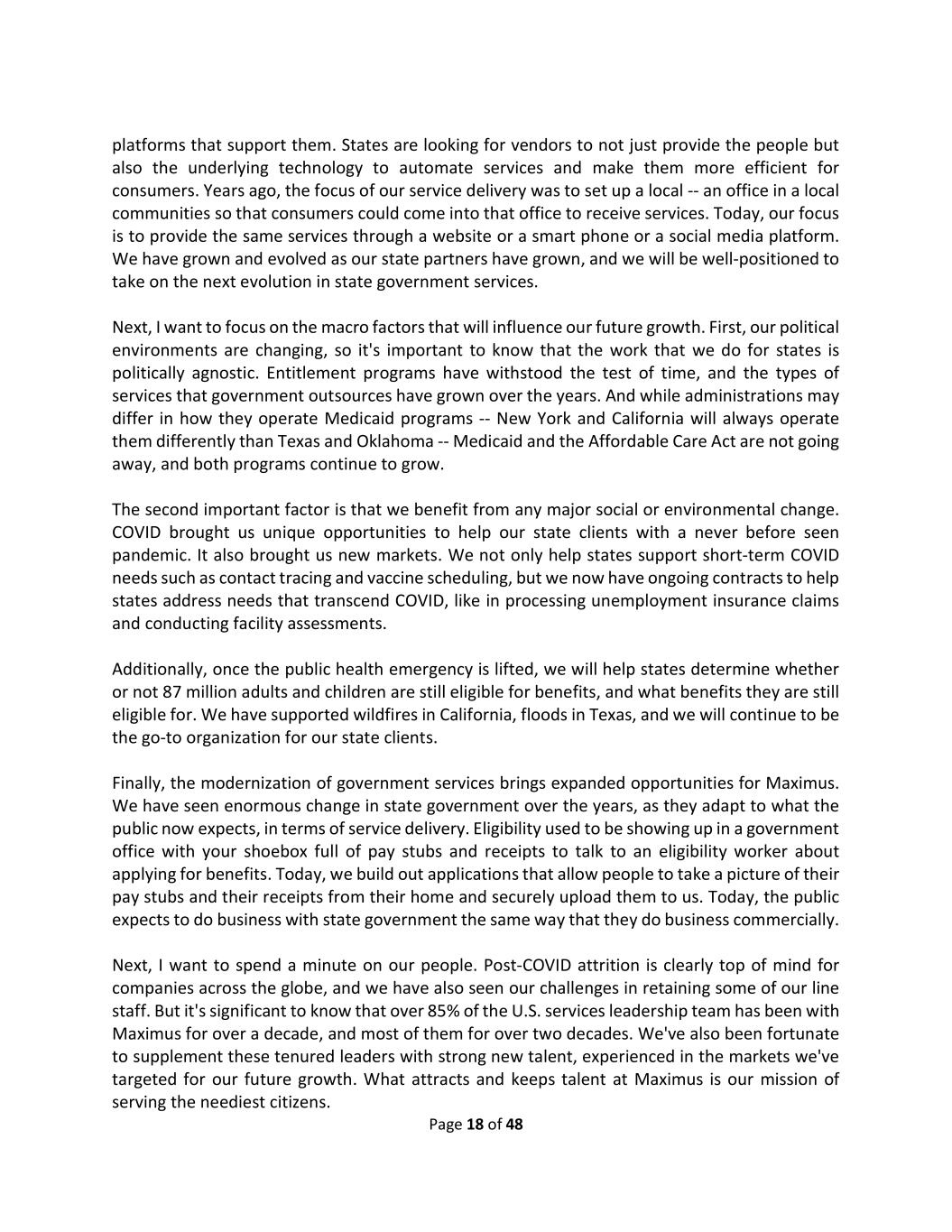
Page 18 of 48 platforms that support them. States are looking for vendors to not just provide the people but also the underlying technology to automate services and make them more efficient for consumers. Years ago, the focus of our service delivery was to set up a local -- an office in a local communities so that consumers could come into that office to receive services. Today, our focus is to provide the same services through a website or a smart phone or a social media platform. We have grown and evolved as our state partners have grown, and we will be well-positioned to take on the next evolution in state government services. Next, I want to focus on the macro factors that will influence our future growth. First, our political environments are changing, so it's important to know that the work that we do for states is politically agnostic. Entitlement programs have withstood the test of time, and the types of services that government outsources have grown over the years. And while administrations may differ in how they operate Medicaid programs -- New York and California will always operate them differently than Texas and Oklahoma -- Medicaid and the Affordable Care Act are not going away, and both programs continue to grow. The second important factor is that we benefit from any major social or environmental change. COVID brought us unique opportunities to help our state clients with a never before seen pandemic. It also brought us new markets. We not only help states support short-term COVID needs such as contact tracing and vaccine scheduling, but we now have ongoing contracts to help states address needs that transcend COVID, like in processing unemployment insurance claims and conducting facility assessments. Additionally, once the public health emergency is lifted, we will help states determine whether or not 87 million adults and children are still eligible for benefits, and what benefits they are still eligible for. We have supported wildfires in California, floods in Texas, and we will continue to be the go-to organization for our state clients. Finally, the modernization of government services brings expanded opportunities for Maximus. We have seen enormous change in state government over the years, as they adapt to what the public now expects, in terms of service delivery. Eligibility used to be showing up in a government office with your shoebox full of pay stubs and receipts to talk to an eligibility worker about applying for benefits. Today, we build out applications that allow people to take a picture of their pay stubs and their receipts from their home and securely upload them to us. Today, the public expects to do business with state government the same way that they do business commercially. Next, I want to spend a minute on our people. Post-COVID attrition is clearly top of mind for companies across the globe, and we have also seen our challenges in retaining some of our line staff. But it's significant to know that over 85% of the U.S. services leadership team has been with Maximus for over a decade, and most of them for over two decades. We've also been fortunate to supplement these tenured leaders with strong new talent, experienced in the markets we've targeted for our future growth. What attracts and keeps talent at Maximus is our mission of serving the neediest citizens.
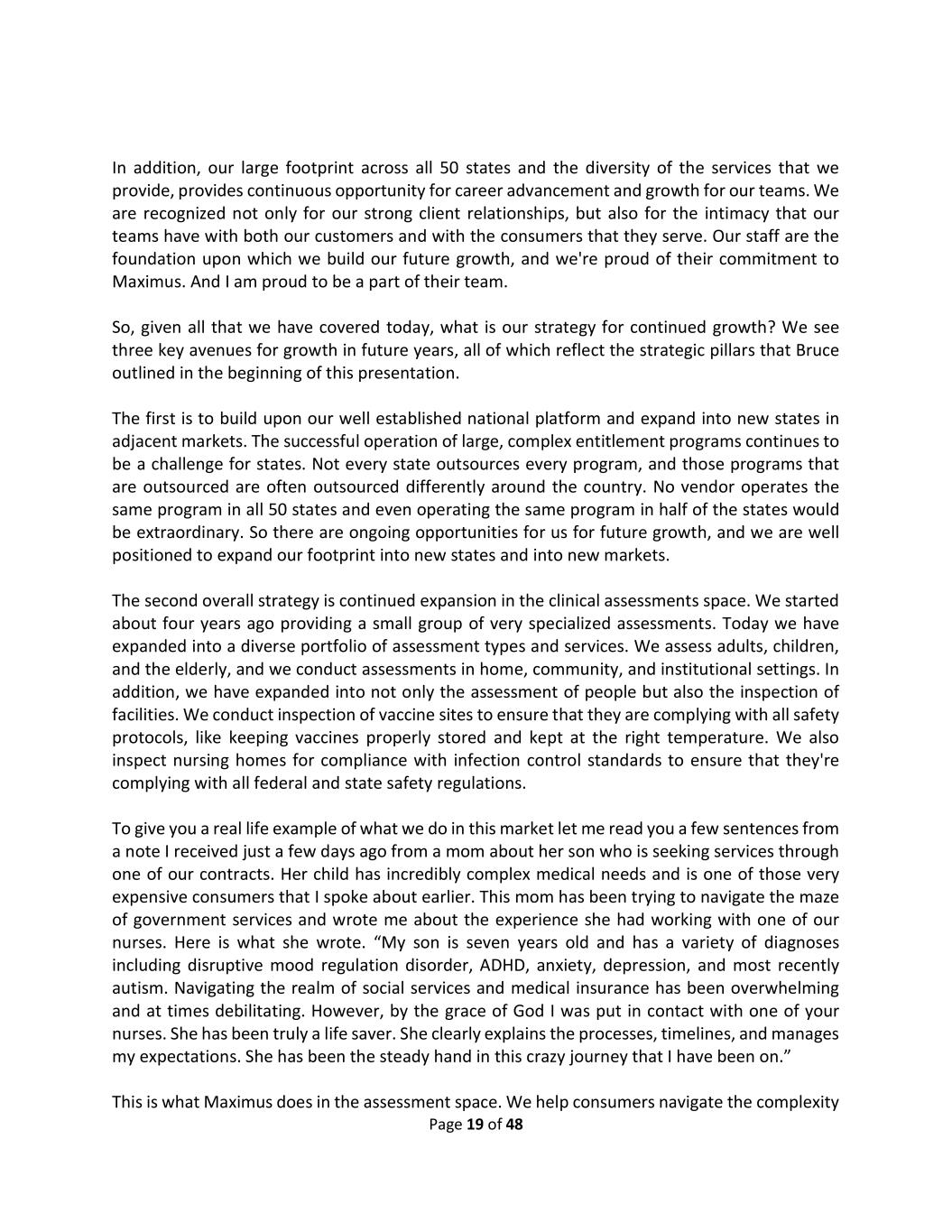
Page 19 of 48 In addition, our large footprint across all 50 states and the diversity of the services that we provide, provides continuous opportunity for career advancement and growth for our teams. We are recognized not only for our strong client relationships, but also for the intimacy that our teams have with both our customers and with the consumers that they serve. Our staff are the foundation upon which we build our future growth, and we're proud of their commitment to Maximus. And I am proud to be a part of their team. So, given all that we have covered today, what is our strategy for continued growth? We see three key avenues for growth in future years, all of which reflect the strategic pillars that Bruce outlined in the beginning of this presentation. The first is to build upon our well established national platform and expand into new states in adjacent markets. The successful operation of large, complex entitlement programs continues to be a challenge for states. Not every state outsources every program, and those programs that are outsourced are often outsourced differently around the country. No vendor operates the same program in all 50 states and even operating the same program in half of the states would be extraordinary. So there are ongoing opportunities for us for future growth, and we are well positioned to expand our footprint into new states and into new markets. The second overall strategy is continued expansion in the clinical assessments space. We started about four years ago providing a small group of very specialized assessments. Today we have expanded into a diverse portfolio of assessment types and services. We assess adults, children, and the elderly, and we conduct assessments in home, community, and institutional settings. In addition, we have expanded into not only the assessment of people but also the inspection of facilities. We conduct inspection of vaccine sites to ensure that they are complying with all safety protocols, like keeping vaccines properly stored and kept at the right temperature. We also inspect nursing homes for compliance with infection control standards to ensure that they're complying with all federal and state safety regulations. To give you a real life example of what we do in this market let me read you a few sentences from a note I received just a few days ago from a mom about her son who is seeking services through one of our contracts. Her child has incredibly complex medical needs and is one of those very expensive consumers that I spoke about earlier. This mom has been trying to navigate the maze of government services and wrote me about the experience she had working with one of our nurses. Here is what she wrote. “My son is seven years old and has a variety of diagnoses including disruptive mood regulation disorder, ADHD, anxiety, depression, and most recently autism. Navigating the realm of social services and medical insurance has been overwhelming and at times debilitating. However, by the grace of God I was put in contact with one of your nurses. She has been truly a life saver. She clearly explains the processes, timelines, and manages my expectations. She has been the steady hand in this crazy journey that I have been on.” This is what Maximus does in the assessment space. We help consumers navigate the complexity

Page 20 of 48 of state government services and we help states ensure that these really needy and expensive consumers like this child receive the services that they so desperately need. This is an important and emerging market that is essential to states, as it ensures that Medicaid dollars are being well spent. And so we're focused on exploring new states and new opportunities. The third prong in our strategy is to take advantage of state governments' focus on technology modernization. States are moving to both modernize and simplify their technology platforms. States used to contract for single consolidated technology platforms to handle all of the services for both Medicaid members and providers. These were large, complex, high-risk contracts which took years to build, often with less than satisfactory results. These contracts were held by a handful of entrenched incumbents, and the barriers to entry and the risks were high, all of this making this very large market basically unattractive to us. However, states are now breaking these large contracts into smaller pieces and outsourcing each component separately. This reduces both the risk and the cost not only for the state but also for the vendor. And since the federal government pays for 90% of these costs, the Feds are now requiring states to contract out in this new more modular fashion. So this opens up new opportunities for Maximus in the technology space where before the barriers to entry were too high. We have already been successful in four states in building a platform to enroll providers who want to service Medicaid beneficiaries. We expect about 16 separate opportunities in this market in the next 12 to 36 months. So in closing what are the key messages you should take away from this presentation? First, we've been supporting states and delivering health and human services programs for more than three decades, and our services support some of the largest domestic programs in the nation. The barriers to entry in our market are high. We deliver complicated programs tied to complex policy and regulation, which means we must know not only how to build the car but also how to drive it. We have deep customer intimacy and we are trusted partners to our state clients. Our sharp focus on government is important not only to our clients but also to our staff, as it helps us attract and retain strong talent in a competitive labor market. And finally, we look forward to continued growth in FY ‘23 as we emerge from COVID with double-digit margins. We are excited for what the future holds for us, for continued growth in the 50 states and territories that make up the U.S. services segment. Thank you. I now turn it over to Kevin Reilly to talk about our outside of the U.S. segment after a brief video on our new look and feel. [Transition video played]. Kevin Reilly Good morning. As others have said, thank you for joining us today. We appreciate your focus on Maximus. Terry and Ilene have covered our U.S. operations with you, so I'd like to take you on a

Page 21 of 48 tour of our operations outside the United States. Of course, while there are many similarities and some differences between our U.S. and outside the U.S. operations, you will note a few common themes. Like our U.S. businesses, there is attractive growth potential outside the U.S., especially in government, health, and social services. We are building a strong track record serving governments and delivering specialized and complex programs, and we have established a reputation as a trusted and reliable partner which is strong today and getting stronger. Today I will cover three touchpoints that will provide you insight into our business strategy and an understanding of our competitive advantages. Number one: what we do, where we do it, and what makes us different. Number two: our strategic and disciplined approach to new market entry. And number three: our operational focus to land, execute, and expand through diversification and bring the full suite of Maximus solutions to our customers. I've been with Maximus for over 17 years and involved with the strategic cycle of land, execute, and expand in almost all of our geographies. Later in my presentation I will provide you with an example of how we apply this model to the UK market. By the end of my presentation I hope that you will have a greater understanding and appreciation of the Maximus strategy and our competitive advantages in our OUS segment. Let's get started. You all will be aware that the OUS segment makes up nearly 20% of the Maximus portfolio. But what do we do? More than half of our OUS portfolio comes from employment services, including general employment programs for government and specialized services for target cohorts such as people with disabilities or others who face barriers to long term sustained employment. In addition, we provide skills training and upscaling for job seekers. In short, our team improves the lives of many of the most vulnerable communities, helping ensure policy translates into outcomes that matter. We approach our work with a fundamental goal in mind to make a meaningful impact on people's lives. Approximately 29% of our delivery comes from clinical services such as health and disability assessments and occupational health and wellness. The balance comes from program services and technology, such as citizen engagement contact centers and benefit programs claims administration. Many of these services are complimentary to one another and provide synergies with government agencies. I have shared with you what we do, and now I'll share what sets us apart from the competition. We have a global portfolio of demonstrated performance based contracting, making us a trusted delivery partner to our government clients. We are disciplined in our approach to new market entry with an ability to affect global knowledge transfer to local teams. This knowledge transfer allows us to grow and diversify our portfolio with proven service offerings from other parts of Maximus.
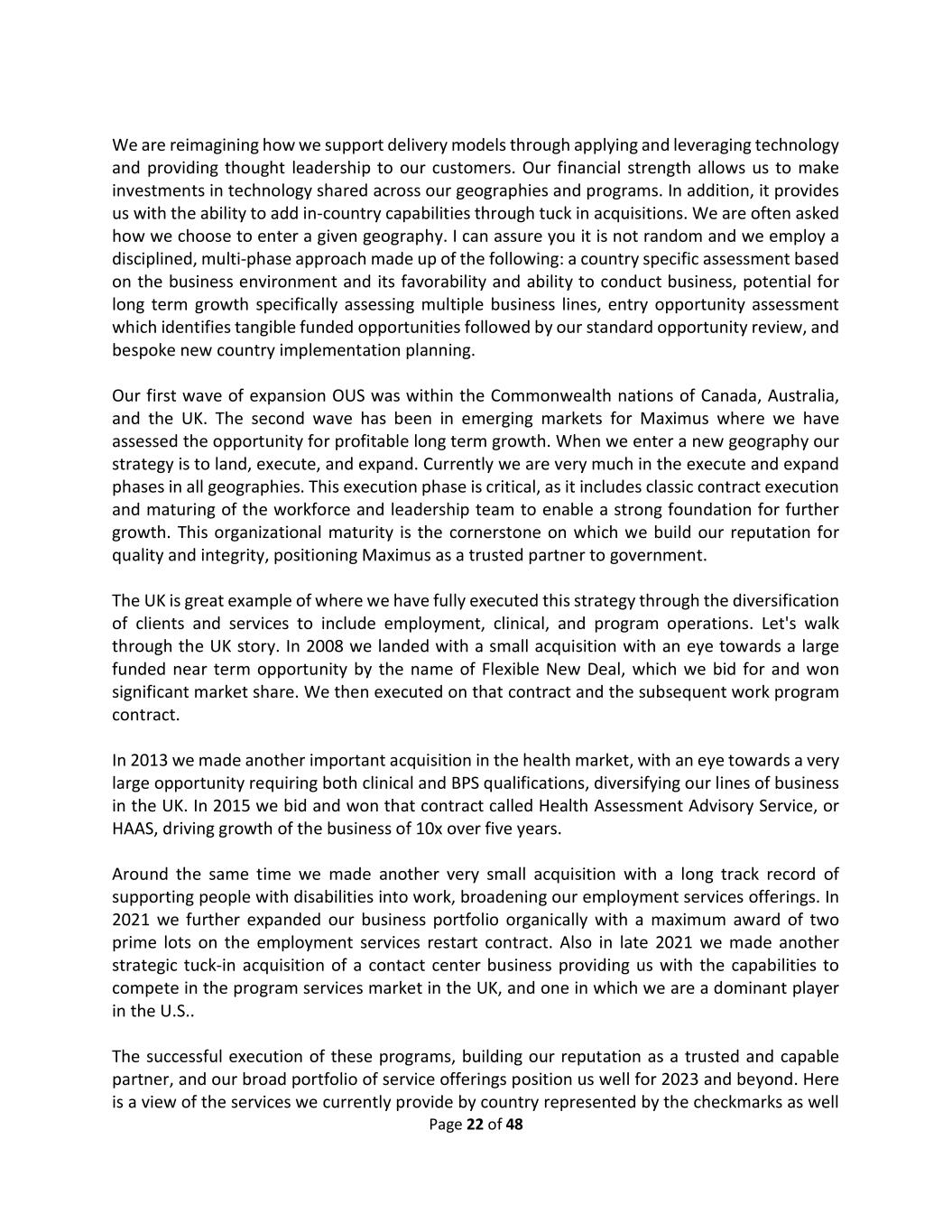
Page 22 of 48 We are reimagining how we support delivery models through applying and leveraging technology and providing thought leadership to our customers. Our financial strength allows us to make investments in technology shared across our geographies and programs. In addition, it provides us with the ability to add in-country capabilities through tuck in acquisitions. We are often asked how we choose to enter a given geography. I can assure you it is not random and we employ a disciplined, multi-phase approach made up of the following: a country specific assessment based on the business environment and its favorability and ability to conduct business, potential for long term growth specifically assessing multiple business lines, entry opportunity assessment which identifies tangible funded opportunities followed by our standard opportunity review, and bespoke new country implementation planning. Our first wave of expansion OUS was within the Commonwealth nations of Canada, Australia, and the UK. The second wave has been in emerging markets for Maximus where we have assessed the opportunity for profitable long term growth. When we enter a new geography our strategy is to land, execute, and expand. Currently we are very much in the execute and expand phases in all geographies. This execution phase is critical, as it includes classic contract execution and maturing of the workforce and leadership team to enable a strong foundation for further growth. This organizational maturity is the cornerstone on which we build our reputation for quality and integrity, positioning Maximus as a trusted partner to government. The UK is great example of where we have fully executed this strategy through the diversification of clients and services to include employment, clinical, and program operations. Let's walk through the UK story. In 2008 we landed with a small acquisition with an eye towards a large funded near term opportunity by the name of Flexible New Deal, which we bid for and won significant market share. We then executed on that contract and the subsequent work program contract. In 2013 we made another important acquisition in the health market, with an eye towards a very large opportunity requiring both clinical and BPS qualifications, diversifying our lines of business in the UK. In 2015 we bid and won that contract called Health Assessment Advisory Service, or HAAS, driving growth of the business of 10x over five years. Around the same time we made another very small acquisition with a long track record of supporting people with disabilities into work, broadening our employment services offerings. In 2021 we further expanded our business portfolio organically with a maximum award of two prime lots on the employment services restart contract. Also in late 2021 we made another strategic tuck-in acquisition of a contact center business providing us with the capabilities to compete in the program services market in the UK, and one in which we are a dominant player in the U.S.. The successful execution of these programs, building our reputation as a trusted and capable partner, and our broad portfolio of service offerings position us well for 2023 and beyond. Here is a view of the services we currently provide by country represented by the checkmarks as well
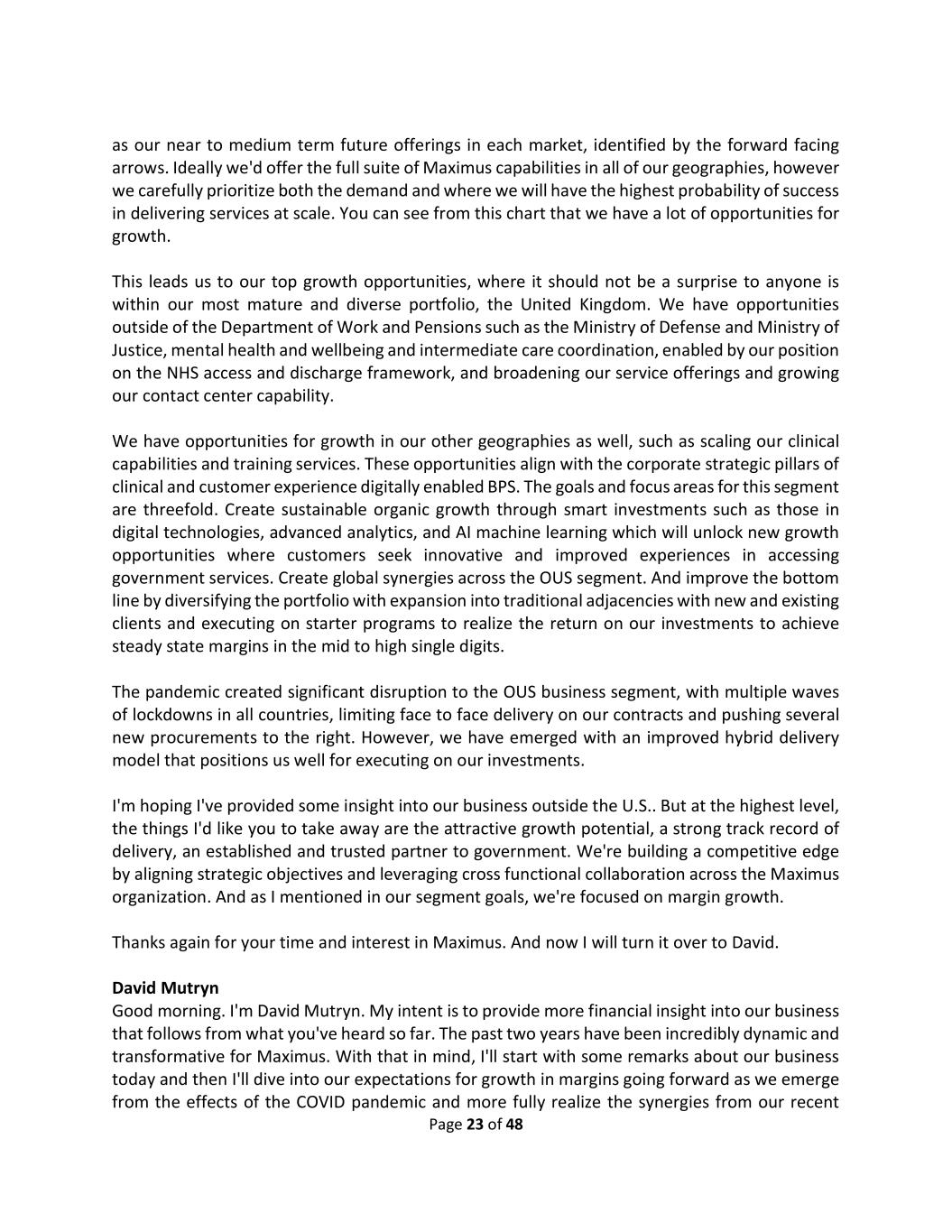
Page 23 of 48 as our near to medium term future offerings in each market, identified by the forward facing arrows. Ideally we'd offer the full suite of Maximus capabilities in all of our geographies, however we carefully prioritize both the demand and where we will have the highest probability of success in delivering services at scale. You can see from this chart that we have a lot of opportunities for growth. This leads us to our top growth opportunities, where it should not be a surprise to anyone is within our most mature and diverse portfolio, the United Kingdom. We have opportunities outside of the Department of Work and Pensions such as the Ministry of Defense and Ministry of Justice, mental health and wellbeing and intermediate care coordination, enabled by our position on the NHS access and discharge framework, and broadening our service offerings and growing our contact center capability. We have opportunities for growth in our other geographies as well, such as scaling our clinical capabilities and training services. These opportunities align with the corporate strategic pillars of clinical and customer experience digitally enabled BPS. The goals and focus areas for this segment are threefold. Create sustainable organic growth through smart investments such as those in digital technologies, advanced analytics, and AI machine learning which will unlock new growth opportunities where customers seek innovative and improved experiences in accessing government services. Create global synergies across the OUS segment. And improve the bottom line by diversifying the portfolio with expansion into traditional adjacencies with new and existing clients and executing on starter programs to realize the return on our investments to achieve steady state margins in the mid to high single digits. The pandemic created significant disruption to the OUS business segment, with multiple waves of lockdowns in all countries, limiting face to face delivery on our contracts and pushing several new procurements to the right. However, we have emerged with an improved hybrid delivery model that positions us well for executing on our investments. I'm hoping I've provided some insight into our business outside the U.S.. But at the highest level, the things I'd like you to take away are the attractive growth potential, a strong track record of delivery, an established and trusted partner to government. We're building a competitive edge by aligning strategic objectives and leveraging cross functional collaboration across the Maximus organization. And as I mentioned in our segment goals, we're focused on margin growth. Thanks again for your time and interest in Maximus. And now I will turn it over to David. David Mutryn Good morning. I'm David Mutryn. My intent is to provide more financial insight into our business that follows from what you've heard so far. The past two years have been incredibly dynamic and transformative for Maximus. With that in mind, I'll start with some remarks about our business today and then I'll dive into our expectations for growth in margins going forward as we emerge from the effects of the COVID pandemic and more fully realize the synergies from our recent
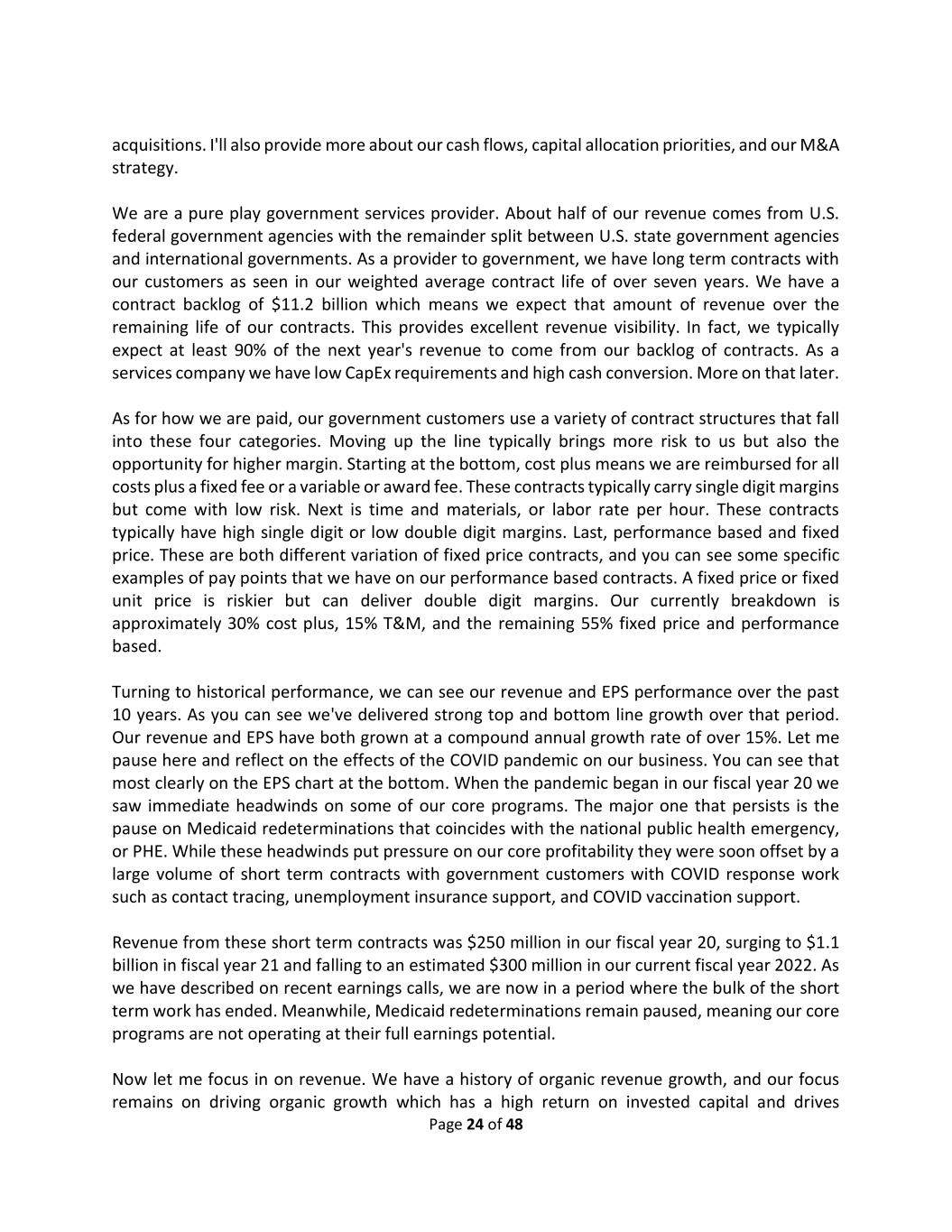
Page 24 of 48 acquisitions. I'll also provide more about our cash flows, capital allocation priorities, and our M&A strategy. We are a pure play government services provider. About half of our revenue comes from U.S. federal government agencies with the remainder split between U.S. state government agencies and international governments. As a provider to government, we have long term contracts with our customers as seen in our weighted average contract life of over seven years. We have a contract backlog of $11.2 billion which means we expect that amount of revenue over the remaining life of our contracts. This provides excellent revenue visibility. In fact, we typically expect at least 90% of the next year's revenue to come from our backlog of contracts. As a services company we have low CapEx requirements and high cash conversion. More on that later. As for how we are paid, our government customers use a variety of contract structures that fall into these four categories. Moving up the line typically brings more risk to us but also the opportunity for higher margin. Starting at the bottom, cost plus means we are reimbursed for all costs plus a fixed fee or a variable or award fee. These contracts typically carry single digit margins but come with low risk. Next is time and materials, or labor rate per hour. These contracts typically have high single digit or low double digit margins. Last, performance based and fixed price. These are both different variation of fixed price contracts, and you can see some specific examples of pay points that we have on our performance based contracts. A fixed price or fixed unit price is riskier but can deliver double digit margins. Our currently breakdown is approximately 30% cost plus, 15% T&M, and the remaining 55% fixed price and performance based. Turning to historical performance, we can see our revenue and EPS performance over the past 10 years. As you can see we've delivered strong top and bottom line growth over that period. Our revenue and EPS have both grown at a compound annual growth rate of over 15%. Let me pause here and reflect on the effects of the COVID pandemic on our business. You can see that most clearly on the EPS chart at the bottom. When the pandemic began in our fiscal year 20 we saw immediate headwinds on some of our core programs. The major one that persists is the pause on Medicaid redeterminations that coincides with the national public health emergency, or PHE. While these headwinds put pressure on our core profitability they were soon offset by a large volume of short term contracts with government customers with COVID response work such as contact tracing, unemployment insurance support, and COVID vaccination support. Revenue from these short term contracts was $250 million in our fiscal year 20, surging to $1.1 billion in fiscal year 21 and falling to an estimated $300 million in our current fiscal year 2022. As we have described on recent earnings calls, we are now in a period where the bulk of the short term work has ended. Meanwhile, Medicaid redeterminations remain paused, meaning our core programs are not operating at their full earnings potential. Now let me focus in on revenue. We have a history of organic revenue growth, and our focus remains on driving organic growth which has a high return on invested capital and drives
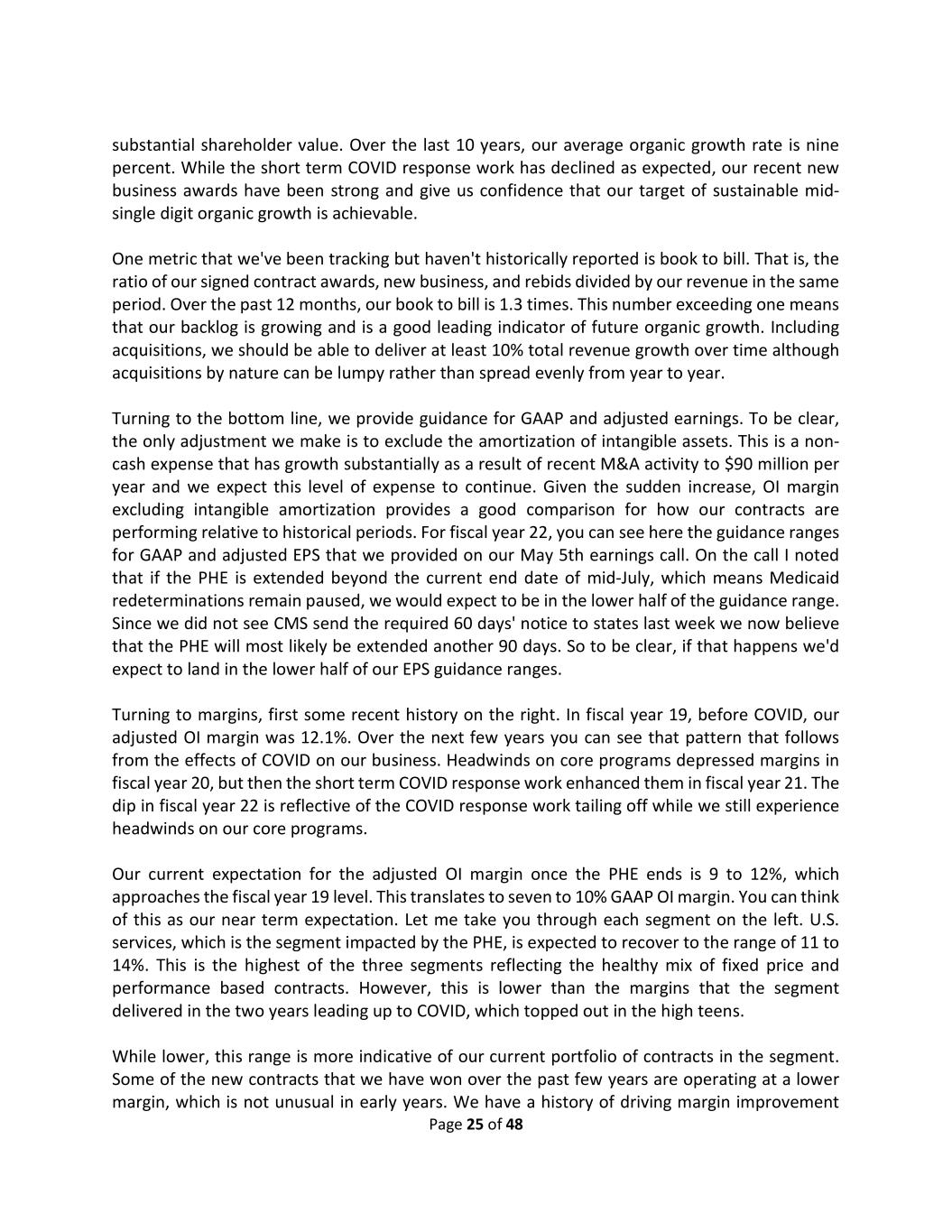
Page 25 of 48 substantial shareholder value. Over the last 10 years, our average organic growth rate is nine percent. While the short term COVID response work has declined as expected, our recent new business awards have been strong and give us confidence that our target of sustainable mid- single digit organic growth is achievable. One metric that we've been tracking but haven't historically reported is book to bill. That is, the ratio of our signed contract awards, new business, and rebids divided by our revenue in the same period. Over the past 12 months, our book to bill is 1.3 times. This number exceeding one means that our backlog is growing and is a good leading indicator of future organic growth. Including acquisitions, we should be able to deliver at least 10% total revenue growth over time although acquisitions by nature can be lumpy rather than spread evenly from year to year. Turning to the bottom line, we provide guidance for GAAP and adjusted earnings. To be clear, the only adjustment we make is to exclude the amortization of intangible assets. This is a non- cash expense that has growth substantially as a result of recent M&A activity to $90 million per year and we expect this level of expense to continue. Given the sudden increase, OI margin excluding intangible amortization provides a good comparison for how our contracts are performing relative to historical periods. For fiscal year 22, you can see here the guidance ranges for GAAP and adjusted EPS that we provided on our May 5th earnings call. On the call I noted that if the PHE is extended beyond the current end date of mid-July, which means Medicaid redeterminations remain paused, we would expect to be in the lower half of the guidance range. Since we did not see CMS send the required 60 days' notice to states last week we now believe that the PHE will most likely be extended another 90 days. So to be clear, if that happens we'd expect to land in the lower half of our EPS guidance ranges. Turning to margins, first some recent history on the right. In fiscal year 19, before COVID, our adjusted OI margin was 12.1%. Over the next few years you can see that pattern that follows from the effects of COVID on our business. Headwinds on core programs depressed margins in fiscal year 20, but then the short term COVID response work enhanced them in fiscal year 21. The dip in fiscal year 22 is reflective of the COVID response work tailing off while we still experience headwinds on our core programs. Our current expectation for the adjusted OI margin once the PHE ends is 9 to 12%, which approaches the fiscal year 19 level. This translates to seven to 10% GAAP OI margin. You can think of this as our near term expectation. Let me take you through each segment on the left. U.S. services, which is the segment impacted by the PHE, is expected to recover to the range of 11 to 14%. This is the highest of the three segments reflecting the healthy mix of fixed price and performance based contracts. However, this is lower than the margins that the segment delivered in the two years leading up to COVID, which topped out in the high teens. While lower, this range is more indicative of our current portfolio of contracts in the segment. Some of the new contracts that we have won over the past few years are operating at a lower margin, which is not unusual in early years. We have a history of driving margin improvement
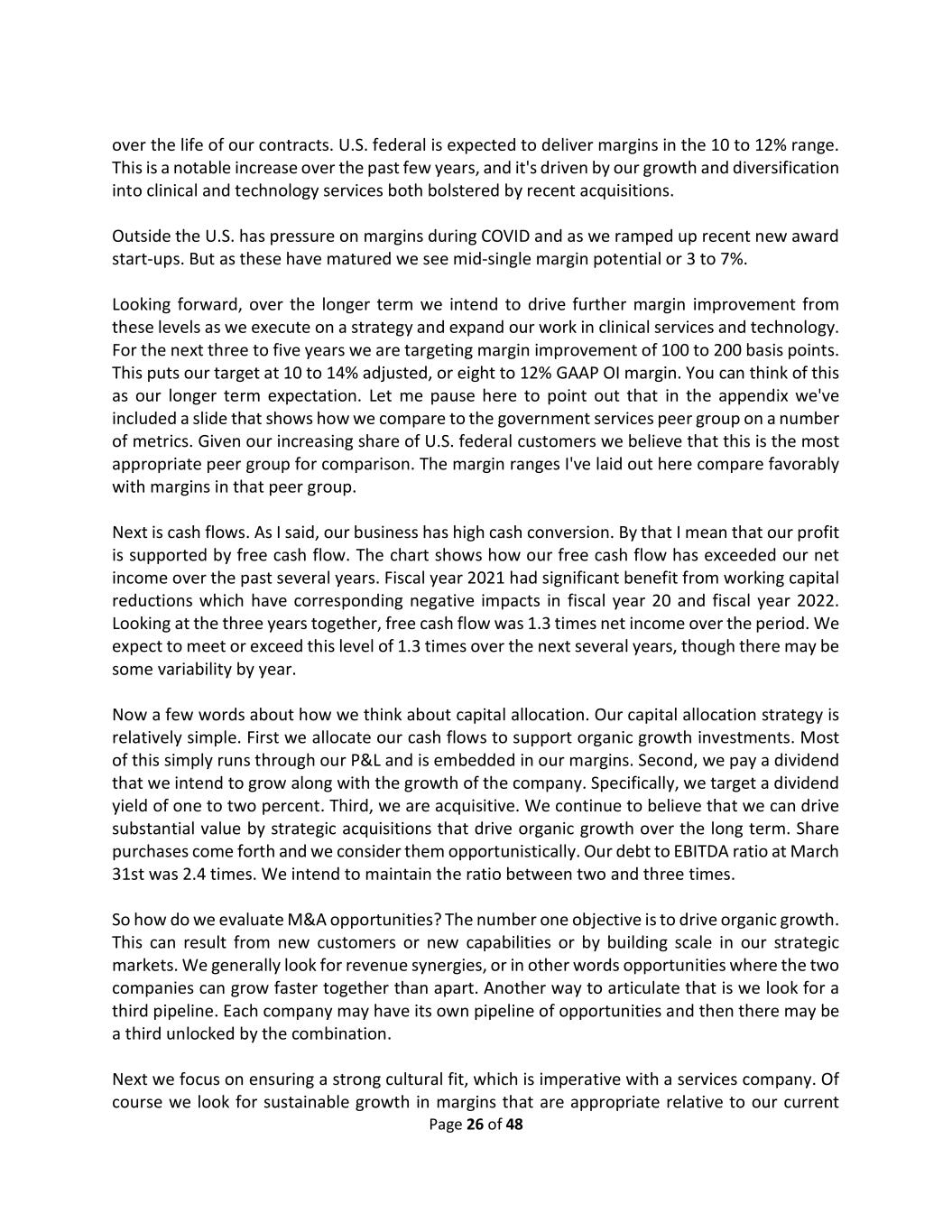
Page 26 of 48 over the life of our contracts. U.S. federal is expected to deliver margins in the 10 to 12% range. This is a notable increase over the past few years, and it's driven by our growth and diversification into clinical and technology services both bolstered by recent acquisitions. Outside the U.S. has pressure on margins during COVID and as we ramped up recent new award start-ups. But as these have matured we see mid-single margin potential or 3 to 7%. Looking forward, over the longer term we intend to drive further margin improvement from these levels as we execute on a strategy and expand our work in clinical services and technology. For the next three to five years we are targeting margin improvement of 100 to 200 basis points. This puts our target at 10 to 14% adjusted, or eight to 12% GAAP OI margin. You can think of this as our longer term expectation. Let me pause here to point out that in the appendix we've included a slide that shows how we compare to the government services peer group on a number of metrics. Given our increasing share of U.S. federal customers we believe that this is the most appropriate peer group for comparison. The margin ranges I've laid out here compare favorably with margins in that peer group. Next is cash flows. As I said, our business has high cash conversion. By that I mean that our profit is supported by free cash flow. The chart shows how our free cash flow has exceeded our net income over the past several years. Fiscal year 2021 had significant benefit from working capital reductions which have corresponding negative impacts in fiscal year 20 and fiscal year 2022. Looking at the three years together, free cash flow was 1.3 times net income over the period. We expect to meet or exceed this level of 1.3 times over the next several years, though there may be some variability by year. Now a few words about how we think about capital allocation. Our capital allocation strategy is relatively simple. First we allocate our cash flows to support organic growth investments. Most of this simply runs through our P&L and is embedded in our margins. Second, we pay a dividend that we intend to grow along with the growth of the company. Specifically, we target a dividend yield of one to two percent. Third, we are acquisitive. We continue to believe that we can drive substantial value by strategic acquisitions that drive organic growth over the long term. Share purchases come forth and we consider them opportunistically. Our debt to EBITDA ratio at March 31st was 2.4 times. We intend to maintain the ratio between two and three times. So how do we evaluate M&A opportunities? The number one objective is to drive organic growth. This can result from new customers or new capabilities or by building scale in our strategic markets. We generally look for revenue synergies, or in other words opportunities where the two companies can grow faster together than apart. Another way to articulate that is we look for a third pipeline. Each company may have its own pipeline of opportunities and then there may be a third unlocked by the combination. Next we focus on ensuring a strong cultural fit, which is imperative with a services company. Of course we look for sustainable growth in margins that are appropriate relative to our current
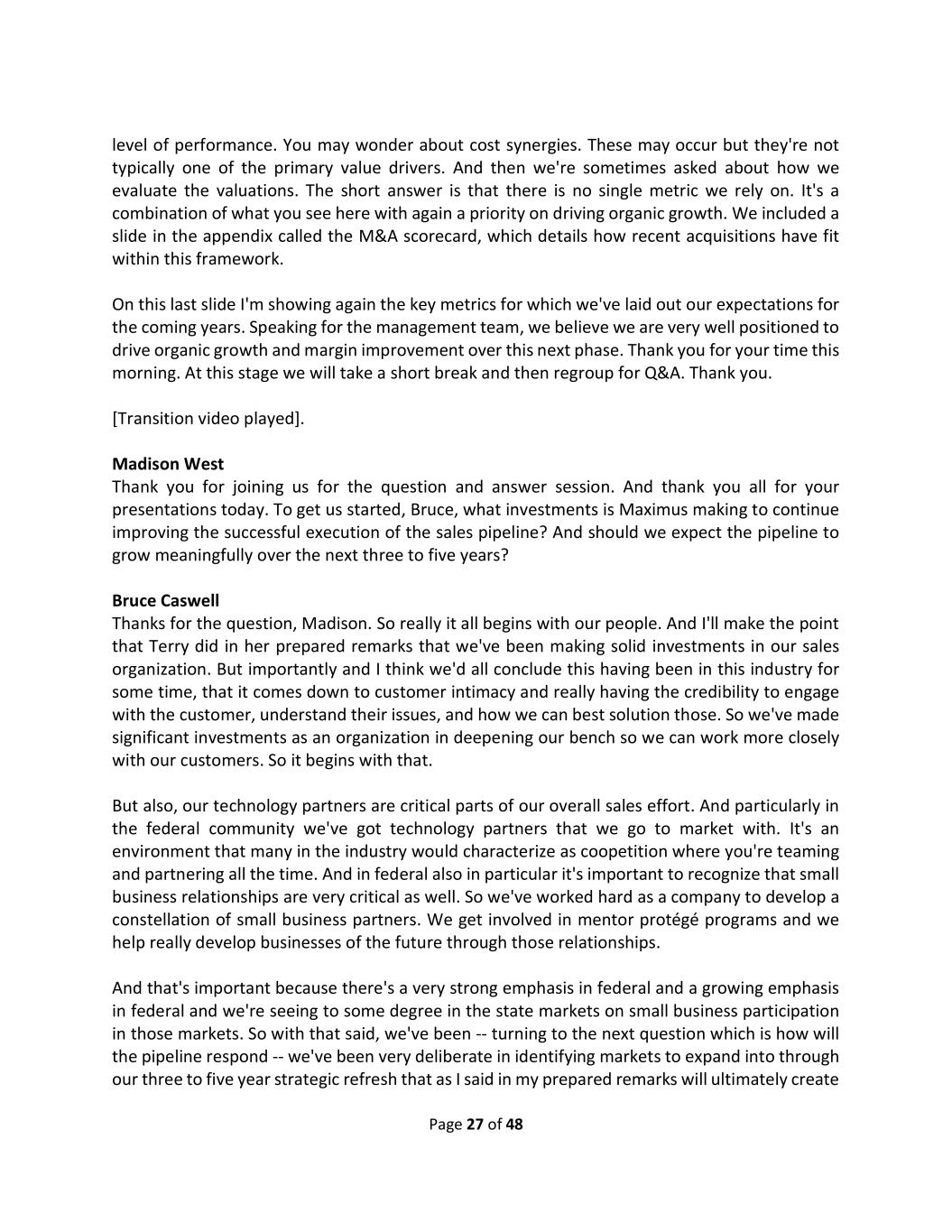
Page 27 of 48 level of performance. You may wonder about cost synergies. These may occur but they're not typically one of the primary value drivers. And then we're sometimes asked about how we evaluate the valuations. The short answer is that there is no single metric we rely on. It's a combination of what you see here with again a priority on driving organic growth. We included a slide in the appendix called the M&A scorecard, which details how recent acquisitions have fit within this framework. On this last slide I'm showing again the key metrics for which we've laid out our expectations for the coming years. Speaking for the management team, we believe we are very well positioned to drive organic growth and margin improvement over this next phase. Thank you for your time this morning. At this stage we will take a short break and then regroup for Q&A. Thank you. [Transition video played]. Madison West Thank you for joining us for the question and answer session. And thank you all for your presentations today. To get us started, Bruce, what investments is Maximus making to continue improving the successful execution of the sales pipeline? And should we expect the pipeline to grow meaningfully over the next three to five years? Bruce Caswell Thanks for the question, Madison. So really it all begins with our people. And I'll make the point that Terry did in her prepared remarks that we've been making solid investments in our sales organization. But importantly and I think we'd all conclude this having been in this industry for some time, that it comes down to customer intimacy and really having the credibility to engage with the customer, understand their issues, and how we can best solution those. So we've made significant investments as an organization in deepening our bench so we can work more closely with our customers. So it begins with that. But also, our technology partners are critical parts of our overall sales effort. And particularly in the federal community we've got technology partners that we go to market with. It's an environment that many in the industry would characterize as coopetition where you're teaming and partnering all the time. And in federal also in particular it's important to recognize that small business relationships are very critical as well. So we've worked hard as a company to develop a constellation of small business partners. We get involved in mentor protégé programs and we help really develop businesses of the future through those relationships. And that's important because there's a very strong emphasis in federal and a growing emphasis in federal and we're seeing to some degree in the state markets on small business participation in those markets. So with that said, we've been -- turning to the next question which is how will the pipeline respond -- we've been very deliberate in identifying markets to expand into through our three to five year strategic refresh that as I said in my prepared remarks will ultimately create
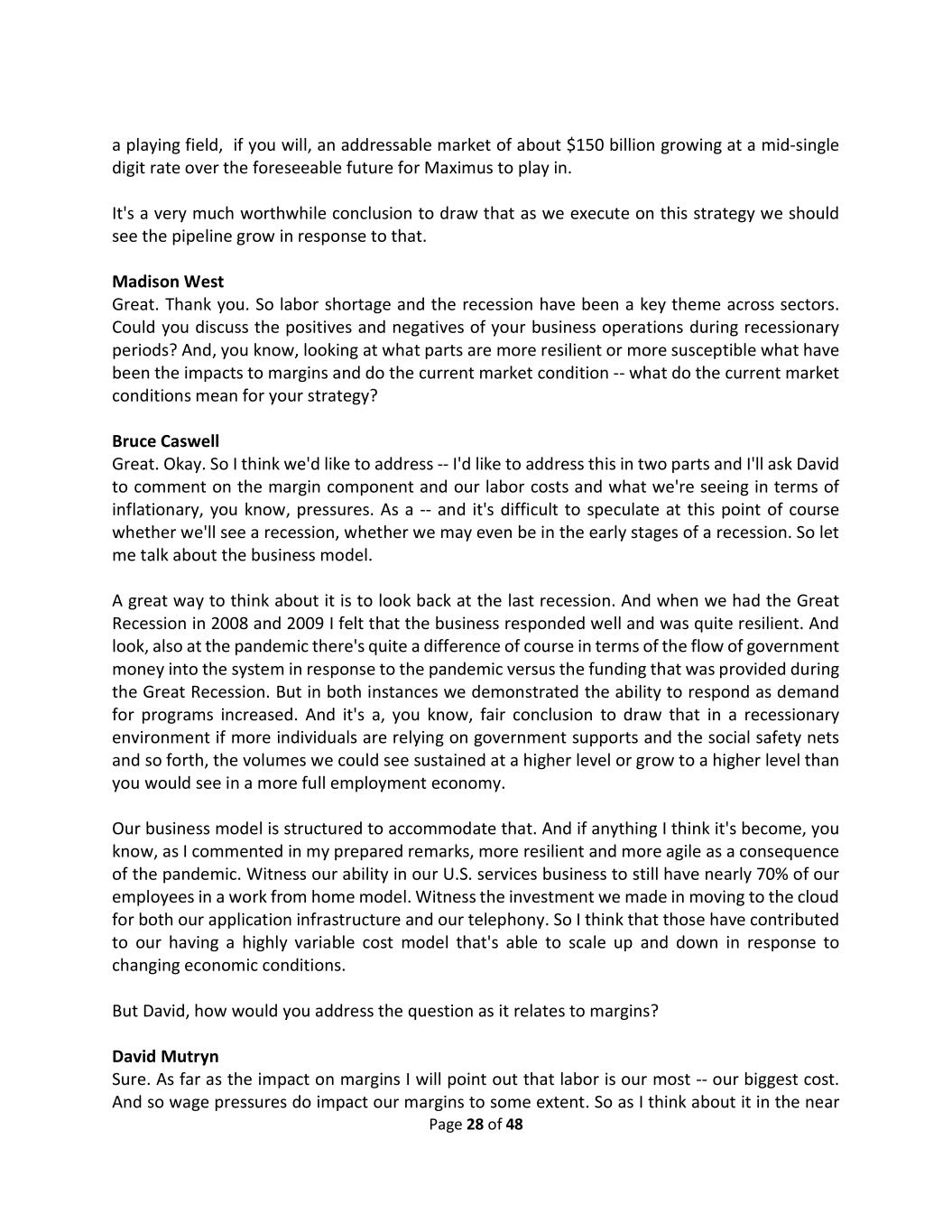
Page 28 of 48 a playing field, if you will, an addressable market of about $150 billion growing at a mid-single digit rate over the foreseeable future for Maximus to play in. It's a very much worthwhile conclusion to draw that as we execute on this strategy we should see the pipeline grow in response to that. Madison West Great. Thank you. So labor shortage and the recession have been a key theme across sectors. Could you discuss the positives and negatives of your business operations during recessionary periods? And, you know, looking at what parts are more resilient or more susceptible what have been the impacts to margins and do the current market condition -- what do the current market conditions mean for your strategy? Bruce Caswell Great. Okay. So I think we'd like to address -- I'd like to address this in two parts and I'll ask David to comment on the margin component and our labor costs and what we're seeing in terms of inflationary, you know, pressures. As a -- and it's difficult to speculate at this point of course whether we'll see a recession, whether we may even be in the early stages of a recession. So let me talk about the business model. A great way to think about it is to look back at the last recession. And when we had the Great Recession in 2008 and 2009 I felt that the business responded well and was quite resilient. And look, also at the pandemic there's quite a difference of course in terms of the flow of government money into the system in response to the pandemic versus the funding that was provided during the Great Recession. But in both instances we demonstrated the ability to respond as demand for programs increased. And it's a, you know, fair conclusion to draw that in a recessionary environment if more individuals are relying on government supports and the social safety nets and so forth, the volumes we could see sustained at a higher level or grow to a higher level than you would see in a more full employment economy. Our business model is structured to accommodate that. And if anything I think it's become, you know, as I commented in my prepared remarks, more resilient and more agile as a consequence of the pandemic. Witness our ability in our U.S. services business to still have nearly 70% of our employees in a work from home model. Witness the investment we made in moving to the cloud for both our application infrastructure and our telephony. So I think that those have contributed to our having a highly variable cost model that's able to scale up and down in response to changing economic conditions. But David, how would you address the question as it relates to margins? David Mutryn Sure. As far as the impact on margins I will point out that labor is our most -- our biggest cost. And so wage pressures do impact our margins to some extent. So as I think about it in the near
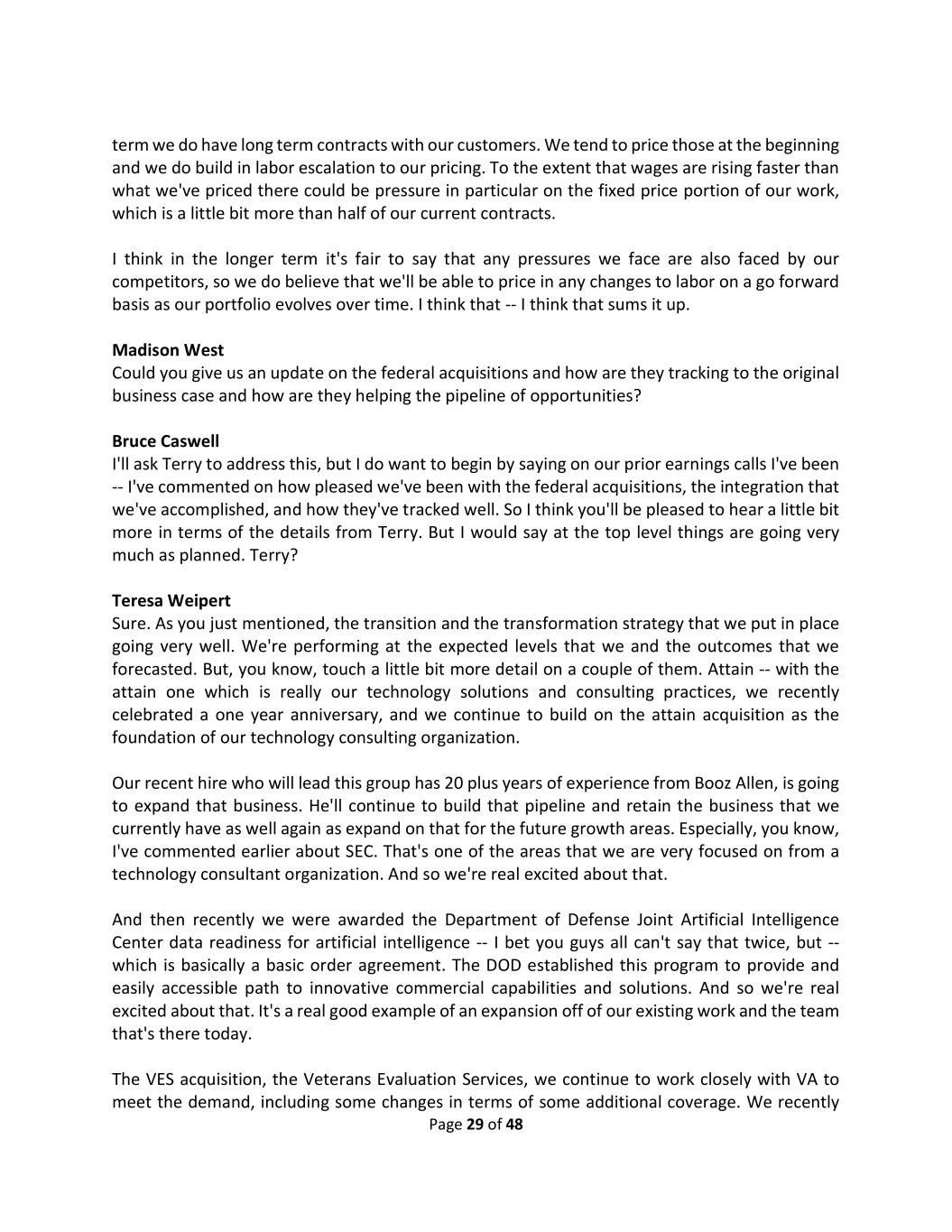
Page 29 of 48 term we do have long term contracts with our customers. We tend to price those at the beginning and we do build in labor escalation to our pricing. To the extent that wages are rising faster than what we've priced there could be pressure in particular on the fixed price portion of our work, which is a little bit more than half of our current contracts. I think in the longer term it's fair to say that any pressures we face are also faced by our competitors, so we do believe that we'll be able to price in any changes to labor on a go forward basis as our portfolio evolves over time. I think that -- I think that sums it up. Madison West Could you give us an update on the federal acquisitions and how are they tracking to the original business case and how are they helping the pipeline of opportunities? Bruce Caswell I'll ask Terry to address this, but I do want to begin by saying on our prior earnings calls I've been -- I've commented on how pleased we've been with the federal acquisitions, the integration that we've accomplished, and how they've tracked well. So I think you'll be pleased to hear a little bit more in terms of the details from Terry. But I would say at the top level things are going very much as planned. Terry? Teresa Weipert Sure. As you just mentioned, the transition and the transformation strategy that we put in place going very well. We're performing at the expected levels that we and the outcomes that we forecasted. But, you know, touch a little bit more detail on a couple of them. Attain -- with the attain one which is really our technology solutions and consulting practices, we recently celebrated a one year anniversary, and we continue to build on the attain acquisition as the foundation of our technology consulting organization. Our recent hire who will lead this group has 20 plus years of experience from Booz Allen, is going to expand that business. He'll continue to build that pipeline and retain the business that we currently have as well again as expand on that for the future growth areas. Especially, you know, I've commented earlier about SEC. That's one of the areas that we are very focused on from a technology consultant organization. And so we're real excited about that. And then recently we were awarded the Department of Defense Joint Artificial Intelligence Center data readiness for artificial intelligence -- I bet you guys all can't say that twice, but -- which is basically a basic order agreement. The DOD established this program to provide and easily accessible path to innovative commercial capabilities and solutions. And so we're real excited about that. It's a real good example of an expansion off of our existing work and the team that's there today. The VES acquisition, the Veterans Evaluation Services, we continue to work closely with VA to meet the demand, including some changes in terms of some additional coverage. We recently
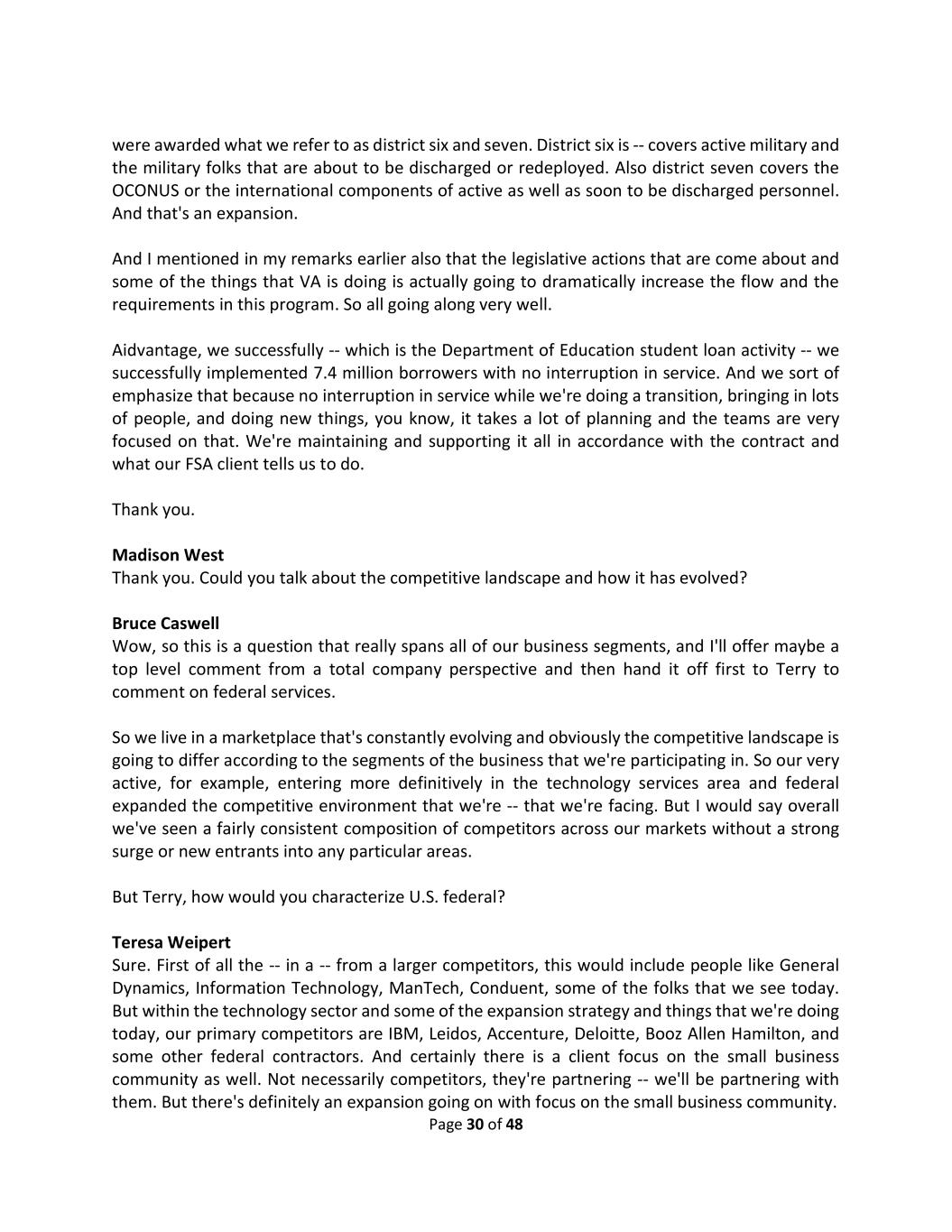
Page 30 of 48 were awarded what we refer to as district six and seven. District six is -- covers active military and the military folks that are about to be discharged or redeployed. Also district seven covers the OCONUS or the international components of active as well as soon to be discharged personnel. And that's an expansion. And I mentioned in my remarks earlier also that the legislative actions that are come about and some of the things that VA is doing is actually going to dramatically increase the flow and the requirements in this program. So all going along very well. Aidvantage, we successfully -- which is the Department of Education student loan activity -- we successfully implemented 7.4 million borrowers with no interruption in service. And we sort of emphasize that because no interruption in service while we're doing a transition, bringing in lots of people, and doing new things, you know, it takes a lot of planning and the teams are very focused on that. We're maintaining and supporting it all in accordance with the contract and what our FSA client tells us to do. Thank you. Madison West Thank you. Could you talk about the competitive landscape and how it has evolved? Bruce Caswell Wow, so this is a question that really spans all of our business segments, and I'll offer maybe a top level comment from a total company perspective and then hand it off first to Terry to comment on federal services. So we live in a marketplace that's constantly evolving and obviously the competitive landscape is going to differ according to the segments of the business that we're participating in. So our very active, for example, entering more definitively in the technology services area and federal expanded the competitive environment that we're -- that we're facing. But I would say overall we've seen a fairly consistent composition of competitors across our markets without a strong surge or new entrants into any particular areas. But Terry, how would you characterize U.S. federal? Teresa Weipert Sure. First of all the -- in a -- from a larger competitors, this would include people like General Dynamics, Information Technology, ManTech, Conduent, some of the folks that we see today. But within the technology sector and some of the expansion strategy and things that we're doing today, our primary competitors are IBM, Leidos, Accenture, Deloitte, Booz Allen Hamilton, and some other federal contractors. And certainly there is a client focus on the small business community as well. Not necessarily competitors, they're partnering -- we'll be partnering with them. But there's definitely an expansion going on with focus on the small business community.

Page 31 of 48 Bruce Caswell That's great. Ilene, what's going on in U.S. services? Ilene Baylinson Wow. COVID definitely drove diversity in our market. Primarily just because of the sheer volume of new opportunities that we saw, and I think also cause a lot of them were in the core contact center space. But we really haven't seen penetration into our core markets I think primarily because of the high level of technical knowledge and expertise about state and local government and regulation that's really a barrier to entry into our market space. Many of our competitors in our core markets have remained the same. With the publicly traded companies, Conduent's been in the business for years. Some of the larger private players, Gainwell and Deloitte have been there and there's also a few smaller private firms too. The other competitor which is really a positive competitor is the in-source government workforce. So we particularly with COVID were able to partner with some of our state government clients to support and supplement the work that they were doing. A great example of that is in the unemployment insurance area where we were able to help clients process claims, answer backlog phone calls, provide program integrity support. And we're hopeful that this business is going to continue on into the future. Bruce Caswell Great. Kevin, what are you seeing outside the U.S.? Kevin Reilly Sure. We do not have one common competitor across our health and human services portfolio outside the U.S.. However, we do see regional competitors. So as an example in the UK we often see Atos and Capita from time to time Optum or Serco. And in the other geographies that we're in we'll see smaller competitors and not for profits that are native to the local geography. Bruce Caswell Great. Madison West Well so as a follow up to that, long term does it make sense to remain in some other countries if opportunities diminish? Bruce Caswell Well I'll take that one. I would tell you that we're always looking at ways to optimize our portfolio of business and make sure that we're investing our resources but also the time and talent of the leadership team in prioritizing management's time and talent in a manner that leads to long term growth for the business.
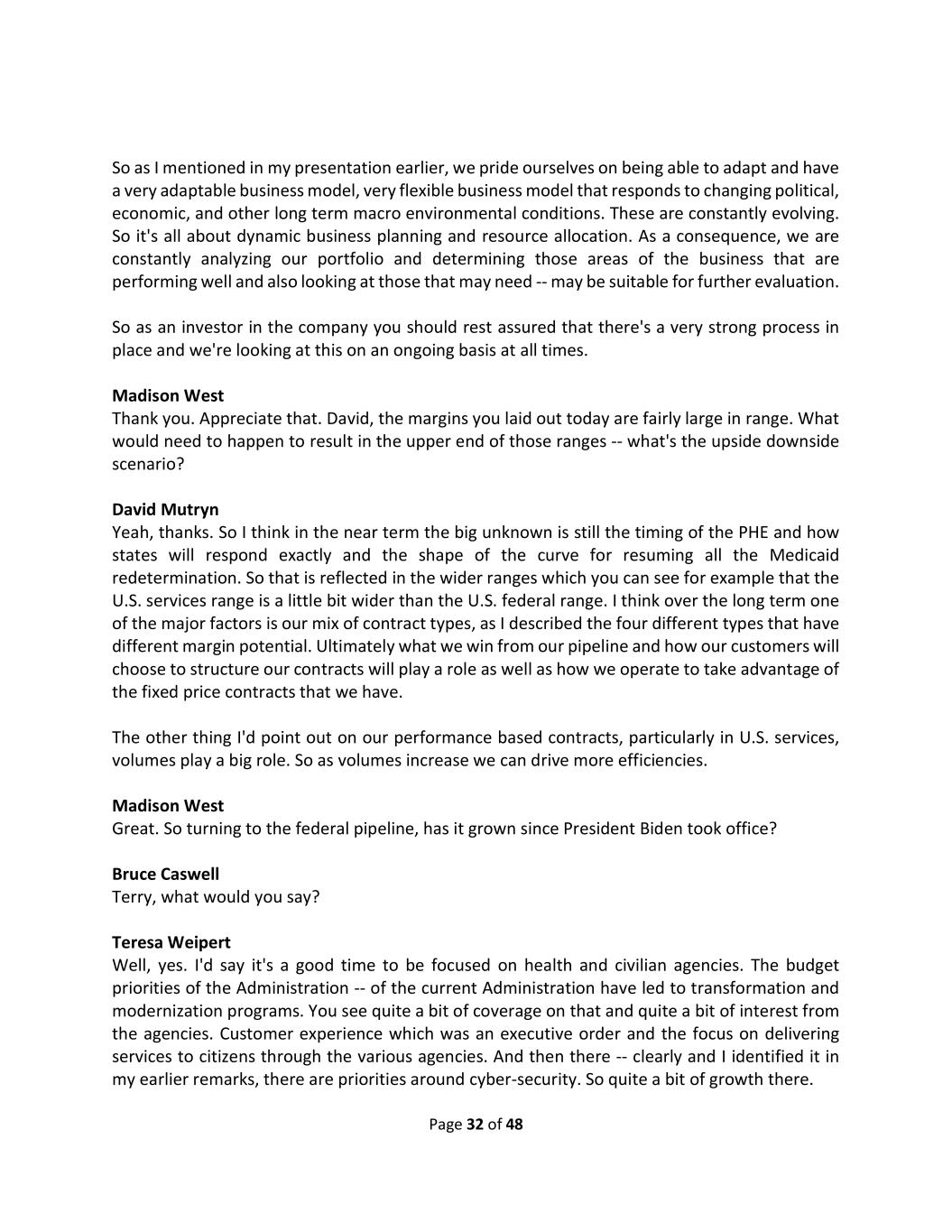
Page 32 of 48 So as I mentioned in my presentation earlier, we pride ourselves on being able to adapt and have a very adaptable business model, very flexible business model that responds to changing political, economic, and other long term macro environmental conditions. These are constantly evolving. So it's all about dynamic business planning and resource allocation. As a consequence, we are constantly analyzing our portfolio and determining those areas of the business that are performing well and also looking at those that may need -- may be suitable for further evaluation. So as an investor in the company you should rest assured that there's a very strong process in place and we're looking at this on an ongoing basis at all times. Madison West Thank you. Appreciate that. David, the margins you laid out today are fairly large in range. What would need to happen to result in the upper end of those ranges -- what's the upside downside scenario? David Mutryn Yeah, thanks. So I think in the near term the big unknown is still the timing of the PHE and how states will respond exactly and the shape of the curve for resuming all the Medicaid redetermination. So that is reflected in the wider ranges which you can see for example that the U.S. services range is a little bit wider than the U.S. federal range. I think over the long term one of the major factors is our mix of contract types, as I described the four different types that have different margin potential. Ultimately what we win from our pipeline and how our customers will choose to structure our contracts will play a role as well as how we operate to take advantage of the fixed price contracts that we have. The other thing I'd point out on our performance based contracts, particularly in U.S. services, volumes play a big role. So as volumes increase we can drive more efficiencies. Madison West Great. So turning to the federal pipeline, has it grown since President Biden took office? Bruce Caswell Terry, what would you say? Teresa Weipert Well, yes. I'd say it's a good time to be focused on health and civilian agencies. The budget priorities of the Administration -- of the current Administration have led to transformation and modernization programs. You see quite a bit of coverage on that and quite a bit of interest from the agencies. Customer experience which was an executive order and the focus on delivering services to citizens through the various agencies. And then there -- clearly and I identified it in my earlier remarks, there are priorities around cyber-security. So quite a bit of growth there.
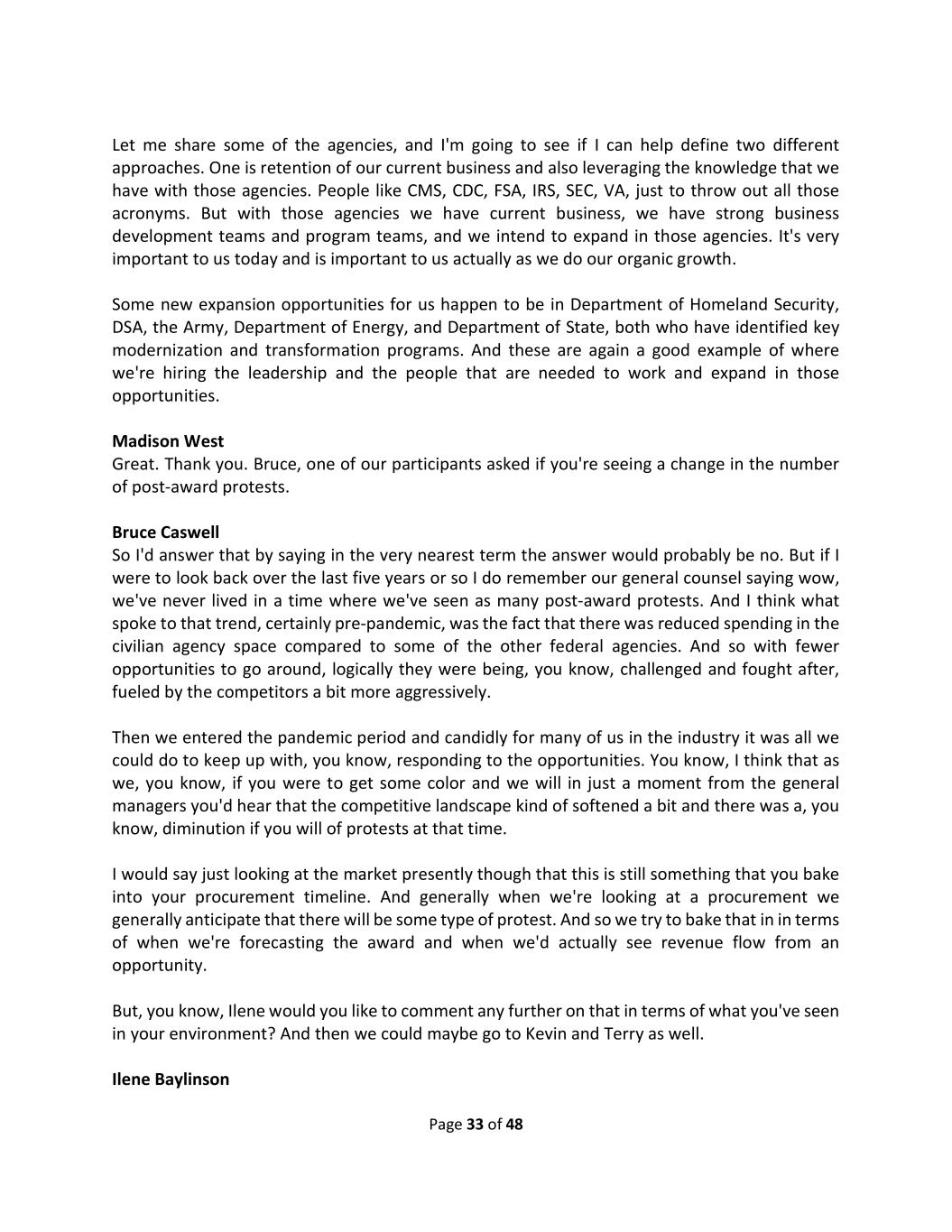
Page 33 of 48 Let me share some of the agencies, and I'm going to see if I can help define two different approaches. One is retention of our current business and also leveraging the knowledge that we have with those agencies. People like CMS, CDC, FSA, IRS, SEC, VA, just to throw out all those acronyms. But with those agencies we have current business, we have strong business development teams and program teams, and we intend to expand in those agencies. It's very important to us today and is important to us actually as we do our organic growth. Some new expansion opportunities for us happen to be in Department of Homeland Security, DSA, the Army, Department of Energy, and Department of State, both who have identified key modernization and transformation programs. And these are again a good example of where we're hiring the leadership and the people that are needed to work and expand in those opportunities. Madison West Great. Thank you. Bruce, one of our participants asked if you're seeing a change in the number of post-award protests. Bruce Caswell So I'd answer that by saying in the very nearest term the answer would probably be no. But if I were to look back over the last five years or so I do remember our general counsel saying wow, we've never lived in a time where we've seen as many post-award protests. And I think what spoke to that trend, certainly pre-pandemic, was the fact that there was reduced spending in the civilian agency space compared to some of the other federal agencies. And so with fewer opportunities to go around, logically they were being, you know, challenged and fought after, fueled by the competitors a bit more aggressively. Then we entered the pandemic period and candidly for many of us in the industry it was all we could do to keep up with, you know, responding to the opportunities. You know, I think that as we, you know, if you were to get some color and we will in just a moment from the general managers you'd hear that the competitive landscape kind of softened a bit and there was a, you know, diminution if you will of protests at that time. I would say just looking at the market presently though that this is still something that you bake into your procurement timeline. And generally when we're looking at a procurement we generally anticipate that there will be some type of protest. And so we try to bake that in in terms of when we're forecasting the award and when we'd actually see revenue flow from an opportunity. But, you know, Ilene would you like to comment any further on that in terms of what you've seen in your environment? And then we could maybe go to Kevin and Terry as well. Ilene Baylinson
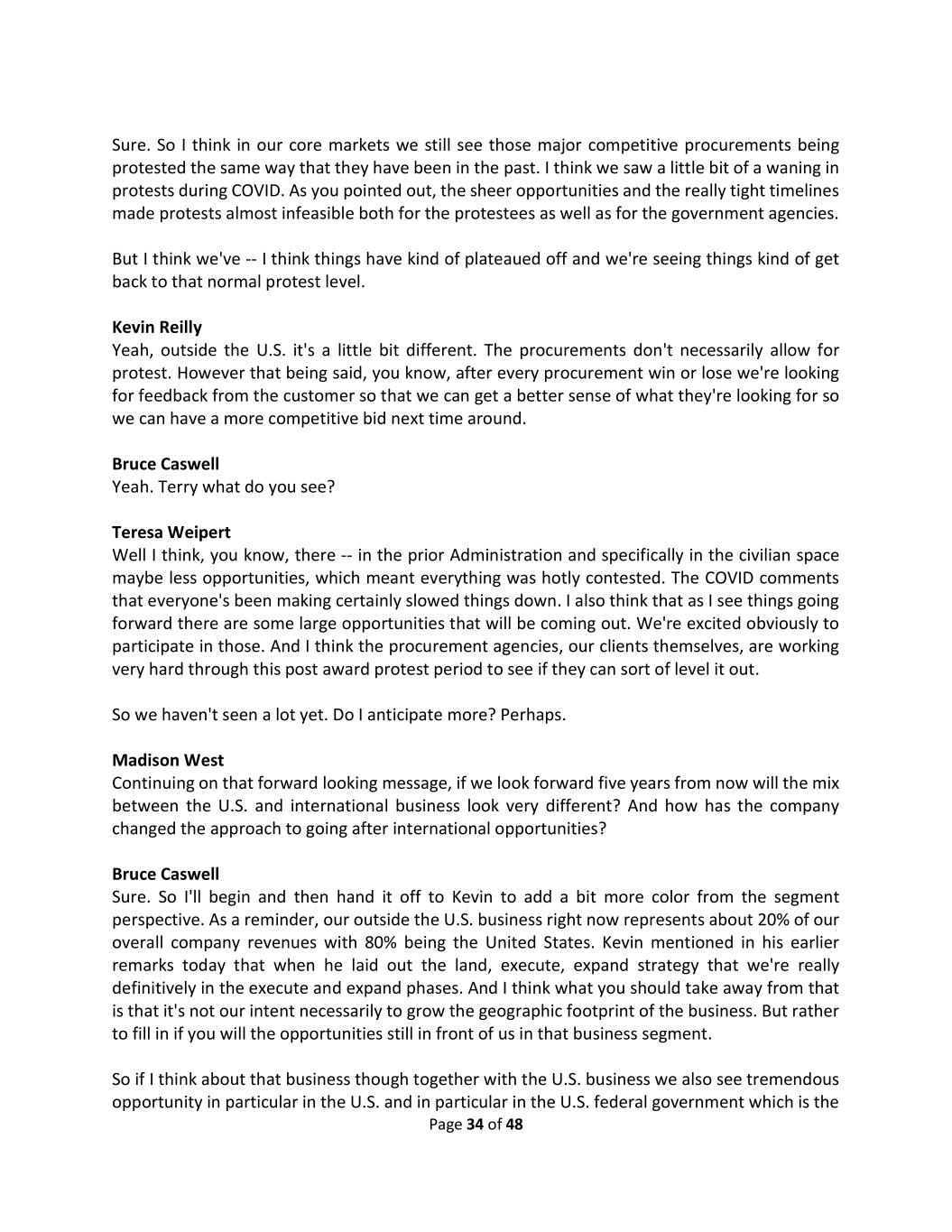
Page 34 of 48 Sure. So I think in our core markets we still see those major competitive procurements being protested the same way that they have been in the past. I think we saw a little bit of a waning in protests during COVID. As you pointed out, the sheer opportunities and the really tight timelines made protests almost infeasible both for the protestees as well as for the government agencies. But I think we've -- I think things have kind of plateaued off and we're seeing things kind of get back to that normal protest level. Kevin Reilly Yeah, outside the U.S. it's a little bit different. The procurements don't necessarily allow for protest. However that being said, you know, after every procurement win or lose we're looking for feedback from the customer so that we can get a better sense of what they're looking for so we can have a more competitive bid next time around. Bruce Caswell Yeah. Terry what do you see? Teresa Weipert Well I think, you know, there -- in the prior Administration and specifically in the civilian space maybe less opportunities, which meant everything was hotly contested. The COVID comments that everyone's been making certainly slowed things down. I also think that as I see things going forward there are some large opportunities that will be coming out. We're excited obviously to participate in those. And I think the procurement agencies, our clients themselves, are working very hard through this post award protest period to see if they can sort of level it out. So we haven't seen a lot yet. Do I anticipate more? Perhaps. Madison West Continuing on that forward looking message, if we look forward five years from now will the mix between the U.S. and international business look very different? And how has the company changed the approach to going after international opportunities? Bruce Caswell Sure. So I'll begin and then hand it off to Kevin to add a bit more color from the segment perspective. As a reminder, our outside the U.S. business right now represents about 20% of our overall company revenues with 80% being the United States. Kevin mentioned in his earlier remarks today that when he laid out the land, execute, expand strategy that we're really definitively in the execute and expand phases. And I think what you should take away from that is that it's not our intent necessarily to grow the geographic footprint of the business. But rather to fill in if you will the opportunities still in front of us in that business segment. So if I think about that business though together with the U.S. business we also see tremendous opportunity in particular in the U.S. and in particular in the U.S. federal government which is the
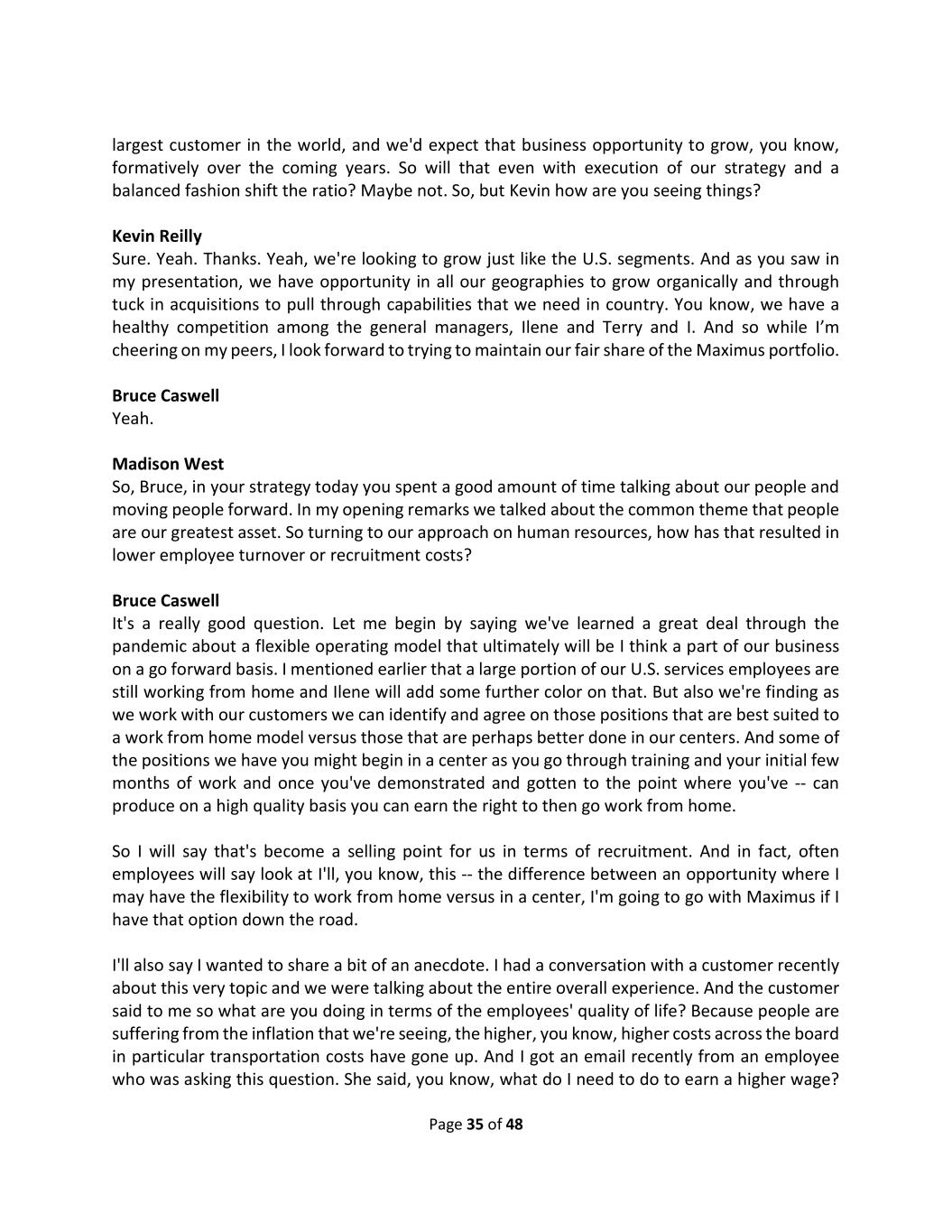
Page 35 of 48 largest customer in the world, and we'd expect that business opportunity to grow, you know, formatively over the coming years. So will that even with execution of our strategy and a balanced fashion shift the ratio? Maybe not. So, but Kevin how are you seeing things? Kevin Reilly Sure. Yeah. Thanks. Yeah, we're looking to grow just like the U.S. segments. And as you saw in my presentation, we have opportunity in all our geographies to grow organically and through tuck in acquisitions to pull through capabilities that we need in country. You know, we have a healthy competition among the general managers, Ilene and Terry and I. And so while I’m cheering on my peers, I look forward to trying to maintain our fair share of the Maximus portfolio. Bruce Caswell Yeah. Madison West So, Bruce, in your strategy today you spent a good amount of time talking about our people and moving people forward. In my opening remarks we talked about the common theme that people are our greatest asset. So turning to our approach on human resources, how has that resulted in lower employee turnover or recruitment costs? Bruce Caswell It's a really good question. Let me begin by saying we've learned a great deal through the pandemic about a flexible operating model that ultimately will be I think a part of our business on a go forward basis. I mentioned earlier that a large portion of our U.S. services employees are still working from home and Ilene will add some further color on that. But also we're finding as we work with our customers we can identify and agree on those positions that are best suited to a work from home model versus those that are perhaps better done in our centers. And some of the positions we have you might begin in a center as you go through training and your initial few months of work and once you've demonstrated and gotten to the point where you've -- can produce on a high quality basis you can earn the right to then go work from home. So I will say that's become a selling point for us in terms of recruitment. And in fact, often employees will say look at I'll, you know, this -- the difference between an opportunity where I may have the flexibility to work from home versus in a center, I'm going to go with Maximus if I have that option down the road. I'll also say I wanted to share a bit of an anecdote. I had a conversation with a customer recently about this very topic and we were talking about the entire overall experience. And the customer said to me so what are you doing in terms of the employees' quality of life? Because people are suffering from the inflation that we're seeing, the higher, you know, higher costs across the board in particular transportation costs have gone up. And I got an email recently from an employee who was asking this question. She said, you know, what do I need to do to earn a higher wage?
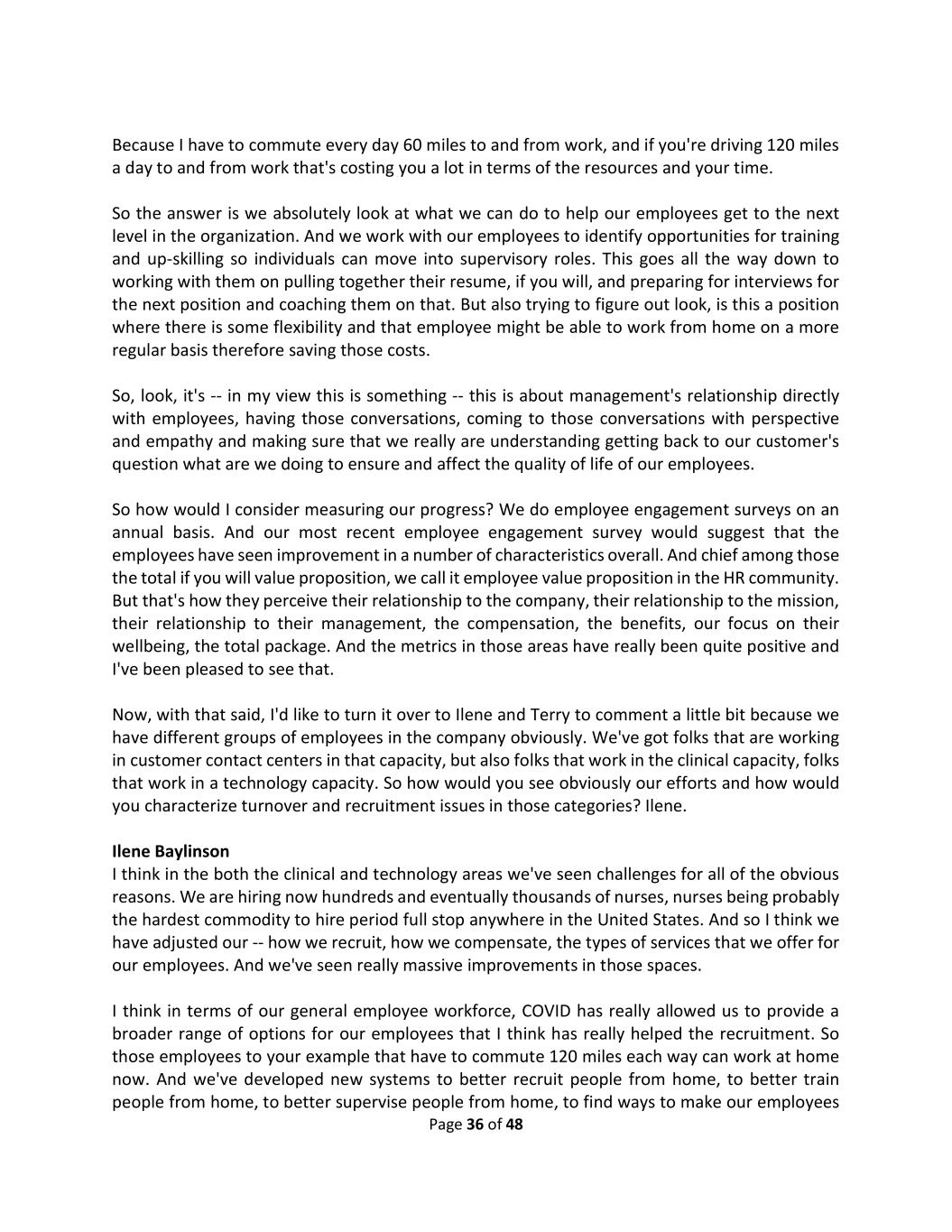
Page 36 of 48 Because I have to commute every day 60 miles to and from work, and if you're driving 120 miles a day to and from work that's costing you a lot in terms of the resources and your time. So the answer is we absolutely look at what we can do to help our employees get to the next level in the organization. And we work with our employees to identify opportunities for training and up-skilling so individuals can move into supervisory roles. This goes all the way down to working with them on pulling together their resume, if you will, and preparing for interviews for the next position and coaching them on that. But also trying to figure out look, is this a position where there is some flexibility and that employee might be able to work from home on a more regular basis therefore saving those costs. So, look, it's -- in my view this is something -- this is about management's relationship directly with employees, having those conversations, coming to those conversations with perspective and empathy and making sure that we really are understanding getting back to our customer's question what are we doing to ensure and affect the quality of life of our employees. So how would I consider measuring our progress? We do employee engagement surveys on an annual basis. And our most recent employee engagement survey would suggest that the employees have seen improvement in a number of characteristics overall. And chief among those the total if you will value proposition, we call it employee value proposition in the HR community. But that's how they perceive their relationship to the company, their relationship to the mission, their relationship to their management, the compensation, the benefits, our focus on their wellbeing, the total package. And the metrics in those areas have really been quite positive and I've been pleased to see that. Now, with that said, I'd like to turn it over to Ilene and Terry to comment a little bit because we have different groups of employees in the company obviously. We've got folks that are working in customer contact centers in that capacity, but also folks that work in the clinical capacity, folks that work in a technology capacity. So how would you see obviously our efforts and how would you characterize turnover and recruitment issues in those categories? Ilene. Ilene Baylinson I think in the both the clinical and technology areas we've seen challenges for all of the obvious reasons. We are hiring now hundreds and eventually thousands of nurses, nurses being probably the hardest commodity to hire period full stop anywhere in the United States. And so I think we have adjusted our -- how we recruit, how we compensate, the types of services that we offer for our employees. And we've seen really massive improvements in those spaces. I think in terms of our general employee workforce, COVID has really allowed us to provide a broader range of options for our employees that I think has really helped the recruitment. So those employees to your example that have to commute 120 miles each way can work at home now. And we've developed new systems to better recruit people from home, to better train people from home, to better supervise people from home, to find ways to make our employees
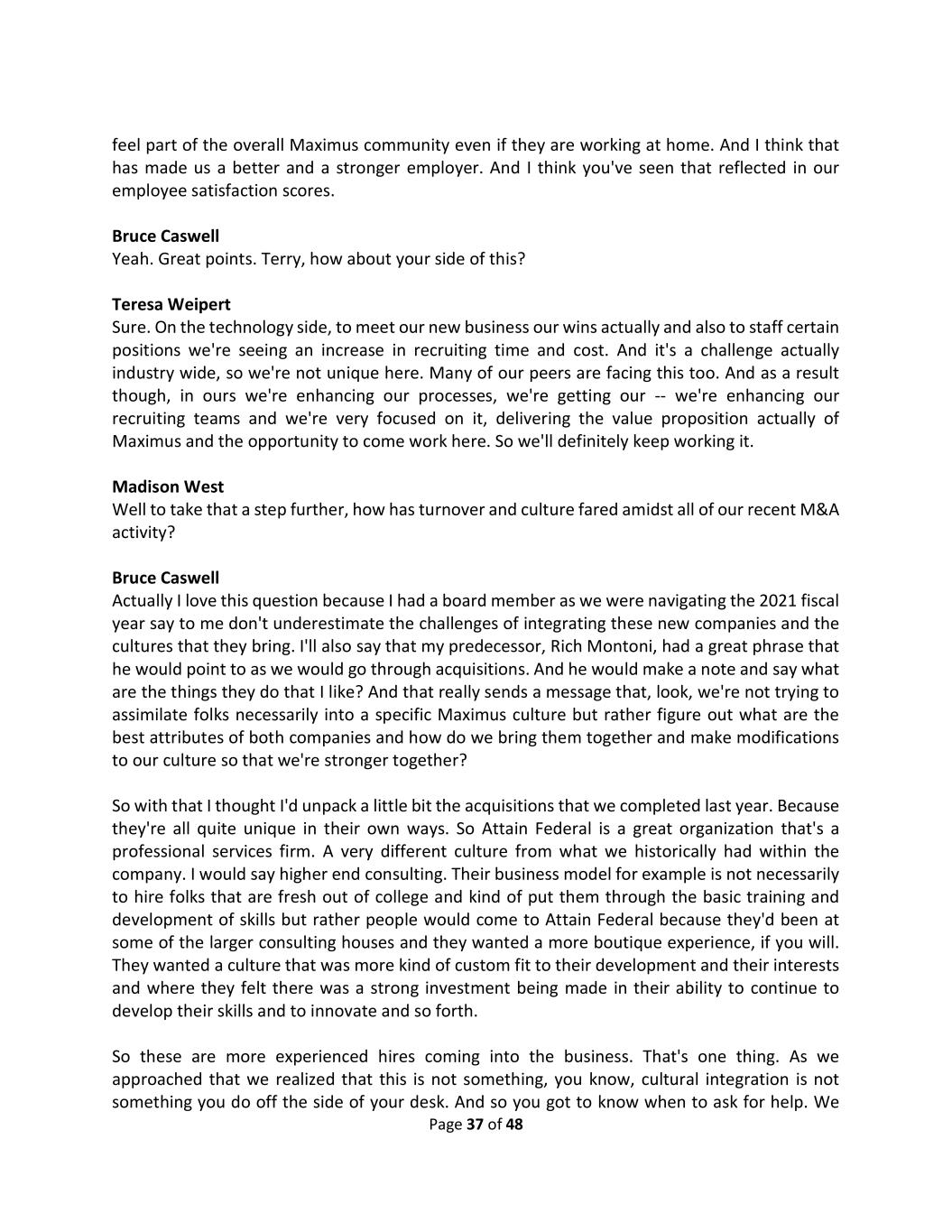
Page 37 of 48 feel part of the overall Maximus community even if they are working at home. And I think that has made us a better and a stronger employer. And I think you've seen that reflected in our employee satisfaction scores. Bruce Caswell Yeah. Great points. Terry, how about your side of this? Teresa Weipert Sure. On the technology side, to meet our new business our wins actually and also to staff certain positions we're seeing an increase in recruiting time and cost. And it's a challenge actually industry wide, so we're not unique here. Many of our peers are facing this too. And as a result though, in ours we're enhancing our processes, we're getting our -- we're enhancing our recruiting teams and we're very focused on it, delivering the value proposition actually of Maximus and the opportunity to come work here. So we'll definitely keep working it. Madison West Well to take that a step further, how has turnover and culture fared amidst all of our recent M&A activity? Bruce Caswell Actually I love this question because I had a board member as we were navigating the 2021 fiscal year say to me don't underestimate the challenges of integrating these new companies and the cultures that they bring. I'll also say that my predecessor, Rich Montoni, had a great phrase that he would point to as we would go through acquisitions. And he would make a note and say what are the things they do that I like? And that really sends a message that, look, we're not trying to assimilate folks necessarily into a specific Maximus culture but rather figure out what are the best attributes of both companies and how do we bring them together and make modifications to our culture so that we're stronger together? So with that I thought I'd unpack a little bit the acquisitions that we completed last year. Because they're all quite unique in their own ways. So Attain Federal is a great organization that's a professional services firm. A very different culture from what we historically had within the company. I would say higher end consulting. Their business model for example is not necessarily to hire folks that are fresh out of college and kind of put them through the basic training and development of skills but rather people would come to Attain Federal because they'd been at some of the larger consulting houses and they wanted a more boutique experience, if you will. They wanted a culture that was more kind of custom fit to their development and their interests and where they felt there was a strong investment being made in their ability to continue to develop their skills and to innovate and so forth. So these are more experienced hires coming into the business. That's one thing. As we approached that we realized that this is not something, you know, cultural integration is not something you do off the side of your desk. And so you got to know when to ask for help. We
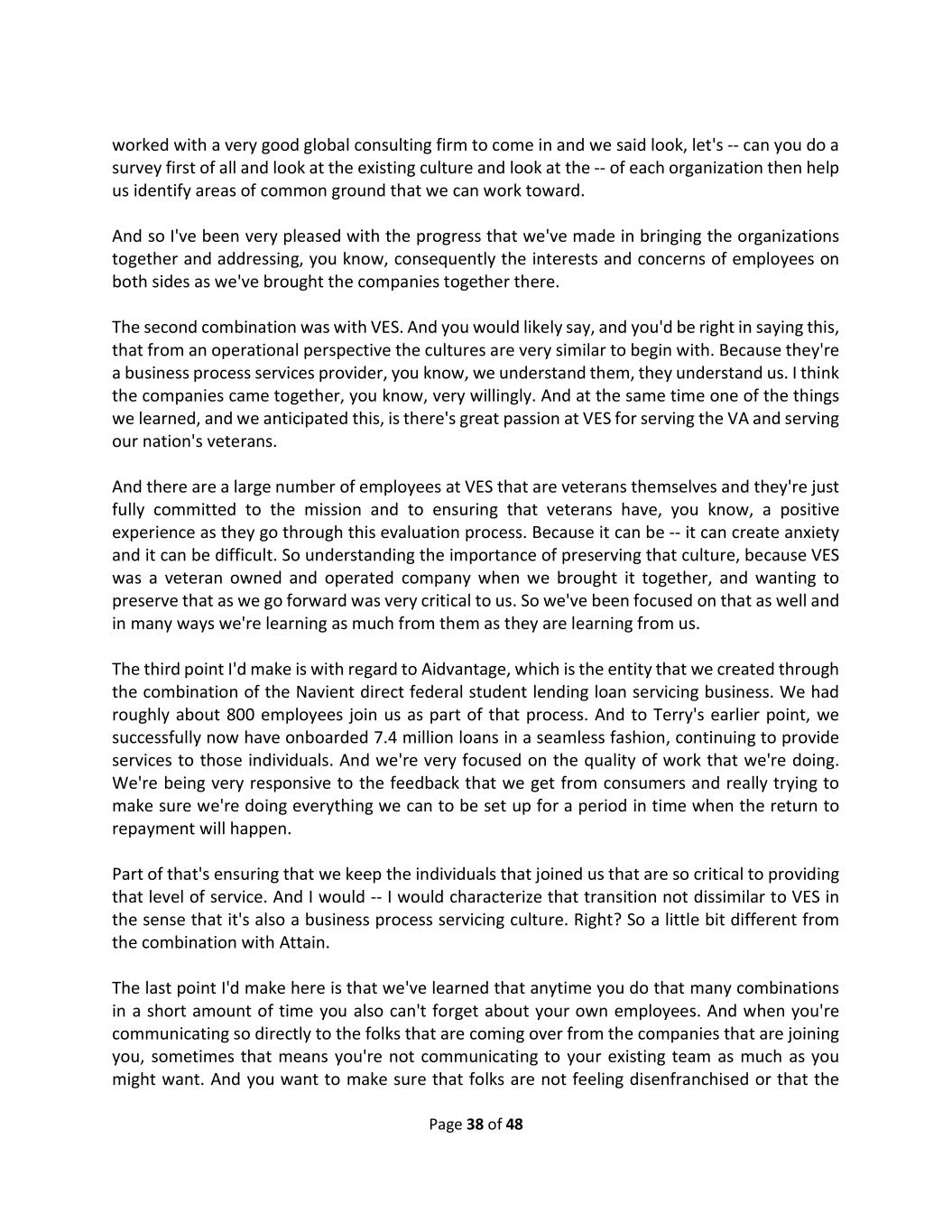
Page 38 of 48 worked with a very good global consulting firm to come in and we said look, let's -- can you do a survey first of all and look at the existing culture and look at the -- of each organization then help us identify areas of common ground that we can work toward. And so I've been very pleased with the progress that we've made in bringing the organizations together and addressing, you know, consequently the interests and concerns of employees on both sides as we've brought the companies together there. The second combination was with VES. And you would likely say, and you'd be right in saying this, that from an operational perspective the cultures are very similar to begin with. Because they're a business process services provider, you know, we understand them, they understand us. I think the companies came together, you know, very willingly. And at the same time one of the things we learned, and we anticipated this, is there's great passion at VES for serving the VA and serving our nation's veterans. And there are a large number of employees at VES that are veterans themselves and they're just fully committed to the mission and to ensuring that veterans have, you know, a positive experience as they go through this evaluation process. Because it can be -- it can create anxiety and it can be difficult. So understanding the importance of preserving that culture, because VES was a veteran owned and operated company when we brought it together, and wanting to preserve that as we go forward was very critical to us. So we've been focused on that as well and in many ways we're learning as much from them as they are learning from us. The third point I'd make is with regard to Aidvantage, which is the entity that we created through the combination of the Navient direct federal student lending loan servicing business. We had roughly about 800 employees join us as part of that process. And to Terry's earlier point, we successfully now have onboarded 7.4 million loans in a seamless fashion, continuing to provide services to those individuals. And we're very focused on the quality of work that we're doing. We're being very responsive to the feedback that we get from consumers and really trying to make sure we're doing everything we can to be set up for a period in time when the return to repayment will happen. Part of that's ensuring that we keep the individuals that joined us that are so critical to providing that level of service. And I would -- I would characterize that transition not dissimilar to VES in the sense that it's also a business process servicing culture. Right? So a little bit different from the combination with Attain. The last point I'd make here is that we've learned that anytime you do that many combinations in a short amount of time you also can't forget about your own employees. And when you're communicating so directly to the folks that are coming over from the companies that are joining you, sometimes that means you're not communicating to your existing team as much as you might want. And you want to make sure that folks are not feeling disenfranchised or that the
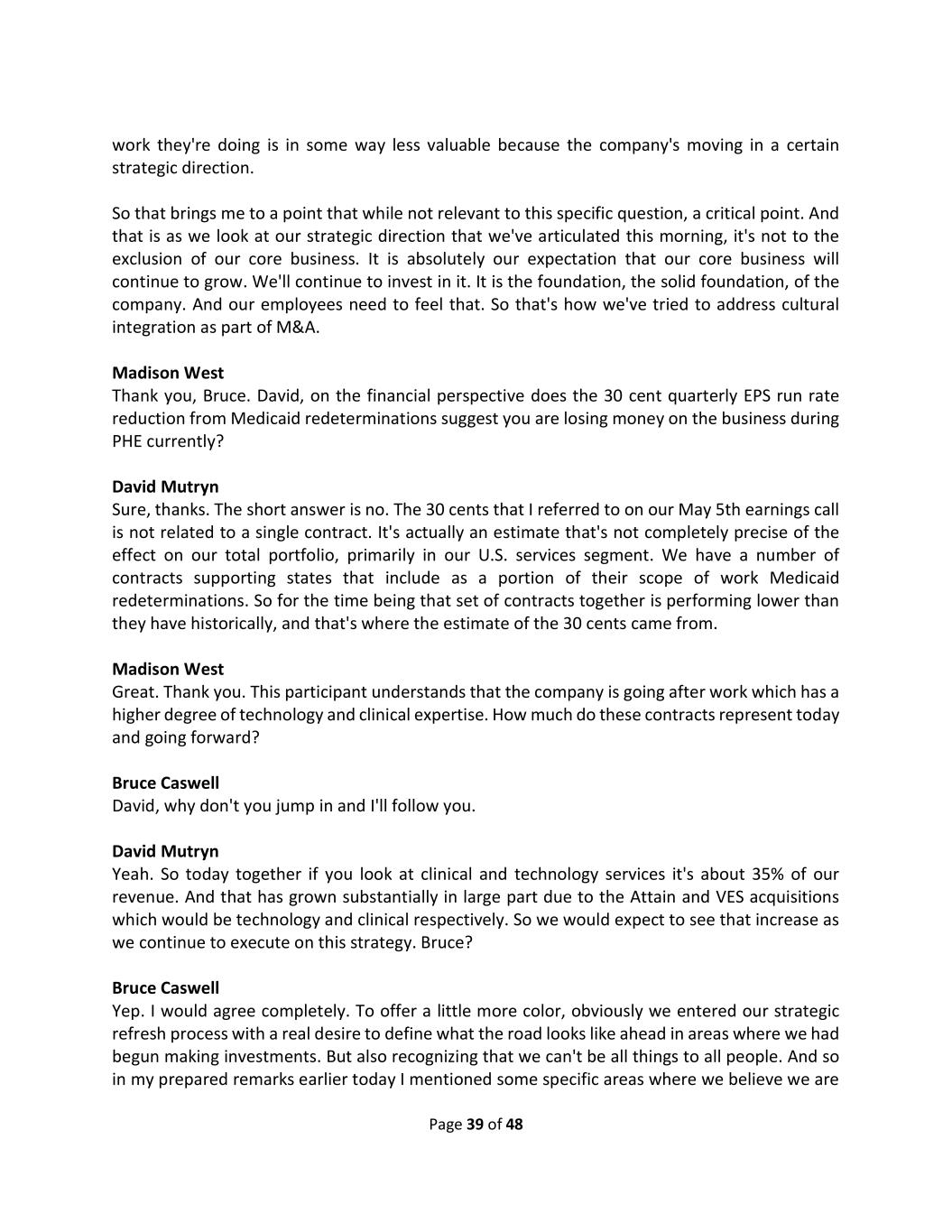
Page 39 of 48 work they're doing is in some way less valuable because the company's moving in a certain strategic direction. So that brings me to a point that while not relevant to this specific question, a critical point. And that is as we look at our strategic direction that we've articulated this morning, it's not to the exclusion of our core business. It is absolutely our expectation that our core business will continue to grow. We'll continue to invest in it. It is the foundation, the solid foundation, of the company. And our employees need to feel that. So that's how we've tried to address cultural integration as part of M&A. Madison West Thank you, Bruce. David, on the financial perspective does the 30 cent quarterly EPS run rate reduction from Medicaid redeterminations suggest you are losing money on the business during PHE currently? David Mutryn Sure, thanks. The short answer is no. The 30 cents that I referred to on our May 5th earnings call is not related to a single contract. It's actually an estimate that's not completely precise of the effect on our total portfolio, primarily in our U.S. services segment. We have a number of contracts supporting states that include as a portion of their scope of work Medicaid redeterminations. So for the time being that set of contracts together is performing lower than they have historically, and that's where the estimate of the 30 cents came from. Madison West Great. Thank you. This participant understands that the company is going after work which has a higher degree of technology and clinical expertise. How much do these contracts represent today and going forward? Bruce Caswell David, why don't you jump in and I'll follow you. David Mutryn Yeah. So today together if you look at clinical and technology services it's about 35% of our revenue. And that has grown substantially in large part due to the Attain and VES acquisitions which would be technology and clinical respectively. So we would expect to see that increase as we continue to execute on this strategy. Bruce? Bruce Caswell Yep. I would agree completely. To offer a little more color, obviously we entered our strategic refresh process with a real desire to define what the road looks like ahead in areas where we had begun making investments. But also recognizing that we can't be all things to all people. And so in my prepared remarks earlier today I mentioned some specific areas where we believe we are
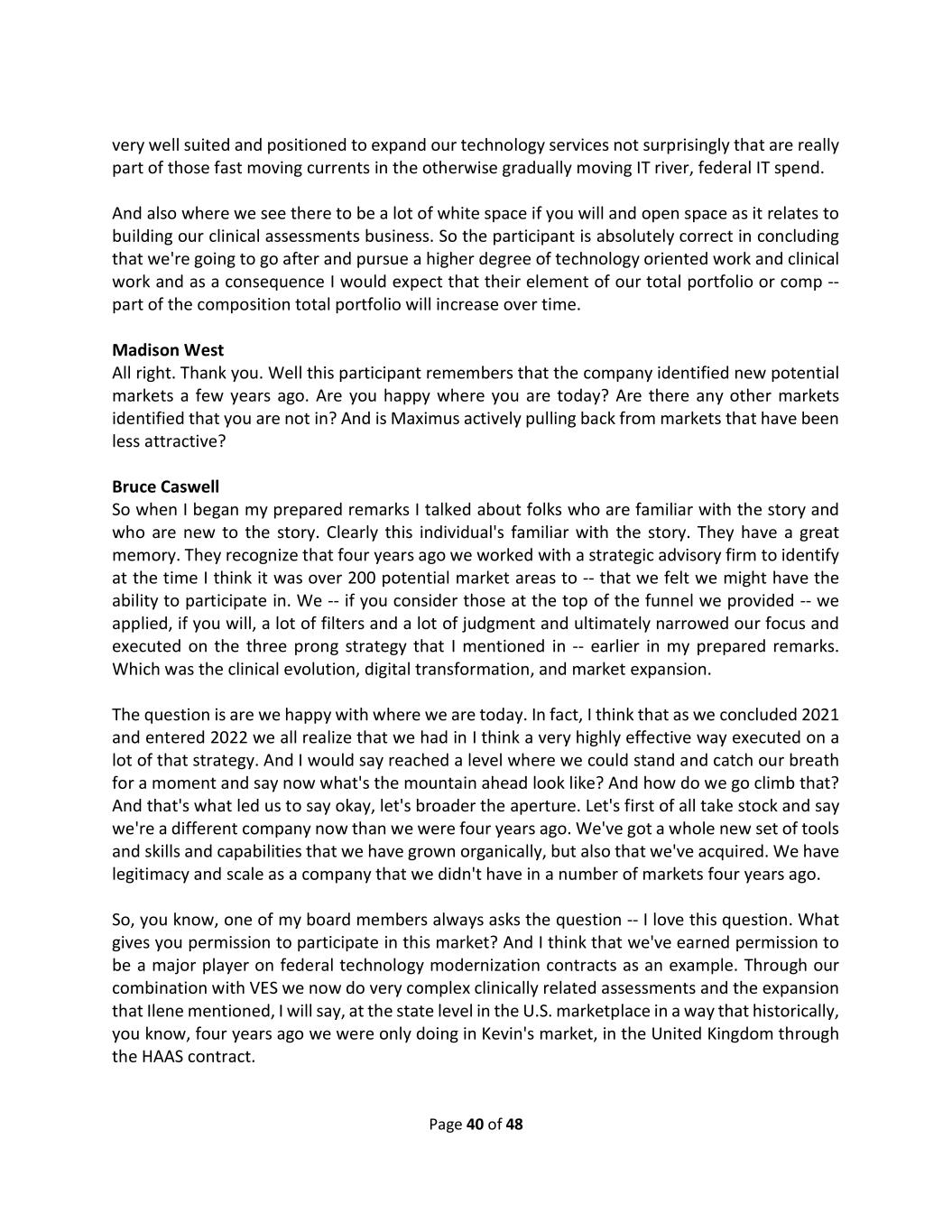
Page 40 of 48 very well suited and positioned to expand our technology services not surprisingly that are really part of those fast moving currents in the otherwise gradually moving IT river, federal IT spend. And also where we see there to be a lot of white space if you will and open space as it relates to building our clinical assessments business. So the participant is absolutely correct in concluding that we're going to go after and pursue a higher degree of technology oriented work and clinical work and as a consequence I would expect that their element of our total portfolio or comp -- part of the composition total portfolio will increase over time. Madison West All right. Thank you. Well this participant remembers that the company identified new potential markets a few years ago. Are you happy where you are today? Are there any other markets identified that you are not in? And is Maximus actively pulling back from markets that have been less attractive? Bruce Caswell So when I began my prepared remarks I talked about folks who are familiar with the story and who are new to the story. Clearly this individual's familiar with the story. They have a great memory. They recognize that four years ago we worked with a strategic advisory firm to identify at the time I think it was over 200 potential market areas to -- that we felt we might have the ability to participate in. We -- if you consider those at the top of the funnel we provided -- we applied, if you will, a lot of filters and a lot of judgment and ultimately narrowed our focus and executed on the three prong strategy that I mentioned in -- earlier in my prepared remarks. Which was the clinical evolution, digital transformation, and market expansion. The question is are we happy with where we are today. In fact, I think that as we concluded 2021 and entered 2022 we all realize that we had in I think a very highly effective way executed on a lot of that strategy. And I would say reached a level where we could stand and catch our breath for a moment and say now what's the mountain ahead look like? And how do we go climb that? And that's what led us to say okay, let's broader the aperture. Let's first of all take stock and say we're a different company now than we were four years ago. We've got a whole new set of tools and skills and capabilities that we have grown organically, but also that we've acquired. We have legitimacy and scale as a company that we didn't have in a number of markets four years ago. So, you know, one of my board members always asks the question -- I love this question. What gives you permission to participate in this market? And I think that we've earned permission to be a major player on federal technology modernization contracts as an example. Through our combination with VES we now do very complex clinically related assessments and the expansion that Ilene mentioned, I will say, at the state level in the U.S. marketplace in a way that historically, you know, four years ago we were only doing in Kevin's market, in the United Kingdom through the HAAS contract.
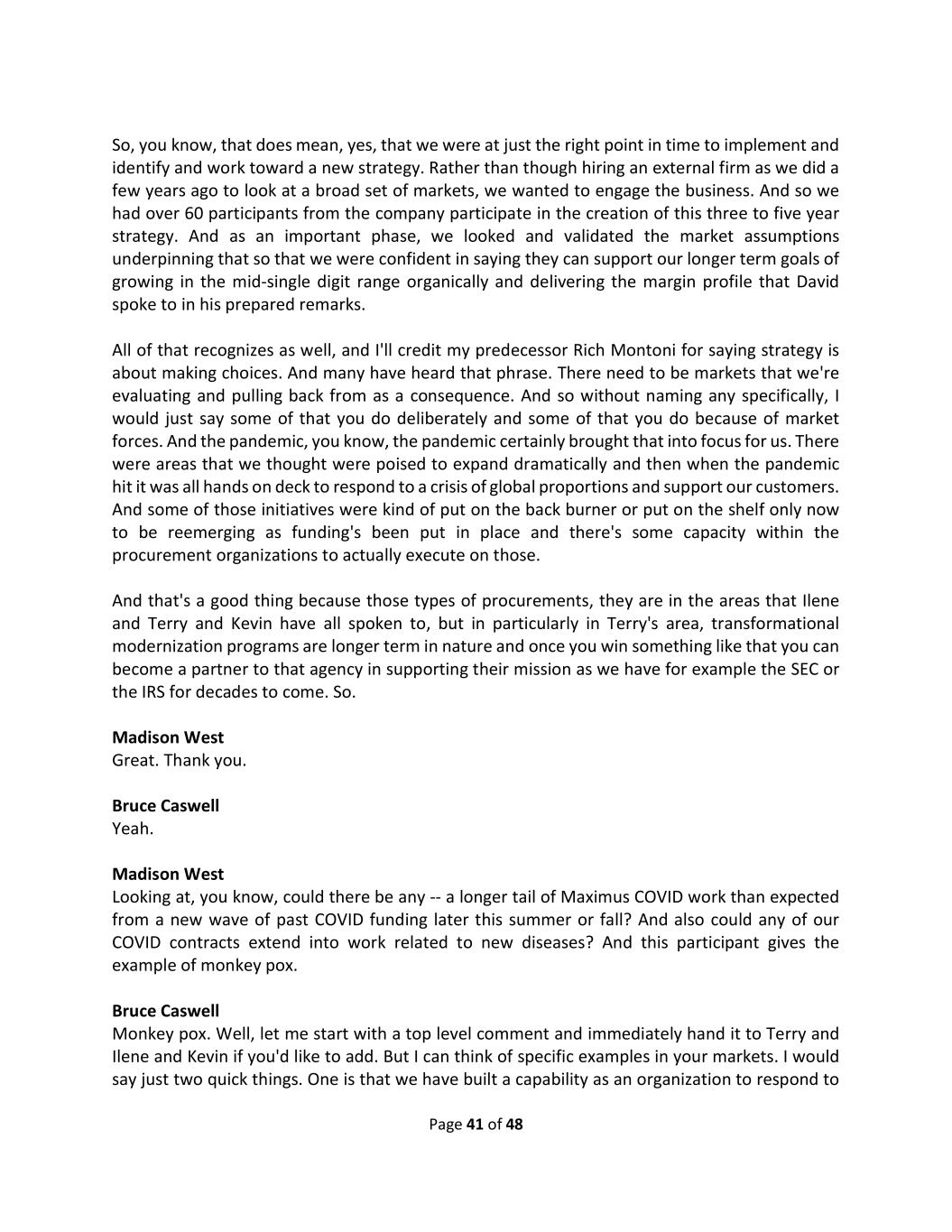
Page 41 of 48 So, you know, that does mean, yes, that we were at just the right point in time to implement and identify and work toward a new strategy. Rather than though hiring an external firm as we did a few years ago to look at a broad set of markets, we wanted to engage the business. And so we had over 60 participants from the company participate in the creation of this three to five year strategy. And as an important phase, we looked and validated the market assumptions underpinning that so that we were confident in saying they can support our longer term goals of growing in the mid-single digit range organically and delivering the margin profile that David spoke to in his prepared remarks. All of that recognizes as well, and I'll credit my predecessor Rich Montoni for saying strategy is about making choices. And many have heard that phrase. There need to be markets that we're evaluating and pulling back from as a consequence. And so without naming any specifically, I would just say some of that you do deliberately and some of that you do because of market forces. And the pandemic, you know, the pandemic certainly brought that into focus for us. There were areas that we thought were poised to expand dramatically and then when the pandemic hit it was all hands on deck to respond to a crisis of global proportions and support our customers. And some of those initiatives were kind of put on the back burner or put on the shelf only now to be reemerging as funding's been put in place and there's some capacity within the procurement organizations to actually execute on those. And that's a good thing because those types of procurements, they are in the areas that Ilene and Terry and Kevin have all spoken to, but in particularly in Terry's area, transformational modernization programs are longer term in nature and once you win something like that you can become a partner to that agency in supporting their mission as we have for example the SEC or the IRS for decades to come. So. Madison West Great. Thank you. Bruce Caswell Yeah. Madison West Looking at, you know, could there be any -- a longer tail of Maximus COVID work than expected from a new wave of past COVID funding later this summer or fall? And also could any of our COVID contracts extend into work related to new diseases? And this participant gives the example of monkey pox. Bruce Caswell Monkey pox. Well, let me start with a top level comment and immediately hand it to Terry and Ilene and Kevin if you'd like to add. But I can think of specific examples in your markets. I would say just two quick things. One is that we have built a capability as an organization to respond to
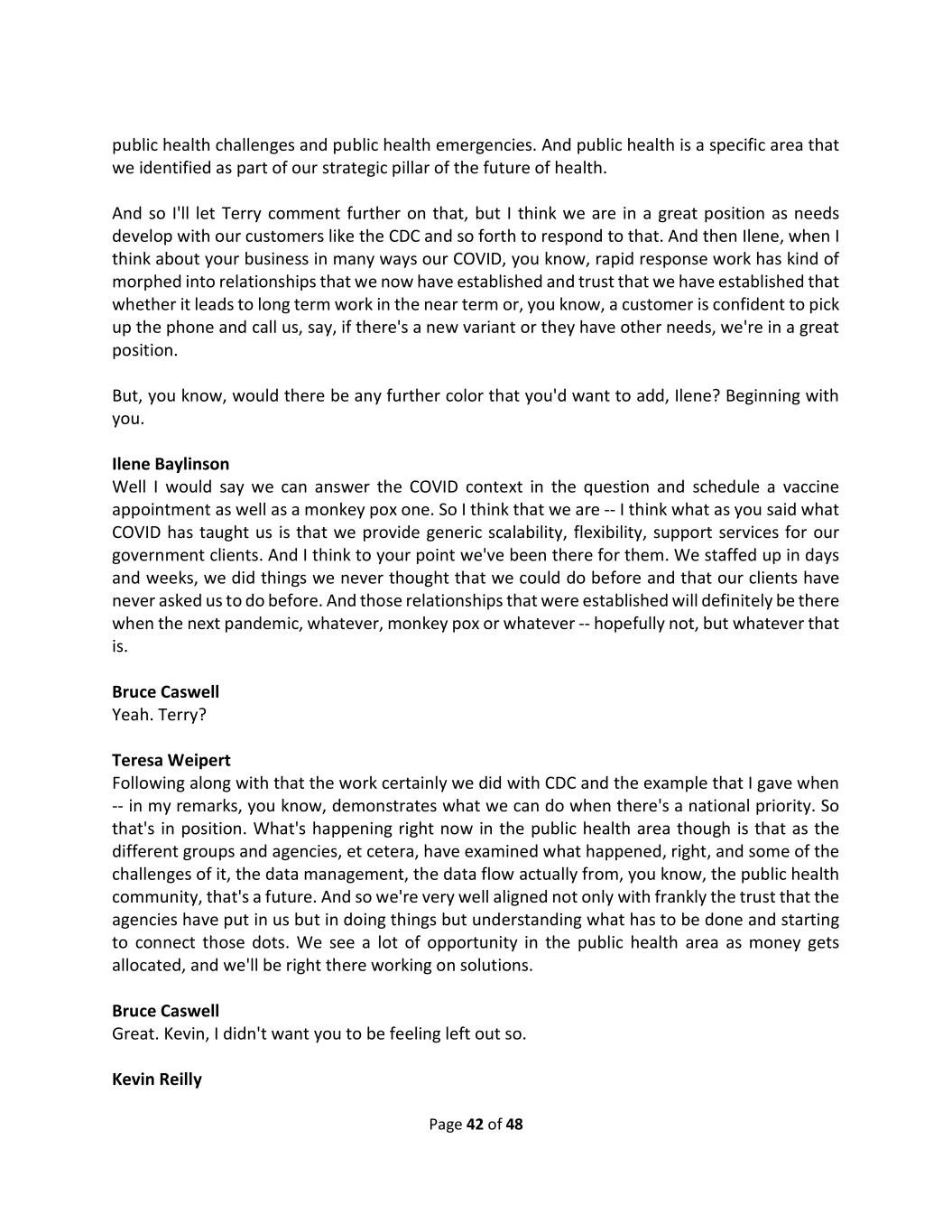
Page 42 of 48 public health challenges and public health emergencies. And public health is a specific area that we identified as part of our strategic pillar of the future of health. And so I'll let Terry comment further on that, but I think we are in a great position as needs develop with our customers like the CDC and so forth to respond to that. And then Ilene, when I think about your business in many ways our COVID, you know, rapid response work has kind of morphed into relationships that we now have established and trust that we have established that whether it leads to long term work in the near term or, you know, a customer is confident to pick up the phone and call us, say, if there's a new variant or they have other needs, we're in a great position. But, you know, would there be any further color that you'd want to add, Ilene? Beginning with you. Ilene Baylinson Well I would say we can answer the COVID context in the question and schedule a vaccine appointment as well as a monkey pox one. So I think that we are -- I think what as you said what COVID has taught us is that we provide generic scalability, flexibility, support services for our government clients. And I think to your point we've been there for them. We staffed up in days and weeks, we did things we never thought that we could do before and that our clients have never asked us to do before. And those relationships that were established will definitely be there when the next pandemic, whatever, monkey pox or whatever -- hopefully not, but whatever that is. Bruce Caswell Yeah. Terry? Teresa Weipert Following along with that the work certainly we did with CDC and the example that I gave when -- in my remarks, you know, demonstrates what we can do when there's a national priority. So that's in position. What's happening right now in the public health area though is that as the different groups and agencies, et cetera, have examined what happened, right, and some of the challenges of it, the data management, the data flow actually from, you know, the public health community, that's a future. And so we're very well aligned not only with frankly the trust that the agencies have put in us but in doing things but understanding what has to be done and starting to connect those dots. We see a lot of opportunity in the public health area as money gets allocated, and we'll be right there working on solutions. Bruce Caswell Great. Kevin, I didn't want you to be feeling left out so. Kevin Reilly
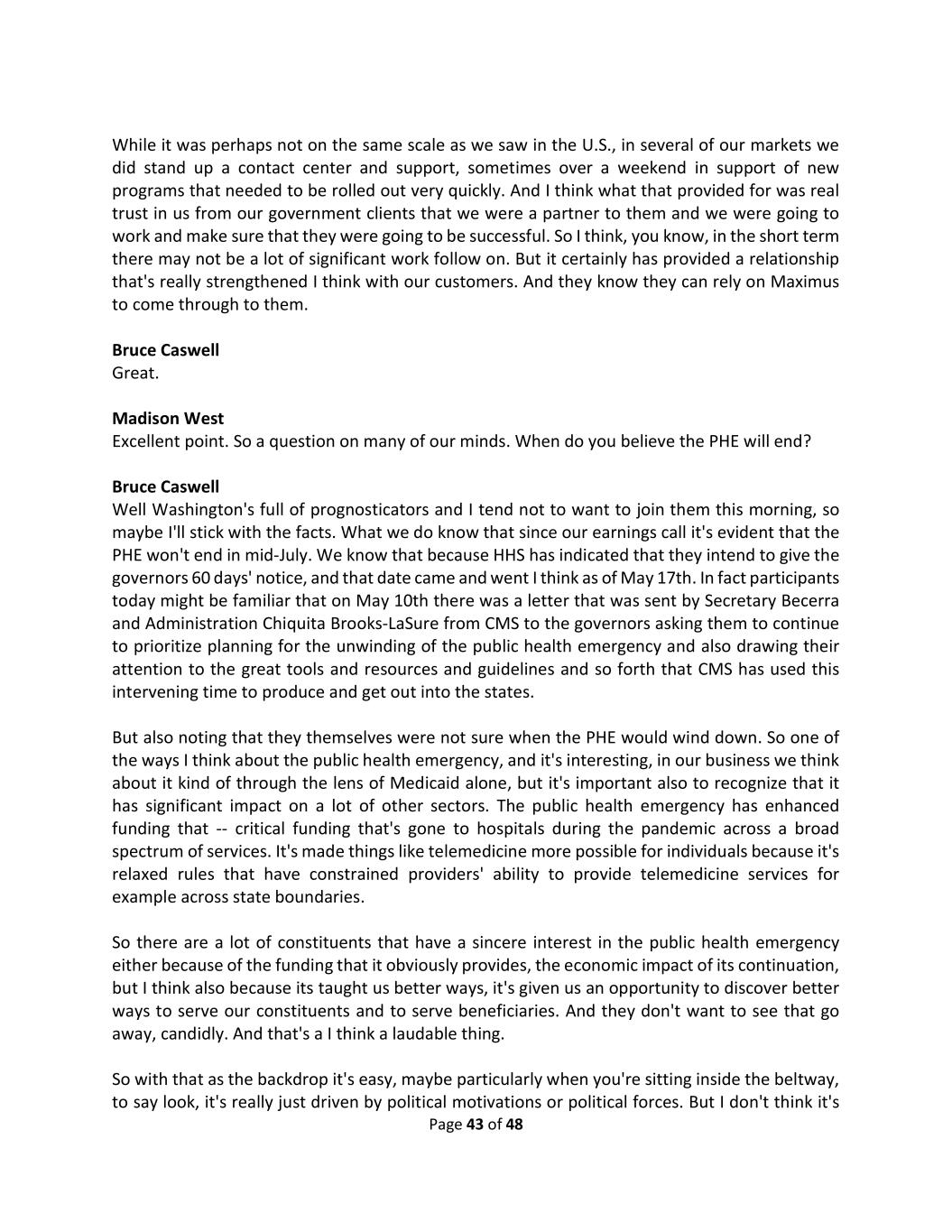
Page 43 of 48 While it was perhaps not on the same scale as we saw in the U.S., in several of our markets we did stand up a contact center and support, sometimes over a weekend in support of new programs that needed to be rolled out very quickly. And I think what that provided for was real trust in us from our government clients that we were a partner to them and we were going to work and make sure that they were going to be successful. So I think, you know, in the short term there may not be a lot of significant work follow on. But it certainly has provided a relationship that's really strengthened I think with our customers. And they know they can rely on Maximus to come through to them. Bruce Caswell Great. Madison West Excellent point. So a question on many of our minds. When do you believe the PHE will end? Bruce Caswell Well Washington's full of prognosticators and I tend not to want to join them this morning, so maybe I'll stick with the facts. What we do know that since our earnings call it's evident that the PHE won't end in mid-July. We know that because HHS has indicated that they intend to give the governors 60 days' notice, and that date came and went I think as of May 17th. In fact participants today might be familiar that on May 10th there was a letter that was sent by Secretary Becerra and Administration Chiquita Brooks-LaSure from CMS to the governors asking them to continue to prioritize planning for the unwinding of the public health emergency and also drawing their attention to the great tools and resources and guidelines and so forth that CMS has used this intervening time to produce and get out into the states. But also noting that they themselves were not sure when the PHE would wind down. So one of the ways I think about the public health emergency, and it's interesting, in our business we think about it kind of through the lens of Medicaid alone, but it's important also to recognize that it has significant impact on a lot of other sectors. The public health emergency has enhanced funding that -- critical funding that's gone to hospitals during the pandemic across a broad spectrum of services. It's made things like telemedicine more possible for individuals because it's relaxed rules that have constrained providers' ability to provide telemedicine services for example across state boundaries. So there are a lot of constituents that have a sincere interest in the public health emergency either because of the funding that it obviously provides, the economic impact of its continuation, but I think also because its taught us better ways, it's given us an opportunity to discover better ways to serve our constituents and to serve beneficiaries. And they don't want to see that go away, candidly. And that's a I think a laudable thing. So with that as the backdrop it's easy, maybe particularly when you're sitting inside the beltway, to say look, it's really just driven by political motivations or political forces. But I don't think it's
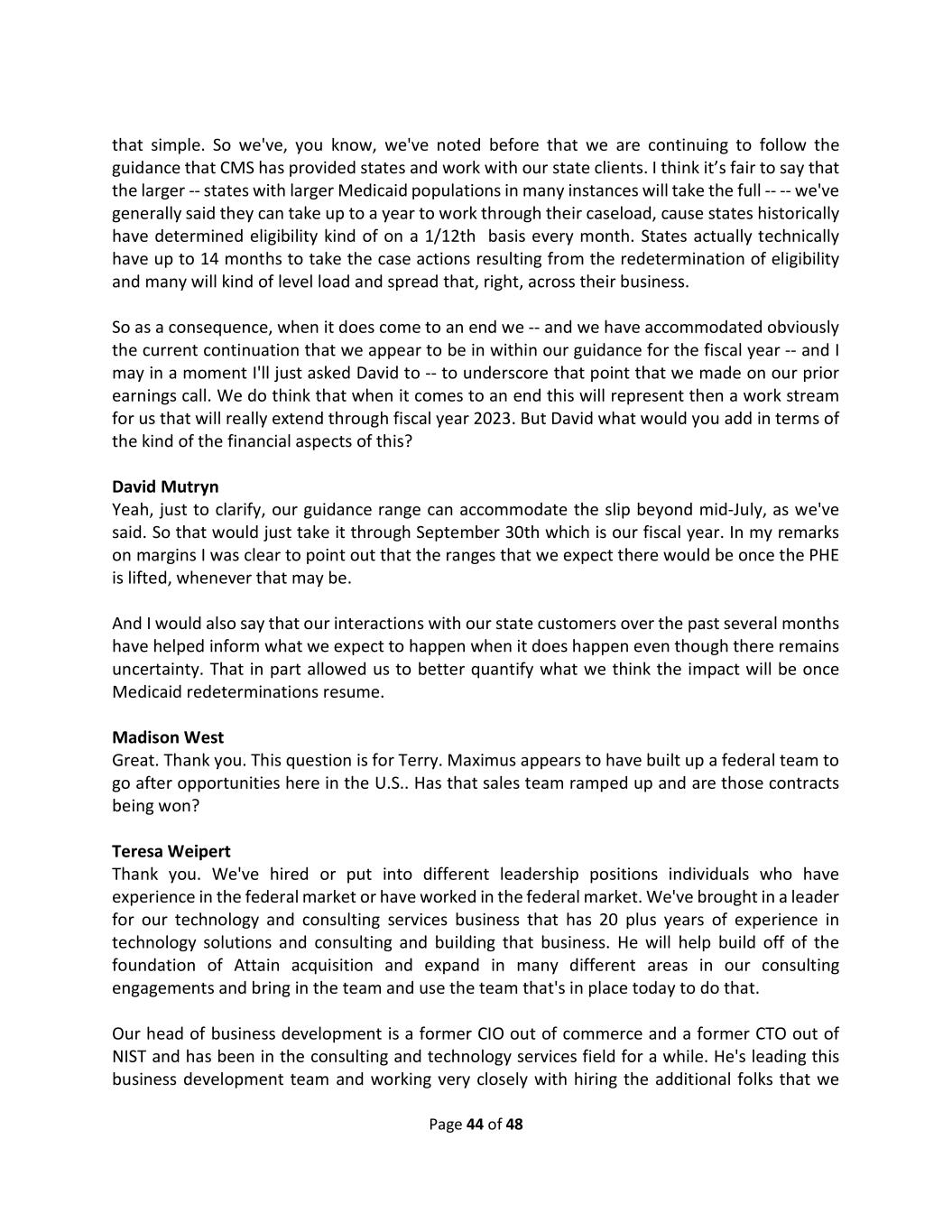
Page 44 of 48 that simple. So we've, you know, we've noted before that we are continuing to follow the guidance that CMS has provided states and work with our state clients. I think it’s fair to say that the larger -- states with larger Medicaid populations in many instances will take the full -- -- we've generally said they can take up to a year to work through their caseload, cause states historically have determined eligibility kind of on a 1/12th basis every month. States actually technically have up to 14 months to take the case actions resulting from the redetermination of eligibility and many will kind of level load and spread that, right, across their business. So as a consequence, when it does come to an end we -- and we have accommodated obviously the current continuation that we appear to be in within our guidance for the fiscal year -- and I may in a moment I'll just asked David to -- to underscore that point that we made on our prior earnings call. We do think that when it comes to an end this will represent then a work stream for us that will really extend through fiscal year 2023. But David what would you add in terms of the kind of the financial aspects of this? David Mutryn Yeah, just to clarify, our guidance range can accommodate the slip beyond mid-July, as we've said. So that would just take it through September 30th which is our fiscal year. In my remarks on margins I was clear to point out that the ranges that we expect there would be once the PHE is lifted, whenever that may be. And I would also say that our interactions with our state customers over the past several months have helped inform what we expect to happen when it does happen even though there remains uncertainty. That in part allowed us to better quantify what we think the impact will be once Medicaid redeterminations resume. Madison West Great. Thank you. This question is for Terry. Maximus appears to have built up a federal team to go after opportunities here in the U.S.. Has that sales team ramped up and are those contracts being won? Teresa Weipert Thank you. We've hired or put into different leadership positions individuals who have experience in the federal market or have worked in the federal market. We've brought in a leader for our technology and consulting services business that has 20 plus years of experience in technology solutions and consulting and building that business. He will help build off of the foundation of Attain acquisition and expand in many different areas in our consulting engagements and bring in the team and use the team that's in place today to do that. Our head of business development is a former CIO out of commerce and a former CTO out of NIST and has been in the consulting and technology services field for a while. He's leading this business development team and working very closely with hiring the additional folks that we
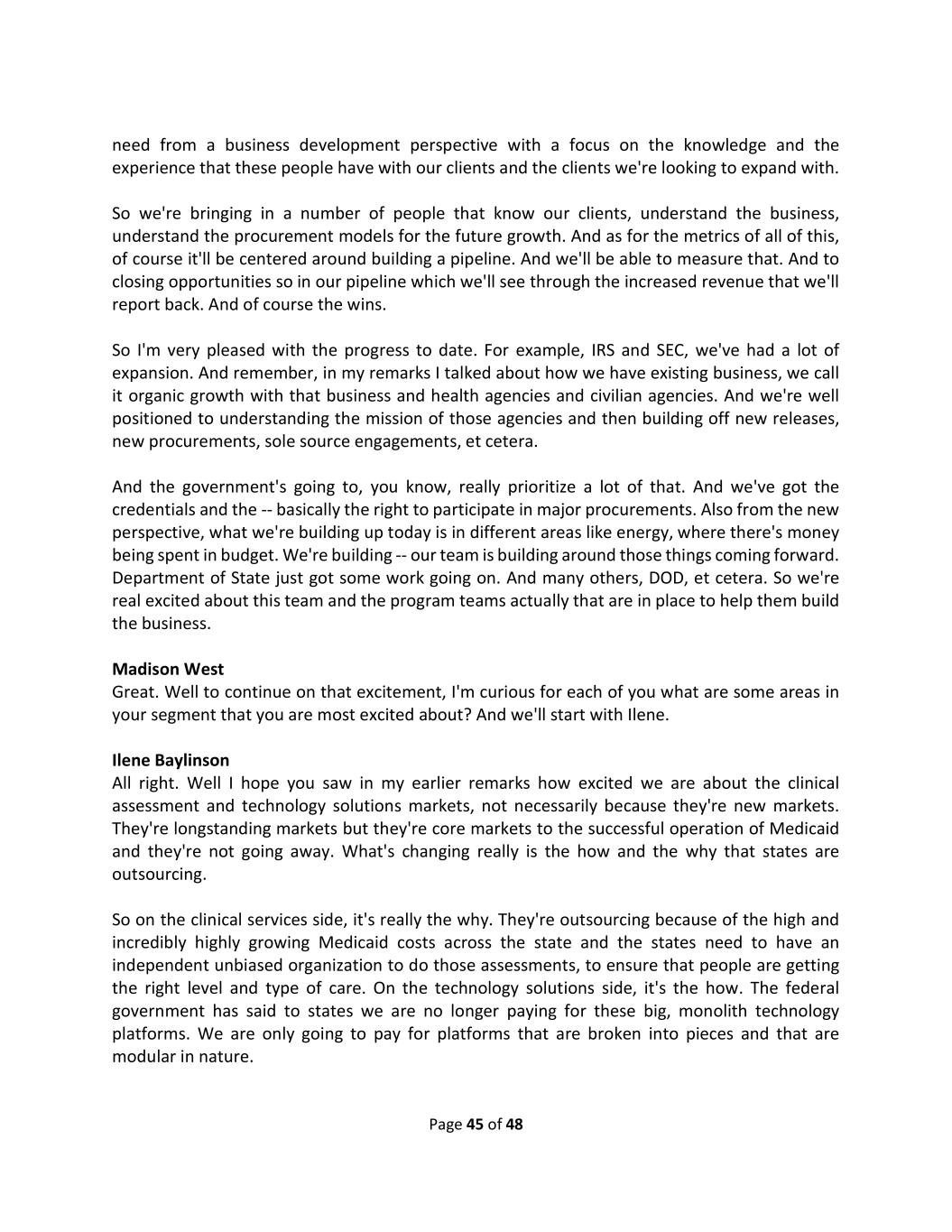
Page 45 of 48 need from a business development perspective with a focus on the knowledge and the experience that these people have with our clients and the clients we're looking to expand with. So we're bringing in a number of people that know our clients, understand the business, understand the procurement models for the future growth. And as for the metrics of all of this, of course it'll be centered around building a pipeline. And we'll be able to measure that. And to closing opportunities so in our pipeline which we'll see through the increased revenue that we'll report back. And of course the wins. So I'm very pleased with the progress to date. For example, IRS and SEC, we've had a lot of expansion. And remember, in my remarks I talked about how we have existing business, we call it organic growth with that business and health agencies and civilian agencies. And we're well positioned to understanding the mission of those agencies and then building off new releases, new procurements, sole source engagements, et cetera. And the government's going to, you know, really prioritize a lot of that. And we've got the credentials and the -- basically the right to participate in major procurements. Also from the new perspective, what we're building up today is in different areas like energy, where there's money being spent in budget. We're building -- our team is building around those things coming forward. Department of State just got some work going on. And many others, DOD, et cetera. So we're real excited about this team and the program teams actually that are in place to help them build the business. Madison West Great. Well to continue on that excitement, I'm curious for each of you what are some areas in your segment that you are most excited about? And we'll start with Ilene. Ilene Baylinson All right. Well I hope you saw in my earlier remarks how excited we are about the clinical assessment and technology solutions markets, not necessarily because they're new markets. They're longstanding markets but they're core markets to the successful operation of Medicaid and they're not going away. What's changing really is the how and the why that states are outsourcing. So on the clinical services side, it's really the why. They're outsourcing because of the high and incredibly highly growing Medicaid costs across the state and the states need to have an independent unbiased organization to do those assessments, to ensure that people are getting the right level and type of care. On the technology solutions side, it's the how. The federal government has said to states we are no longer paying for these big, monolith technology platforms. We are only going to pay for platforms that are broken into pieces and that are modular in nature.
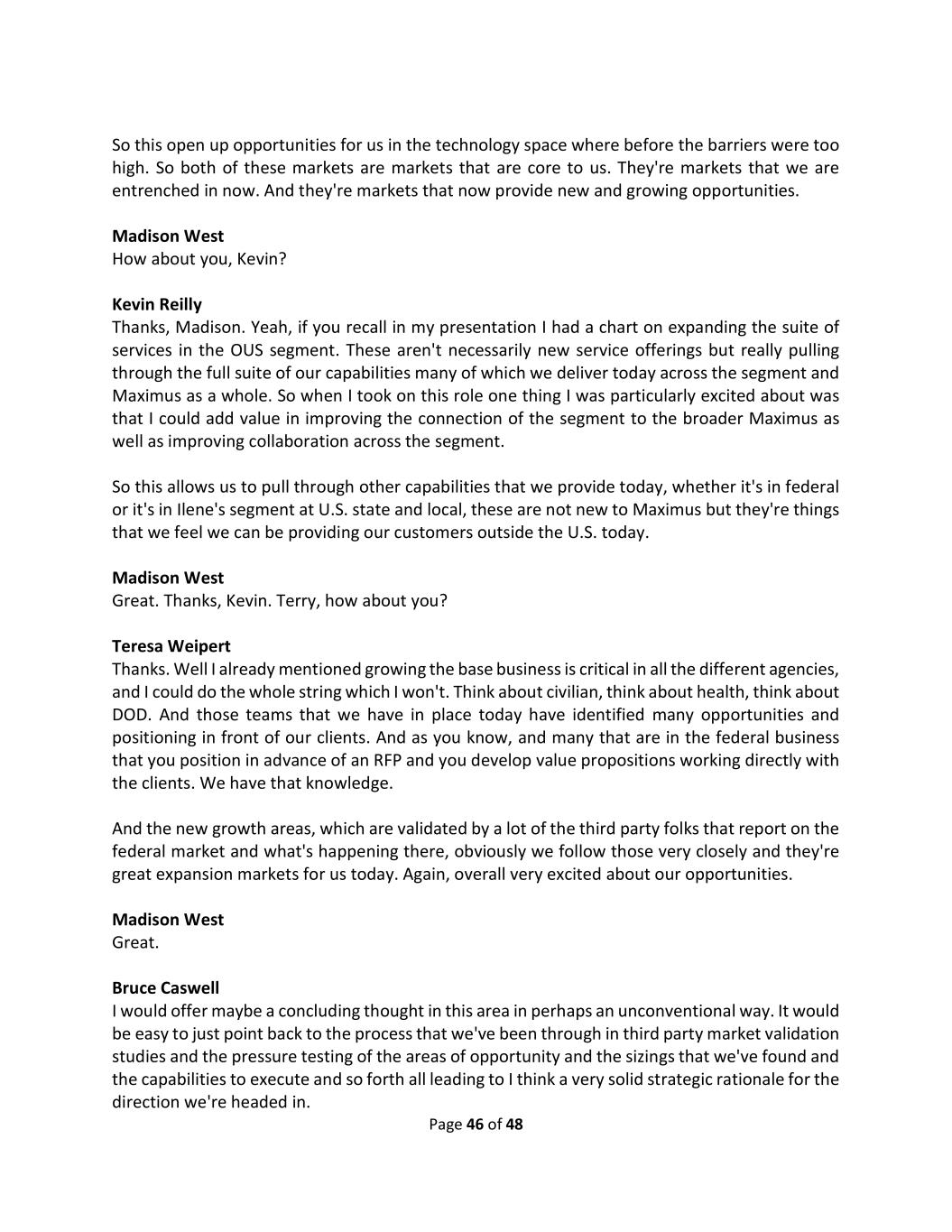
Page 46 of 48 So this open up opportunities for us in the technology space where before the barriers were too high. So both of these markets are markets that are core to us. They're markets that we are entrenched in now. And they're markets that now provide new and growing opportunities. Madison West How about you, Kevin? Kevin Reilly Thanks, Madison. Yeah, if you recall in my presentation I had a chart on expanding the suite of services in the OUS segment. These aren't necessarily new service offerings but really pulling through the full suite of our capabilities many of which we deliver today across the segment and Maximus as a whole. So when I took on this role one thing I was particularly excited about was that I could add value in improving the connection of the segment to the broader Maximus as well as improving collaboration across the segment. So this allows us to pull through other capabilities that we provide today, whether it's in federal or it's in Ilene's segment at U.S. state and local, these are not new to Maximus but they're things that we feel we can be providing our customers outside the U.S. today. Madison West Great. Thanks, Kevin. Terry, how about you? Teresa Weipert Thanks. Well I already mentioned growing the base business is critical in all the different agencies, and I could do the whole string which I won't. Think about civilian, think about health, think about DOD. And those teams that we have in place today have identified many opportunities and positioning in front of our clients. And as you know, and many that are in the federal business that you position in advance of an RFP and you develop value propositions working directly with the clients. We have that knowledge. And the new growth areas, which are validated by a lot of the third party folks that report on the federal market and what's happening there, obviously we follow those very closely and they're great expansion markets for us today. Again, overall very excited about our opportunities. Madison West Great. Bruce Caswell I would offer maybe a concluding thought in this area in perhaps an unconventional way. It would be easy to just point back to the process that we've been through in third party market validation studies and the pressure testing of the areas of opportunity and the sizings that we've found and the capabilities to execute and so forth all leading to I think a very solid strategic rationale for the direction we're headed in.
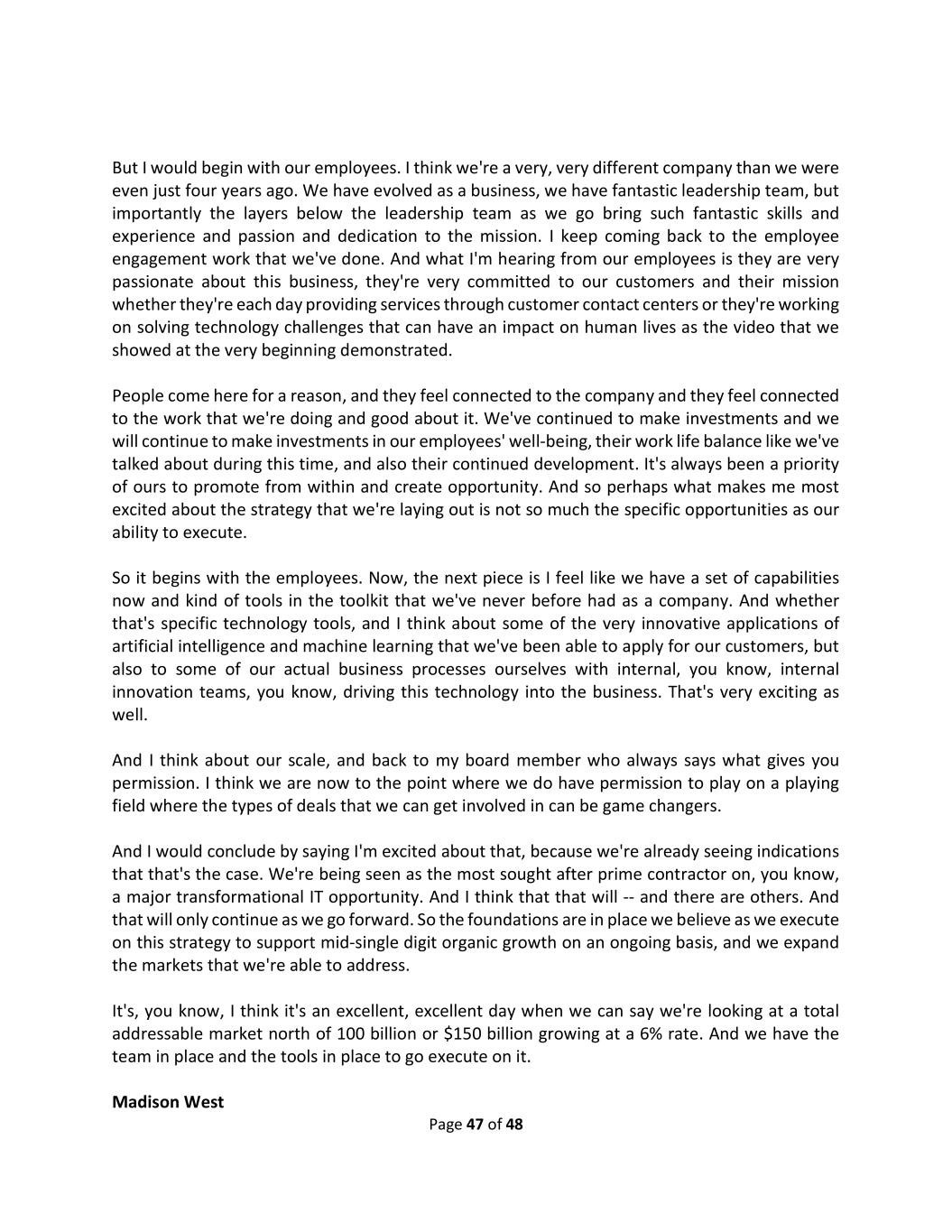
Page 47 of 48 But I would begin with our employees. I think we're a very, very different company than we were even just four years ago. We have evolved as a business, we have fantastic leadership team, but importantly the layers below the leadership team as we go bring such fantastic skills and experience and passion and dedication to the mission. I keep coming back to the employee engagement work that we've done. And what I'm hearing from our employees is they are very passionate about this business, they're very committed to our customers and their mission whether they're each day providing services through customer contact centers or they're working on solving technology challenges that can have an impact on human lives as the video that we showed at the very beginning demonstrated. People come here for a reason, and they feel connected to the company and they feel connected to the work that we're doing and good about it. We've continued to make investments and we will continue to make investments in our employees' well-being, their work life balance like we've talked about during this time, and also their continued development. It's always been a priority of ours to promote from within and create opportunity. And so perhaps what makes me most excited about the strategy that we're laying out is not so much the specific opportunities as our ability to execute. So it begins with the employees. Now, the next piece is I feel like we have a set of capabilities now and kind of tools in the toolkit that we've never before had as a company. And whether that's specific technology tools, and I think about some of the very innovative applications of artificial intelligence and machine learning that we've been able to apply for our customers, but also to some of our actual business processes ourselves with internal, you know, internal innovation teams, you know, driving this technology into the business. That's very exciting as well. And I think about our scale, and back to my board member who always says what gives you permission. I think we are now to the point where we do have permission to play on a playing field where the types of deals that we can get involved in can be game changers. And I would conclude by saying I'm excited about that, because we're already seeing indications that that's the case. We're being seen as the most sought after prime contractor on, you know, a major transformational IT opportunity. And I think that that will -- and there are others. And that will only continue as we go forward. So the foundations are in place we believe as we execute on this strategy to support mid-single digit organic growth on an ongoing basis, and we expand the markets that we're able to address. It's, you know, I think it's an excellent, excellent day when we can say we're looking at a total addressable market north of 100 billion or $150 billion growing at a 6% rate. And we have the team in place and the tools in place to go execute on it. Madison West

Page 48 of 48 Great. Well thank you all so much. This concludes our question and answer session for today. If we can help you with anything else please email us at IR@maximus.com. We are grateful for your participation. Thank you.